Save 40% off! Join our newsletter and get 40% off right away!

Sailboat Life
Sailboat Cruising and Lifestyle Magazine.

How to Live on a Sailboat for Beginners

This is a guide for how to live on a sailboat – but be warned, if you have any desire for the liveaboard lifestyle, you might quickly become on of us! Living aboard a sailboat requires an enjoyment of water, being okay with small living, and a sense of adventure. It’s not hard to begin living on a sailboat, but a few tips can help.
Let’s consider a few basic liveaboard questions first:
Is it living on a sailboat a good idea?
Living aboard a sailboat give you freedom that you won’t find in any other lifestyle. A suburban house can not be moved from place to place. But living on a sailboat gives you the options to live anywhere – literally in any country in the world! Living aboard a sailboat offers such a unique feeling of freedom to explore that you won’t find anywhere else.
Is living on a sailboat hard?
It is tough to live on a sailboat in a place like San Francisco where everyone is trying to escape super-high rent. In resort areas, many marinas have years-long waitlists for a liveaboard slip, and these slips cost double than a regular slip. However, not all places, in fact most places are easy to liveaboard.
Are you thinking about living aboard? Well, it takes time, planning, and preparation to being living on a sailboat. Here are a few videos to help you make a few calculations.
Adjusting to Liveaboard Life
Today, Emily sits down with 3 other female friends in the harbor to chat about how they transitioned from being landlubbers to liveaboard sailors in recent years. We’ll let you in on the conversation, and 4 different perspectives (though there are MANY others in the world).
- Emily, 34, aboard Temptress – liveaboard for 5 years
- Kris, 57, aboard Sixth Girl – liveaboard for 1 year
- Meredith, 44, aboard Tla Hla – liveaboard for 3 years
- Hannah, 26, aboard Sojourner – liveaboard for 2 years
How to Afford and Start Living Aboard
Your dream is to become a liveaboard? You want to know more about sailboat life, and what it means to live on a sailboat? You want to know how to afford living on a sailboat and how to afford staying liveaboards? How it feels to daily hoist the sail and follow the wind?
Start Small, Start Now
One philosophy in getting started living aboard a sailboat is to start small, start now. That doesn’t mean you have to buy a major refit project of a sailboat. You can get started in a small 24 foot single cabin boat for less than $10,000 or a mid-size 36 foot sailboat (see video below) for less than $60,000. Or grab a 1980s fixer upper that’s 42 feet in length that costs $25,000 – but beware, a fixer upper is a major expense even when you do it yourself.
Is Living Aboard for You?
No one can answer this question except you. However, if you enjoy freedom, have a sense of adventure, and love the water, then you might enjoy living aboard a sailboat.
We hope you enjoyed this how to guide for life on a sailboat for beginners. Leave us a comment or question a below.
Share this post!
Throw in your two cents, start a discussion cancel reply, related articles.

The Voyage of the Sea Star – 35ft Sloop to Bermuda

Living Aboard a 30-36ft Sailboat: A Guide for the Curious and Adventurous

Summer Sailboat Video, Bikinis, Sails, and Fun

Saved Up For This Dream

Sailboat Living: 10 Things To Know Before Moving On Board
Sailboat living can sound like the dream life, and in many ways it is.
Beautiful sunsets, the freedom to travel with your home, dolphins and crystal clear seas are all a huge part of the sailboat lifestyle , but anyone who tells you it’s an easy life has obviously never really lived on a sailboat!

There are times when sailboat living can feel more like a nightmare than a dream, and no matter how much you prepare there will always be a few troublesome scenarios that you just can’t predict.
However, with a little forethought and a lot of planning, there is a lot you can do to make the transition of moving from a house to a sailboat a relatively easy one.
If you’re prepared to put in the hard work now then we promise you will reap the rewards in the future. As we learnt the hard way, we’ve put together the top 10 things that everyone should know before they move onto a sailboat so that sailboat living for you can be 98% dream and only 2% nightmare!
As an Amazon Associate, we earn from qualifying purchases. We also earn from other affiliate programs. This means we may receive a small commission on products purchased through our links at no extra cost to you.
#1 A Sailboat Is Never Complete
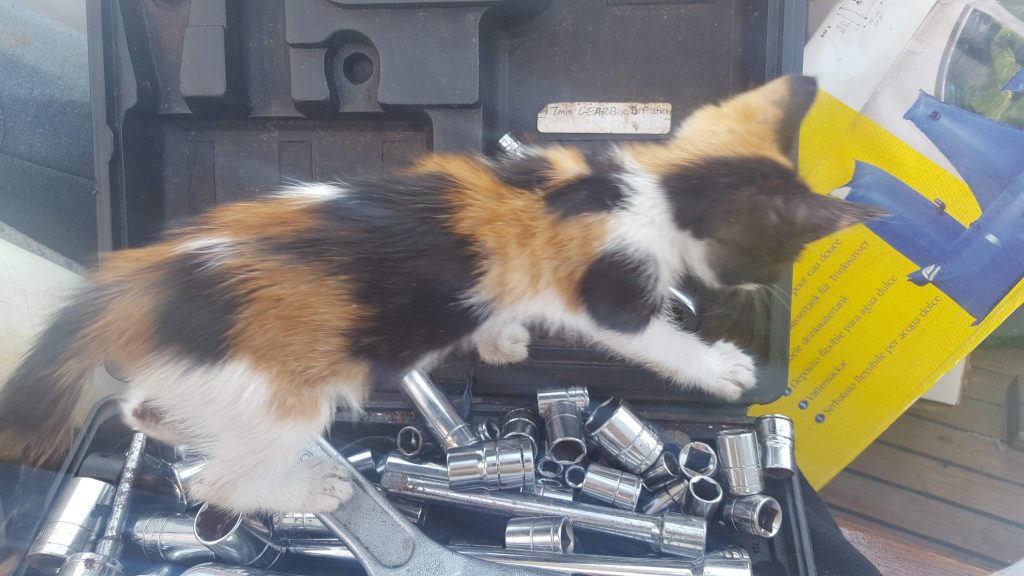
Learn this lesson fast!
Don’t expect to finish boatyard work and stop working. A sailboat breaks. Constantly. Some days it will feel as though your to-do list is endless because unfortunately, it is.
This was one of the things Adam and I were prepared for before we moved onboard our sailboat. After living on a boat in the UK we understood the crazy amount of work that has to go into maintaining something that’s constantly working.
I think a good way of looking at it would be to think of it as a house and a car combined. It has all the working parts of a house – the pipework, the electricity, the leaky windows etc.
It also has all the working parts of a car like an engine, the tires could be the sails, the lines, and all that goes along with them.
Add to that the fact that you’re putting it under huge amounts of stress at all times, in some extreme weather conditions, and you can see why things constantly fail!
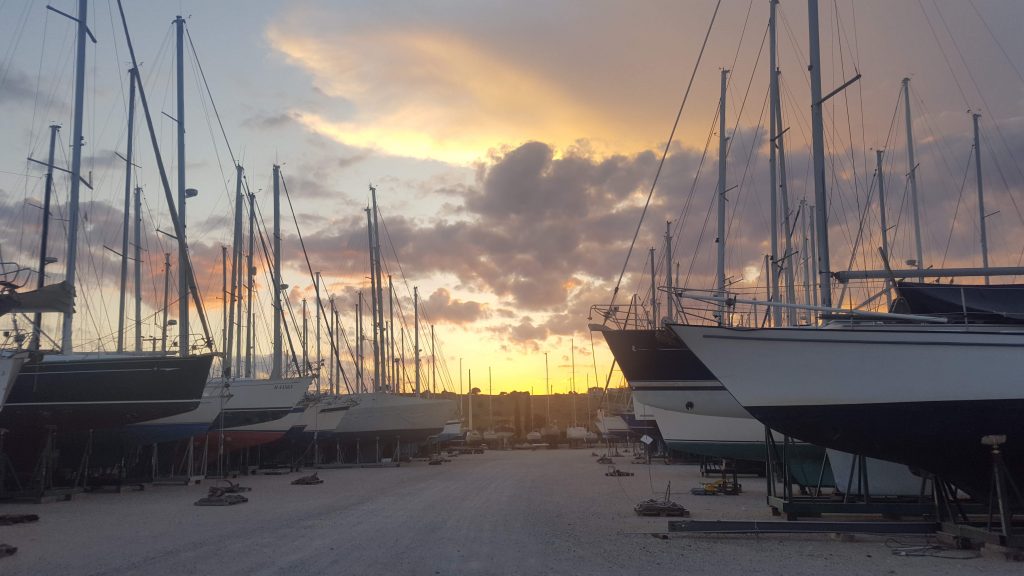
Adam and I spent the first few months of living aboard feeling as though we were just sailing from anchorage to anchorage to find chandlers so we could fix things. We made friends with some full-time cruisers who quickly put a stop to that!
They explained how if we actually wanted to enjoy time on board then we had to give ourselves time off the boat work. The broken things we could live with could wait a few days while we enjoyed a new destination.
Find out how much new sails cost
We now try to only do one or two days of boat work a week, which leaves us with a weekend ‘off’ when we’re working our jobs for three days. This suits us perfectly, but you’ll need to find a pattern that works for you to make sailboat living more enjoyable!
A bonus of living onboard is that you do have the extra time to dedicate to keeping the sailboat in tip-top condition.
Many weekend sailors find themselves with a long list of jobs at the end of the season, but (depending on how cheap/how lucky you get when you buy your boat!) if you get some jobs done every now and again through the season you’ll keep the long stints to a minimum.
#2 Sailboat Living = Tiny Space Living

Think of sailboat living as living in a glorified tent and you’ll be (partly) prepared! There is nothing glamorous about sailboat living!
You’ll be getting changed in tiny spaces where you may or may not be able to stand. You’ll be squeezing into the toilet or squeezing past people to use the kettle. It’s a juggling act, even when all your belongings are stashed away neatly.
Add to that the fact you’ll probably be ripping open cupboards every other day to find that essential item that was placed under all the other essential items and it becomes pretty hard to manage!
Our top tips for managing space onboard your sailboat are to downsize before you move in and to prioritise sailboat storage. It might be a hard thing to do to start with, but you’ll be so thankful you gave up all nonessential items before you even moved aboard.
It’s amazing how quickly you can fill a boat when you live on it! We have loads of handy tips on how to maximise limited space in our post on sailboat storage ideas – check it out before you start sailboat living!
#3 Water, Water, Everywhere But Not A Drop To Wash In

Get used to living frugally. We don’t necessarily mean your finances (though it is possible to live on a budget on a sailboat, check out what we spend monthly here).
Things like water and electricity are limited on a sailboat, especially if you’re spending the majority of your time at anchor.
Unless you have a sailboat watermaker (which we highly recommend splashing out on!) you need to get used to using as little water as possible . It’s not always easy to find when you live on the sea.
Get used to taking sea showers and washing dishes in saltwater. You can always rinse in freshwater, and washing in the sea really isn’t too hard once you’re used to it!
Set your sailboat up with a good way of making electricity as soon as you move aboard. You’ll want decent amounts of solar power and possibly a wind generator too, especially if you’re planning on spending time in countries that don’t see very much sunshine or spending winters at anchor.
You’ll also want to make sure you have a good battery bank for storing it over night, and you may even want to consider getting a small generator if you rely on power for things like charging laptops to work from.
#4 The People You Meet Will Be A True Highlight
The sailing community is what makes sailboat living. They are the most giving and generous community of people we have ever met and the best memories we have are the ones we spent with other cruisers.
It’s not always easy to meet other sailors while you’re living at anchor, so our advice is to make the effort and say hi where ever possible. People are always happy to share a drink or dinner, and a salty tale or two!
Meeting other sailors is also the very best way to learn more about sailing life. No matter how long people have cruised for they always have an experience worth sharing and learning from.
#5 The Weather Controls Your Life In Sailboat Living

We check the weather twice a day, every day. It may seem obvious that the weather is important on a sailboat, but until we moved aboard we didn’t realise quite how much it would affect our lives.
You might be desperate to move the boat and explore somewhere new but find you have no wind to sail. Or you might fall in love with an anchorage and want to stay but be forced to move because of a change in the direction of the wind.
We’ve had to leave beautiful anchorages in the middle of the night because an unpredicted storm had blown through, or been stuck in places we don’t like because the wind has meant it’s the only safe place to be.
The positives of being governed by the weather is that you’re so much more in tune with it. You get up when the sun rises, you notice subtle changes in the temperature and you learn to read the wind and clouds.

Before you move on board you should start checking the weather and anchorages around where you plan on sailing. It makes life easier if you’ve scouted out the best places to be in different weather conditions.
Check things like whether there are safe anchorages for different wind directions or whether you’ll need to use marinas (and how much they’ll be!), and check if there are any ‘bolt holes’ you can use as safe havens in the event of unexpected storms.
You’ll feel more confident and comfortable if you have all this information to hand when you start sailboat living.
#6 Sailboat Living Means Leaving Your Privacy On The Dockside
You’ll be sharing a tiny space with your crew and they will quickly learn literally everything there is to learn about you. And you them.
Before you move onto a sailboat make sure that you’re happy with sharing everything with the people you’re sailing with. I don’t mean you have to tell them about your childhood (though night passages can be pretty dull!) but be prepared to share what you eat, when you toilet, potentially what you throw up.
Expect to be walked in on while you’re changing or showering. Understand that boat toilets break – a lot – so no matter how careful you are you might well end up elbow deep in someone else’s last nights dinner!
#7 Learn To Work As A Team – Quickly
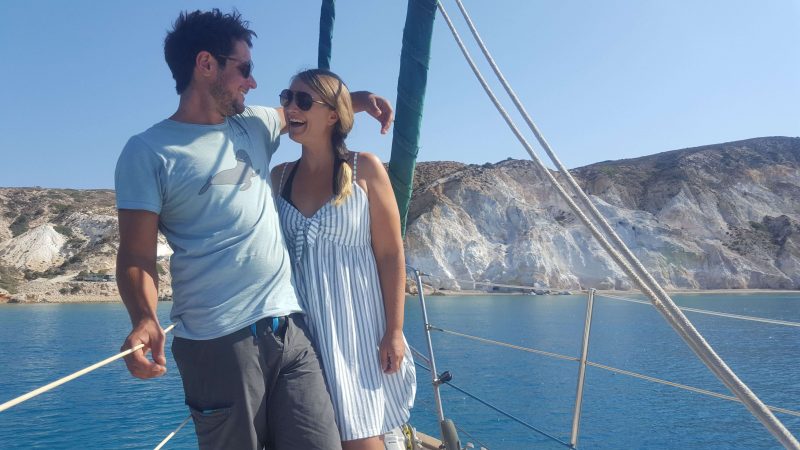
Sailboat living requires a huge amount of team work (unless you’re planning on living alone of course). You need get into a very different mindset when you live and work with the same person or people day in, day out, and when you depend on them (quite literally) to survive.
One of the biggest reasons that people quit at sailboat living is because they fall out with their partners, or call it a day before they do. Sailboat living is hard on relationships, but it can also make your relationship better and stronger if you’re prepared to work at it.
There are lots of things you can do to prepare for this change and I’ve put together a whole range of tips to help you with spending too much time with your partner .
Ultimately, one of the best things you can do is know that this isn’t going to be easy, no matter how strong your relationship is on land. Be prepared for this as a couple, and be prepared to work hard on your relationship when the tough patches come!
#8 Nature Is Incredible

I know, I know, we all know nature is incredible. But sailboat living brings you so much closer to it in so many different ways.
You see things you’d never get a chance to see on land. Every time you jump in the sea you find new sea creatures, either from snorkeling or finding them clinging on to your hull, or washed up on deck.
You see turtles, whales and rays. Birds come to find rest on your boat while you’re on long passages and dolphins swim beside you as you make waves for them to play in.

Then there’s the sunrises and sunsets, and the endless starlit skies. The thunderstorms that you’re suddenly a part of, when before you could hide inside brick walls. The constantly changing sea and sky, and the sun and wind. You become part of it, and you depend on it, and you’re terrified of it.
Sailboat living makes you feel like you’re part of the nature around you rather than just a lucky spectator. It’s certainly changed the way I see the ocean and the weather for the better and I have a new found respect and healthy fear of it’s power and awe.
#9 Prepare For Sleepless Nights

Before we set off cruising full time I had no idea how little sleep I would get. There are so many different things trying their hardest to ruin a good nights sleep on a sailboat.
Firstly, the weather. If it’s windy, you’ll be half awake all night just watching the anchor and wondering if this will be the night it pulls out and you drag into some rocks.
You’ll be waiting for the wind to shift slightly so that you’re no longer protected from the sea. And even if you’re super happy with your anchoring set up, the wind through the halyards makes a very disconcerting noise!
If the weather is calm that doesn’t mean the sea will be. You can never predict whether the anchorage you arrive in will be the rollyest place on the island, so you’ll spend a good few nights just rolling around all over the place trying your hardest to stay in your berth.

Then there’s the heat (or the cold, depending on where you sail). It can be unbearably hot inside a sailboat, so consider buying a decent hammock and sleep under the stars instead.
But if you decide to sleep outside you’re going to want a mosquito net, because those things are FIERCE. Never have I ever experienced so many sleepless nights due to a buzzing in my ears and painful bites all over my legs.
If you can find a comfortable set up with your hammock and mozzie net then sleeping outside on a sailboat is one of the most magical things ever. The stars are brighter than you could ever imagine, and there are shooting stars a plenty. The stillness of a calm night at anchor is one of the very best things about sailboat living.
If you’re sailing with a baby you can expect even less sleep – make sure you’re prepared for that!
#10 Sailboat Living Is More Difficult Than You Could Imagine (But Totally Worth It)

Difficult sounds bad, but that would be inaccurate when describing sailboat living. It’s the hardest thing I’ve ever done and the best. And part of what makes it the best is that it’s the hardest. Does that make sense?!
Sailboat living can feel like a constant battle at times. You have to trek for an hour to find the gas to light your oven to make a cup of tea in the morning. You then have to go back again because you forgot the tea bags. Things break and need fixing. You can’t sleep because of a storm. You can’t leave the boat for days because the winds up and you’re scared the anchor might pull out.
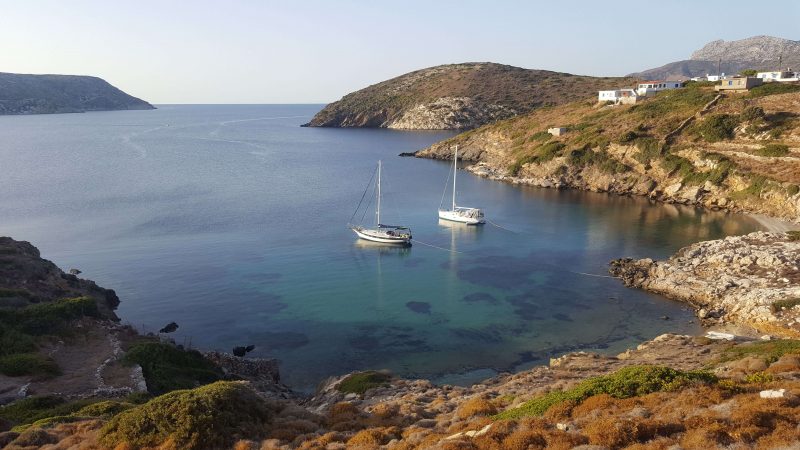
I think people run away to sea to find freedom, but like everything freedom can be defined in so many different ways.
Sailboat living takes away your freedom of easy access to food and water. It takes away your freedom to step out of your front door into relative safety. At times it even takes away your freedom to run and walk.
What it does give you is freedom from monotony. Freedom from daily routine. It gives you the freedom to travel where you want (if not when you want) and the freedom from material possessions.
It doesn’t matter what you wear on a boat, it doesn’t matter how flashy your boat is or how much you smell! At the end of the day, out on the sea, it’s just you surviving. And in a way, that’s the most free I’ve ever felt.

Similar Posts

How Long Do New Sails Last?
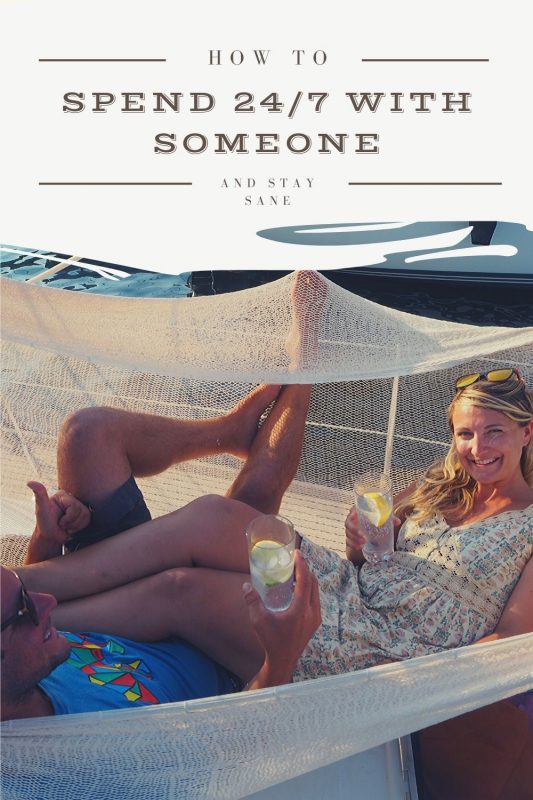
How To Cope With Spending Too Much Time With Your Partner

Top Quality Winter Sailing Jackets 2024

Lateen Sails – What Are They And Why Are They Important?

The 15 Best Sunglasses For Sailing 2024

Sailing Greece In October: Why You Should Go
15 comments.
I’ll be moving on a sailboat with my girlfriend this (still very new) year and I discovered your blog via Pinterest. We’re also writing weekly blog posts about our journey. Your writing is excellent, and I’d like to follow you on your mailing list. But it seems your form does not work. Fix it maybe? 🙂
Ah that’s strange! I can see people are still signing up, will have a look into that! Thanks for letting me know. Thanks so much for reading along. Where’s your boat? I’m so excited for you – those first few weeks aboard are the best!
I can’t seem to sign up for more. The web page has an error on my Android. Bummer.
Can you please add my email address to your email distribution list?
Thanks, Steve
So glad to come across you guys, finding out as much as we can before we take that leap. We are a couple coming to the end of a army career. The last 2 years will be in Kenya Nanyuki. Posted in June. Then we plan to get the dream sailing boat and travel. I am doing all my home work trying to find out as much as I can before we do this. Looking forward to reading about you both and tasking in everything any thing that we will I’m sure be incredible useful. Thank you Sandy
Sorry for the late reply, I’ve only just noticed your lovely comment. I hope you’re getting further along with your dream – would love to hear about it! If you need more help we’ve put together a huge guidebook detailing everything we’ve learnt, from the very beginning of the journey through to buying the boat and eventually living aboard and making it all work. https://twogetlost.com/guidebook
That’s really nice post. I appreciate your skills. Thanks for sharing.
Thanks for reading!
Thanks for the honest truth in this article. Doing all the research possible before following our dreams and in your footsteps 🙌💕⛵⚓
Thanks so much for your kind comment and really pleased we could help! Keep us updated on your journey, you won’t look back!
Wow! I am on a boat reading this while my partner is away for the first time in months, and it made me feel less insane and like there are tools to help us live our dream of minimalist sailboat life.. Thank you so much for your wise words and good tools..
I’m so pleased it helped and excited for you starting this journey! You won’t regret it, and we’d love to hear more when you find the perfect boat and move aboard! If you need more help we’ve put together a huge guidebook detailing everything we’ve learnt, from the very beginning of the journey through to buying the boat and eventually living aboard and making it all work. https://twogetlost.com/guidebook
- Pingback: How To Downsize Your Wardrobe For Boatlife | Two Get Lost
Any suggested reading on preparing your land life (home, insurance, anythin really) for departure. Sell the home or rwnt, thinks like that. Want to start preparjng a year ahead and struggling to make a plan..any blogs ir reading suggestions would be appreciated!
Hello, thanks for reaching out. First off – congratulations! You’re obviously set on your plan to move aboard and it will be amazing (and lots of other things too!!) We actually cover all this in part one of our guidebook. We go through everything we had to consider before moving aboard, things like whether to sell or not to sell, what to do with all your things, even little considerations like what to tell family and friends. We’ve included tick lists for planning the change in lifestyle. You can find it here. https://twogetlost.com/guidebook Part 2 is for after you’ve bought the boat – getting the boat ready for living aboard and all the other things that come along with living at sea. I hope it helps and please do let us know how you get on – perhaps we’ll see you out here soon!
It’s helpful to understand that when living in a sailboat, the weather controls every aspect of our lives. Not long ago, my wife and I decided to invest in a sailboat because we love the sea and nature. We’d like to buy one this year, and maybe in the future, we’ll need to read carefully your advice about living in a vessel.
Leave a Reply Cancel reply
Your email address will not be published. Required fields are marked *
Living on a Boat: Beginner's Guide for Liveaboards
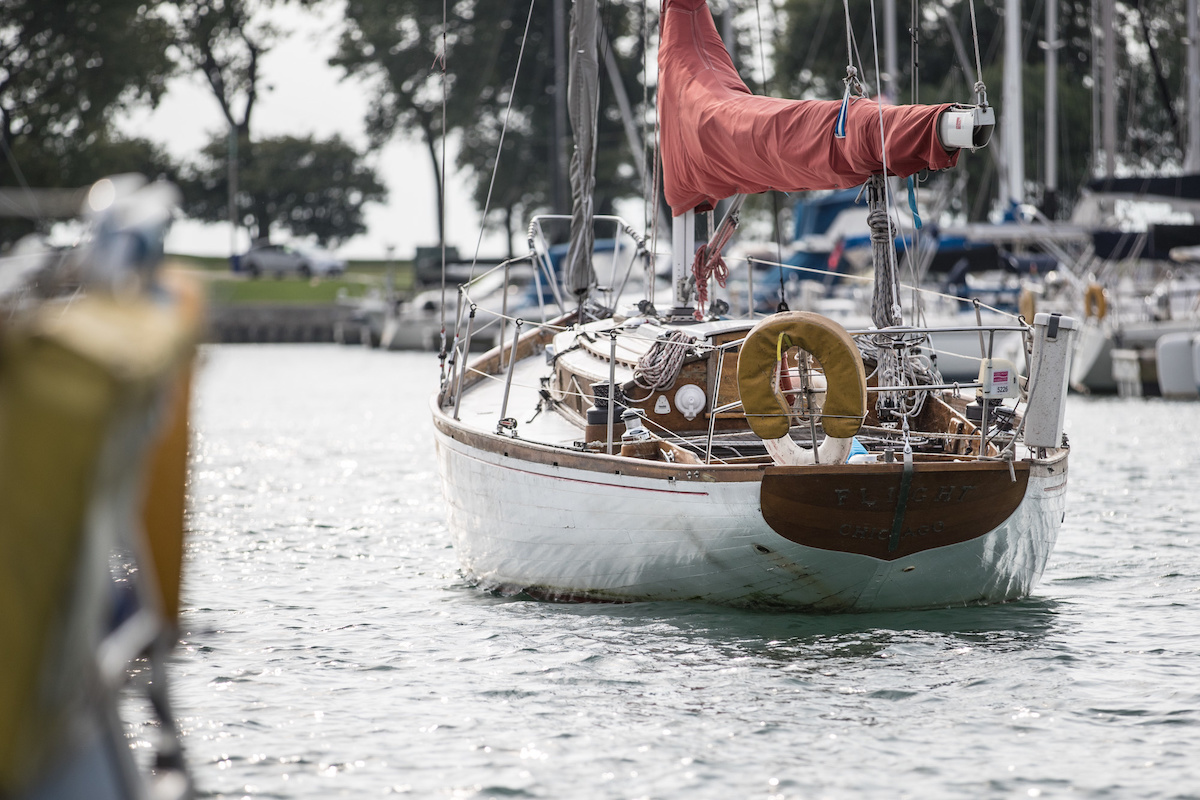
It’s easy to romanticize the idea of living on a boat full-time; however, it's an alternative lifestyle like that takes preparation, organization and an ability to roll with changes. When you commit to moving aboard, make checklists of necessities and talk to your partner about deal-breakers. Prepare the boat for life aboard well before you make the move.
Factors to Consider Before Living Aboard
Before moving onboard your boat, you should ask yourself some questions:
- Is this just for a period of time before you go cruising or is this a lifestyle choice?
- Are you comfortable with repeatedly defending your choice to your friends and family?
- Are you living in a climate that is boat-friendly year-round?
- Are you handy and a good problem solver?
- Who will accept your Amazon deliveries and are you ready to grocery shop frequently since there won’t be room to stow much?
- Are you ready to become your own maid?
- Will you feel comfortable with your kids being in this new environment?
- What’s Plan B if it doesn’t work?
After moving aboard, you may be hauling the laundry to the laundromat or groceries from the parking lot with no dock cart nearby. You’ll need to go to the pump-out station regularly as well as to the post office for your mail. Small doesn’t translate to easy so mentally run through a typical week and write down solutions to the issues.
Essentials: Stowage, Comfort & Connectivity
When you move from a 2,000-square foot house to a 40-foot boat, all the closets are smaller, the cupboards are fewer and there’s no two-car garage. In preparation, you’ll need to de-clutter kitchen gadgets, tools, mementos and clothing. Keep winter clothes in off-boat storage and your business attire at the office if possible.
Make sure the boat is warm and dry with plenty of ventilation. Mildew and condensation will become a part of life and you’ll need a whole new set of cleaners and tools.
Plan your connectivity needs. Whether a dish for TV or high-speed internet access via the marina WiFi, you’ll need a connectivity solution so you’re not cut off from work, friends, family and entertainment.
Beneficial Skills to Have for Living Onboard
Maintenance on a boat may be worse than in a house in terms of frequency and specificity. Basic plumbing, electrical and mechanical skills will be needed because boat systems are generally less reliable than their household counterparts. The alternative is calling a contractor for every issue.
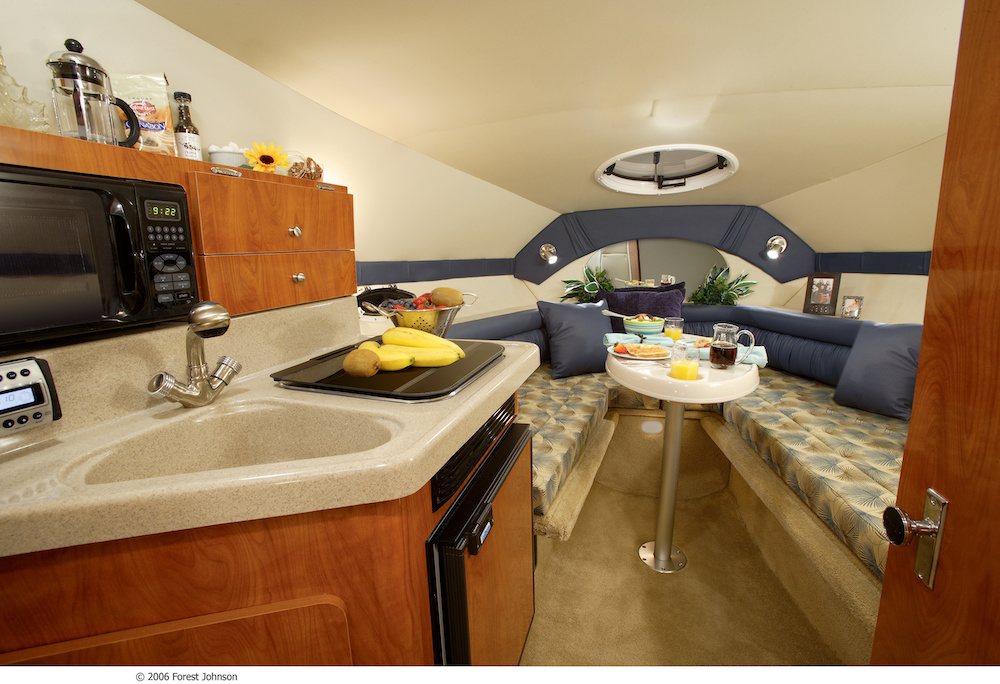
Cost of Living on a Boat
Don’t assume that you’ll save money by moving aboard. Here's some expenses you may incur by living on your boat:
- Boat mortgage payment
- Boat insurance
- Waste management
- Food and water
The best way to manage expenses is by making a budget and sticking to it. Depending on the size and value of the vessel, boat insurance may be just as expensive as house insurance. Property taxes will usually be less as will electricity since you’ll not be heating/cooling/lighting as big a space. You’ll probably save money on waste management, gas and water as well.
Where costs rise dramatically is maintenance . Marine parts and labor are usually more expensive—sometimes 20% more, than typical household counterparts. If you take on the tasks yourself and you’re self-employed, every hour you spend working on your boat is an hour you don’t make money.
Learn More in our Boat Insurance Guide
Safety & Security
You’ll need to decide whether to invite strangers inside, and if kids and pets will be safe around the docks. Install CO2 and smoke alarms and a propane sniffer, check the fire extinguishers periodically, and keep an eye on the basics like bilge and battery levels. You may also want to consider the following:
- Will you be safe walking from the parking lot to the slip at night?
- Will your nice car be okay outside the garage 24/7?
- Who will call you if your boat starts to list when you’re on vacation?
There aren’t really more or fewer safety issues, just different kinds.
Daily Life & Socialization
Socializing is easier in a marina than in a neighborhood. Neighbors help neighbors in marinas but it’s a two-way street so be ready to lend a hand when needed. If you’d rather live anonymously, consider an end tie in the forgotten corner of the marina. Although there are challenges to living on a boat, if you’re prepared, you may find it a perfect fit.
I already have a boat in a slip in a marina, so can I just move aboard?
Most marinas require an application for you to move aboard permanently. In some areas, liveaboards aren’t permitted or there are long waiting lists. Liveaboard slip fees are usually higher and your insurance rates may increase if your boat becomes your primary residence.
How do I live aboard a boat with a pet?
Dogs, cats and other pets need to acclimate to their new environments. They need exercise, private space and easy access to food and a potty. Make sure stairs and docks are safe for them and that they know how to get on the boat or dock if they fall in the water. Be careful of small spaces where they can get trapped and wires they can chew. Teach them about their new environment and be patient.
Learn more in Boating with Pets and Tips for Taking Your Dog Boating .
Read Next: Boat Owner's Guide
Looking for more information on boat ownership? Read...
- Boat Owner's Guide
- Costs of Boat Ownership
- Boat Maintenance Guide
- Insuring Your Boat
- Boat Safety Guide

Join Our Newsletter!
Get community news, buying bargains, and how-to guides at your fingertips.
Life on a Sailboat: Everything You Need to Know About Living on a Sailboat Full-Time
Living on a sailboat full-time is often romanticized as a life of endless sunsets, gentle waves, and freedom on the open sea. Many dream of casting off the lines and setting sail for a horizon of adventure and tranquility. However, the reality of life aboard a sailboat can be as challenging as it is rewarding, as frustrating as it is relaxing, and, more often than not, as mundane as it is exciting.
This blog post aims to peel back the curtain on the picturesque scenes to reveal what daily life is really like when you call a sailboat home. We will dive into the motivations, preparations, joys, and challenges of living on a sailboat full-time, providing a realistic glimpse into a lifestyle that is far from ordinary.
Our Live-Aboard Life
Our dream of living on a sailboat was a distant one for many years. But as we watched plans and dreams fall by the wayside in the wake of COVID, we made the decision to make our dream a reality. Once the borders opened up, we made a beeline for the Mediterranean and have since spent each summer living aboard our little 29-foot sailboat Whisper. Without any experience sailing or living on a sailboat, we have taught ourselves to sail and manage life on the boat along the way.
Before we took up sail life, we had been living “van life,” and we’ve come to realize there are lots of similarities but quite a few differences between the two . However, on the whole, learning to live van life first put us in good stead to take on life on a sailboat. Unlike most people, we up-sized when we moved onto a boat.
Despite the upgrade in living quarters, the learning curve and the adjustment to living on the sea were no less challenging. Nevertheless, the shift was not as scary as we thought it might be, and the reality of living on a sailboat full-time quickly became our new normal.
Initially, our plan was to buy a boat and spend one season aboard sailing the Mediterranean before selling the boat and settling down. Instead, it’s safe to say we have fallen in love with life on a sailboat. Now, as we enter our third season, we aren’t sure when we will be ready to furl the sails for good…
Get a Taste of Life on a SailBoat
We document some of the realities of living on a sailboat full-time on our YouTube Channel in our The Vanabond Sails series.
Deciding to Live on a Sailboat
The journey to becoming a full-time live aboard often starts with the desire for change.
Some people are transitioning from one stage of life to the next as careers wind up or children move out. Some yearn for adventure and excitement, while others seek a simpler way of life. Many are drawn to the promise of freedom, the allure of the sea, and the appeal of living more closely with nature. However, the decision to live on a sailboat full-time is not one to be taken lightly. It requires thoughtful consideration and planning.
For us, it was a long-held dream to sail and live aboard a sailboat. It was also a natural progression, having spent several years living and traveling by van . We were ready for a new challenge.
It began with a conversation, then a plan, and then trawling classifieds for second-hand boat sales. Before long, the decision was set in stone, and we were on our way to Croatia to buy a boat , learn to sail it, and move aboard.
Choosing the Right Sailboat
The type of sailboat you choose is critical and depends on your budget, sailing skills, and the kind of sailing you plan to do (coastal cruising, bluewater voyaging, etc.).
Will you prefer the size and stability of a catamaran, or will you prioritize the sailing experience of a monohull? Are you looking for something small that’s easily controlled and maneuvered by a limited (and potentially inexperienced) crew, or do you require the space of a larger vessel? Are you interested in the clean lines and comforts of modern boat designs, or do you prefer the style of older boats? There are a thousand decisions to be made when choosing a boat, and your own aspirations for boat life and, of course, your budget will be critical when it comes to making this decision.
Spend as much time researching boats that are available in your price range, ask questions of sailors you know or on sailing forums, and, if possible, spend time aboard different types of sailboats to get a clearer picture of what life is really like on board before making a purchase.
Check out our full article on buying boat .
Emotional and Practical Considerations for Sail Life
Living on a sailboat means embracing minimalism and being comfortable with the idea of having less space and possessions.
You’ll need to consider the impact of such a lifestyle on relationships with family and friends, as it can mean spending long periods away from loved ones.
The decision also involves considering how to manage work or income while living at sea , which might include remote work, seasonal jobs, or living off savings.
There are plenty of options for those planning on working remotely while sailing. With the rise of remote work , there has never been more opportunity to work and sail.
All of these considerations represent potential challenges to adjusting to life at sea, but they are certainly not insurmountable. You just need to be honest with yourself and decide if your love of the open water and the freedom of living aboard a sailboat will be greater than the inconveniences.
Preparations and Adjustments
Transitioning to life on a sailboat involves a series of preparations and adjustments, both practical and psychological, to ensure a smooth and sustainable living experience.
Training and Skills
If you are thinking about taking up sailing, you should, of course, invest time in learning to sail, navigate, and understand weather patterns. While this may seem like a daunting task, it’s not an insurmountable one. Time on the water is the most important thing, so it’s time to sign up for sailing courses, start planning trips with sailing friends, join a local sailing club, or seek out opportunities to crew for other sailors.
Learning basic boat maintenance and repair is essential to manage the myriad challenges that come with life at sea.
Safety courses, such as first aid, sea survival, and radio operation, are also crucial for handling emergencies.
These skills are important for safe and comfortable sailing and are often legally required. Make sure you are aware of the licensing and registration requirements for sailors in the region you are preparing to sail.
In our case, I had experience sailing small dinghies as a child and thus some understanding of the fundamentals, while Kelli had zero experience. My existing marine license issued in Australia was recognized in Croatia, where we bought our boat. I only needed to acquire a VHF radio license to become adequately certified for inshore sailing in the Mediterranean.
We paid some local sailors to come aboard and teach us both the fundamentals of our new boat (lots of docking and anchoring practice).
Downsizing and Adapting to Limited Space and Resources
As mentioned, moving onto a boat was actually upsizing for us. With a second cabin, a flushing toilet, and a large indoor table, our relatively small 29-foot monohull seemed luxurious compared to the vans we had been living in until this point.
However, for most, moving onto a sailboat often means significant downsizing, and space becomes a premium commodity. The process of downsizing for sail life involves prioritizing essential items and learning to live without the comforts of a traditional home.
Space isn’t the only limitation on a boat. Reliance on water tanks (if you don’t have a watermaker) and solar, wind, or generator electricity often means a downshift in access to creature comforts we take for granted in a house on the grid.
Creativity in organizing and making the most of limited space and resources becomes a daily practice, requiring innovative storage solutions and multi-functional furniture. Most modern sailboats are well-designed with endless space-saving measures and designs. Nevertheless, an adjustment will likely be necessary.
Financial Planning
Financial considerations are paramount, as the cost of living on a sailboat can vary widely depending on factors like marina fees, maintenance costs, and lifestyle choices.
Setting a realistic budget that includes regular maintenance, unexpected repairs, and living expenses is essential for sustaining life at sea.
Depending on your personal aspirations for boat life, this lifestyle can be as affordable or as expensive as you want to be. For us, as a couple in our thirties still in the building and saving part of our lives and careers, we are able to live on a boat in the Mediterranean affordably and comfortably for far less than we (estimate) we would spend living a more stationary lifestyle.
Check out our full article on the Costs of Living on Sail Boat Full-Time
Overall, adjusting to the confines and challenges of sailboat living demands not only physical preparation but also mental resilience and adaptability. The transition from land to sea is a profound shift, requiring a willingness to embrace simplicity, flexibility, and a sense of adventure.
Daily Life Aboard
While there is no typical day aboard, and experiences will differ wildly from person to person and day to day, we can describe what many of our days do look like.
As we work from the boat, our weeks are generally divided into work days, Monday to Friday morning and weekends. The truth is that the novelty does wear off, and many days, especially during the working week, become just as mundane as any other lifestyle. However it never stays mundane for long, one exhilarating sail, a dolphin sighting, a picture perfect anchorage or even surviving an impromptu weather event and the thrill of living on a sailboat quickly returns.
A typical workday for us living on a sailboat often starts with the sunrise (or a little bit before if we have a lot on). Ideally, we are well rested after a still night without rolling swell or, worse, strong wind, but that isn’t always assured at sea. Mornings involve checking the weather first and foremost, all plans revolve around the direction and strength of the wind and waves.
If the weather is calm, we usually try to work in the mornings when we are fresh and focused.
We travel slowly, often spending a few days in a quiet, well-protected anchorage, on a town quay, or in a marina before moving on a short distance along the coast. On sailing days, we often sail in the afternoon when the winds are a bit stronger in the Mediterranean. On days we are staying put, the afternoon might be spent exploring a new town, getting provisions, swimming, or finding a beach to lie on and read a book. In the evening, we will cook dinner onboard and get some more work done or watch some TV.
Weekends look different, and we will take advantage of not needing to be close to reliable network services, completing longer passages along the coast, or visiting islands.
Daily Differences in Sail Life
Living spaces on a sailboat are compact and multifunctional, necessitating an organized and tidy approach to prevent clutter and ensure safety. Cooking in a small galley kitchen presents its challenges, from securing pots and pans on a constantly moving boat to managing limited ingredients and storage.
Meals often need to be simple yet nutritious, requiring creativity and planning. Our approach is to cook simple, one-pot, vegetarian meals like dal or vegetable curry two or three times during the workweek and eat leftovers for lunch and dinner. On the weekend, we like to get more creative with our meals, seeking out local produce or fresh seafood and taking our time to prepare something special.
As mentioned, resource management is a critical aspect of daily sailboat life, especially when it comes to conserving water, fuel, and electricity. Efficient use of these resources is vital, whether it involves careful water usage, monitoring power consumption, or planning the next opportunity to resupply. For us, an electricity supply is mainly dependent on the sun when we are not under motor or plugged into shore power. Extended periods of cloud can alter our plans. Similarly, if we are not careful with water, more frequent visits to refill are required, which can be limiting.
Personal hygiene and privacy take on a new meaning in the confined space of a sailboat. Showers may be quick and infrequent. In our case, we generally rinse off after a swim to bathe and take proper showers during marina stops. Personal space is limited on a sailboat and managing personal relationships can have extra challenges.
Sleeping on the boat can take some getting used to, especially when on anchor. Even on a calm day, the constant rocking of the water can be disruptive at first, and novice sailors may find they get seasick, although these symptoms usually go away after a few days. When it’s windy, or there is some swell, the noise, movement, and the ever-present worry that the boat may pull off its anchor with the movement can make it very difficult to get a good night’s sleep.
Unforecast storms, gear failure, or some other emergency can occasionally create scary and challenging scenarios, especially if disaster strikes late at night. These situations are part of the adventure but can certainly be stressful.
Despite the challenges, daily life on a sailboat is interspersed with moments of profound beauty and peace. Whether watching dolphins play in the bow wave, enjoying a sunset over the ocean, or stargazing on a clear night, these experiences often make the hardships worthwhile, offering a sense of freedom and connection to nature that is hard to find elsewhere.
The Pros and Cons of Living on a Sailboat Full-Time
Pros: the joys of sailboat living.
Living on a sailboat brings a unique set of joys and rewards that can make the challenges seem insignificant.
+ One of the most significant benefits is the sense of freedom and adventure. Sailboat dwellers have the luxury of exploring new destinations, anchoring in secluded bays, and experiencing different cultures in a way that most people never will. The ability to call a variety of picturesque locations home, even if only temporarily, is a remarkable aspect of this lifestyle. Even compared to other forms of nomadic lifestyle, waking up in your own private bay or cove is hard to re-create.
+ The connection with nature is unparalleled in sailboat living. Being surrounded by the vastness of the ocean, witnessing marine life up close, and experiencing the rhythms of the sea create a deep sense of harmony and peace. The simplicity of life on a boat can lead to a greater appreciation for the small things, like the beauty of a sunset, the changing colors of the sea, or the silence of a night watch under the stars.
+ Community and camaraderie are also central to the sailboat lifestyle. The sailing community is known for its close-knit, supportive nature, with fellow sailors often ready to lend a hand, share advice, or offer companionship. This sense of community extends across harbors and anchorages around the world, creating a global network of friends and contacts.
+ The personal growth and self-reliance developed through sailboat living are profound. Navigating the challenges and unpredictability of the sea fosters resilience, problem-solving skills, and a strong sense of self-confidence. The lifestyle encourages continuous learning, from mastering sailing and navigational skills to understanding weather patterns and marine ecosystems.
The Cons: The Challenges and Hardships of Liveaboard Life
While the joys of living on a sailboat are plentiful, the lifestyle also comes with its fair share of challenges and hardships. These difficulties test the resilience and adaptability of those who choose this way of life.
– One of the most significant challenges is dealing with bad weather. Storms, high winds, and rough seas can be terrifying and dangerous, requiring skill, experience (which you can only get by …experiencing it), and a calm demeanor to navigate safely (perhaps the trickiest thing to achieve). The stress from poor weather can be mentally draining, disrupt work, and put a strain on relationships.
– The learning curve required to become a confident and comfortable sailor is not small and can take many seasons while mastering sailing can take a lifetime.
– The constant exposure to the elements also means that maintenance is a never-ending task, with saltwater and sun causing wear and tear that must be regularly addressed to keep the boat functional and safe. Especially on an older boat like ours, fixing and maintaining gear and rigging is an endless cycle. Most systems and hardware on the boat are essential, and when they fail, there is often no one around to help. Constantly sorting out jammed anchors, engine or electrical issues can quickly become tiresome and (if you are trying to work) quite disruptive. It can also be quite stressful when critical systems fail.
– Isolation is another aspect of sailboat living that can be challenging. Long periods at sea or anchored in remote locations can lead to feelings of loneliness and disconnection from land-based communities. The confined space of a sailboat can strain relationships, making it essential for the crew, be it a couple, a family, or friends, to communicate effectively and give each other personal space.
– The financial aspect of sailboat living can also be a hardship. Unexpected repairs and maintenance can quickly drain savings, and the cost of mooring, fuel, and supplies can add up. Sailors must be adept at budgeting and often need to be resourceful in finding ways to sustain their lifestyle, which might include picking up temporary jobs or remote work.
– The physical demands of managing a sailboat should not be underestimated. It requires strength, stamina, and a willingness to tackle everything from sail repairs to engine troubleshooting. The learning curve can be steep, and the responsibility of keeping the boat and its occupants safe is a constant pressure.
Despite these challenges, many sailboat dwellers find that the hardships are part of what makes the lifestyle rewarding. Overcoming difficulties and learning to live in harmony with the sea can provide a profound sense of achievement and satisfaction.
Final Thoughts About Life on a Sailboat
Living on a sailboat full-time is a journey that encompasses the full spectrum of human experience, blending moments of sheer joy and beauty with times of challenge and adversity. It’s a lifestyle that demands resilience, adaptability, and a willingness to embrace the unknown. While the romantic allure of sailing the high seas is undeniable, the realities of daily life on a sailboat are grounded in practical challenges and the necessity of continual learning and personal growth.
The decision to live on a sailboat should not be made lightly, as it involves significant changes in lifestyle, mindset, and social dynamics. However, for those who choose to embark on this adventure, it offers unparalleled opportunities for freedom, exploration, and connection with nature. The hardships encountered along the way are not just obstacles but also catalysts for growth, leading to a deeper understanding of oneself and the world.
If you have a question about living on a sailboat full-time, let us know in the comments below or shoot us an email anytime!
Fair winds and following seas!
In 2016, I had been dumped by my girlfriend, fired from my job, and the lease on my house was running out. Facing moving back in with my parents, 26, jobless and alone I decided to listen to the message the universe was trying to send me. I took off on my first solo backpacking trip, with a one-way ticket to Bangkok and a well-thumbed Lonely Planet guide. From there I wandered Southeast and Central Asia, traveled the Great Steppe, and made my way across Russia and throughout Europe.
In Estonia I met Kelli, who, despite having a less frantic travel style, shared my my restless spirit and passion for exploration. Together, we embarked on a new journey, van life. Over four years we travelled across three different continents with three different vans.
In 2022, as the world began to re-open post COVID we took an opportunity to realise a long held dream, to live aboard a sailboat. Since then we have spent two summers in the Mediterranean, sailing and living aboard our little sail boat Whisper. When we aren't sailing we continue to live our nomadic lifestyle, guided by a philosophy of slow travel and self directed adventure be it by van or backpacking.
We find excitement through our journey into the unknown, stillness and content in the beauty of the places we discover and we find ourselves in the vastness of our world.
Hopefully, we can help you find what you're looking for too. Get lost with us and find your own path.
Leave a Reply Cancel reply
Your email address will not be published. Required fields are marked *

My Cruiser Life Magazine
Living On a Boat Full Time — What to Consider Before Living Aboard
Let’s talk about real-life boat ownership and living on a boat full time. My wife and I have lived on our boat for nearly eight years, doing everything from full-time living on a boat in a marina to cruising The Islands of The Bahamas for months.
For starters, everything you’ve ever wondered about living on a boat probably doesn’t scratch the surface of everything you’ll learn. This lifestyle isn’t for everyone; for every wonderful day on the water, there’s a stressful situation or broken boat part.
So what does living on a boat full time look like? Here’s a glimpse into the world of the liveaboard.

Table of Contents
Should i live on a boat absolutely yes, here’s why (pros of living on a boat), never, in a million years, should anyone ever live on a boat (cons of living on a boat), there’s more than one way to live on a boat, there’s a steep learning curve, it’s kind of like camping, constant maintenance and cleaning, weather drama, the legalities of the live aboard life, cost of living on a boat, paths to moving aboard, living on a boat full time faqs, what are the pros and cons of living on a boat.
It is often said that there’s a wide gap between the romantic vision that many people have of the liveaboard lifestyle and the nitty-gritty reality.
Here are the pros and cons of living on a boat full time, taken from our personal experiences.
Living on a boat is sometimes even better than your most romantic vision. Dolphins frolicking while the sunsets, tropical drinks in your hands, and nothing but crystal clear water between you and the most spectacular island beach you’ve ever seen. Yes, that all happens, sometimes.
- Freedom to go where you want, when you want
- Travel as much or as little as you want
- Take your house with you as you move
- Changing scenery, waterfront property where ever you go
- Wildlife visits—seals, whales, dolphins, birds
- A friendly community of other boaters
- Learn to live more simply, with only the necessities
Everyone has good days and bad days. We’ve often described boat life as having high highs but very low lows. The peaks and valleys of boat life (crests and troughs?) are just much farther from baseline-normal.
For every dolphin, there is a broken toilet joker valve leaking sewage onto the bathroom floor.
For every idyllic island beach, there is a fouled diesel filter that needs changing.
For every smooth downwind passage, there is a sloshy, windless mess of flapping sails making everyone on board seasick.
The list could go on and on and on.
- Constant maintenance and cleaning
- Difficulty finding skilled, professional labor
- Small spaces, no storage, no privacy
- No dishwashers, washing machines, dryers (usually)
- Away from docks, you always have limited power and water
- Constant exposure to the weather
- Tax and insurance issues
Common Issues with Moving Onto a Boat
Here are some of the biggest issues we have noticed from our experiences and those around us. While everyone’s experience of living on a boat full time differs, everyone seems to have similar issues.
First, it has to be said that everyone’s experience is different. And that’s most obvious by looking at what sort of boat they choose and where they choose to live on it.
Many books have been written on the subject, and most like to divide boaters into three groups based on their budgets. There are the high-lifers who can afford to buy a new or newish boat that is large and comfortable. They can afford to live at a resort marina and likely hire professionals for most maintenance and cleaning tasks. They likely spend most of their time in marinas if they travel far.
Then there are the Goldilocks boaters—not too big, not too small—making up the “middle class” of boating. There’s a healthy mix of DIY projecting with some professional help on the big projects. They might liveaboard at a marina or travel full-time. They might live at docks, anchor, or a mix.
And then there are the budget boaters. Cheap boats are easy to come by if you’re willing to use DIY labor to fix them up. They are most likely to anchor out to minimize costs.
All these people live very different lives on their boats, but does it matter? The costs are astronomically different, but they could be visiting the same ports, seeing the same sights, and even sharing the same experiences.
What’s most amazing is how everyone perceives their liveaboard situation. I’ve been to dock parties where couples on 60′ catamarans complain that they have no personal space and must take a break from being on the boat together after a few months. Meanwhile, I know a family of five (plus two dogs) that live on a 40′ monohull with less than 1/3 the space of the catamaran. They have issues, but they’re pretty happy five years later.
(Speaking of catamarans, check out my recommendations for liveaboard catamaran options.)
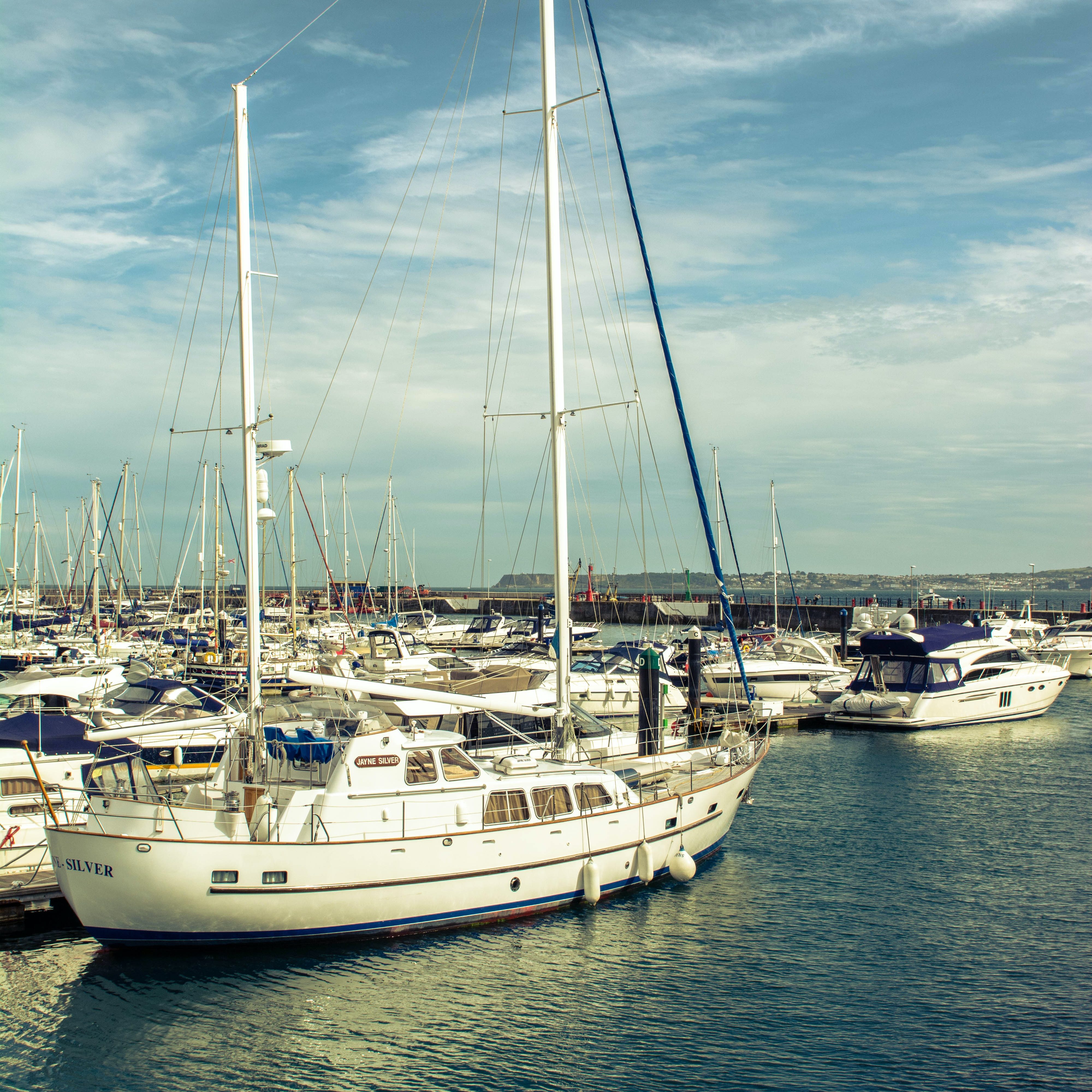
Year one of boating is the worst. There’s so much to learn; it’s all new and different than anything you’ve done before. There are all the sailing terms you must learn, but there are also boat maintenance tasks and understanding how all the systems on your boat work. Then there are the basics of seamanship and how to operate your vessel safely. It is a lot to take in.
And the basics of living on a boat are different from land life. Your kitchen (galley) is much smaller. The toilet doesn’t flush like a regular land toilet. You’re always thinking about minimizing water use when showering or doing dishes. If you turn too many electrical items on, circuit breakers pop. The list goes on and on, and when you’re new, it’s stressful.
Once you’ve got the kinks worked out, learned your boat systems, and successfully traveled and lived on your boat for a while, things get much better. You know more, your boat is set up the way you need it, and you have the confidence to start enjoying yourself. Some people take a few months, some a year, and, unfortunately, some never get there.
Boats are small spaces, but the truth is that living on a boat is more like camping than most boaters like to admit. You get by with only a few items in your wardrobe. You skip showers since you don’t always have hot water. You don’t have space for all the luxuries of home. No dishwasher. No washing machine. Everyone is occasionally uncomfortable onboard, whether from the weather or the cramped quarters.
Boats are also hard on relationships. While there’s something romantic about being cozy and alone together at sea, it isn’t so romantic on day five, or thirty, or sixty. Personal space is non-existent on most boats. It’s inevitable that your significant other—or anyone else—will drive you nuts after some time. Boats have ended more than one marriage that we know of.
The cramped living space on a boat poses other problems, too. Downsizing is important because you simply can’t bring it all with you—there’s no storage space. What is important, what’s nice to have, and what will you use on a boat? Living on a boat forces you to live with the minimum and acknowledge what you need to survive.
Living on a sailboat is, of course, drastically different than living on a luxury yacht. But all these problems seem relative, and no matter what size your boat is, everyone has the same complaints.
Boats are always trying to sink and fall apart. The ocean helps them with its corrosive saltwater and constant motion. The only thing keeping it afloat? You, the lowly and unprepared new boat owner. Yikes!
Even if you have mechanics and boatyard workers do most of the big projects for you, there’s still a ton that you’ll wind up doing on your own. Just day-to-day cleaning on a boat is a big deal. Everything is more difficult and takes longer than it does on a house.
Somehow, boats seem to get dirtier faster than houses do. From polishing the hull, shining the stainless, varnishing the teak, and scrubbing the scum line to everyday things like dishes, sweeping the floors, and cleaning the bathroom, boats are dirty, and it takes time to keep them clean.
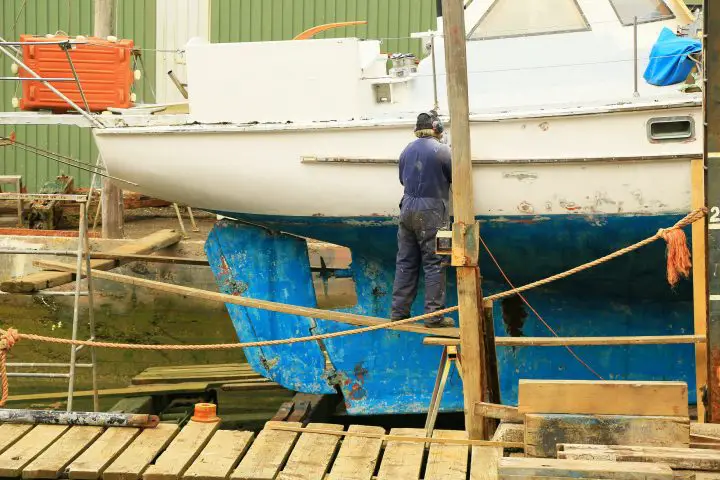
The weather plays a bigger part in your life than you’ll even imagine. Most of us pay remarkably little attention to the weather when we’re on land. If it’s hot, we might just minimize our time away from air conditioning. If it’s raining, it’s a minor inconvenience. We never think about the wind or tides.
But everything on a boat revolves around the weather. Every day we look at the weather for the upcoming week. Forecasts are often inaccurate, so we expect it to change. But what should we be ready for? When cruising, we often track weather systems over a week away and start planning.
This week, it says we might get gusts to 52 knots (!!!) from the southwest with heavy rain and thunderstorms. We’re anchored and away from the dock. Will our anchorage be protected from winds like that? Is the holding good here, or is there a safer place we should move to? Should we think about moving there early in case it fills up with boats?
We go through this exercise every week or two, no matter where we are. When approaching an anchorage, it’s all about the wind direction, tide level, and whatever else is happening. Are we okay with being stuck here for a few days if it’s foggy? A week? What if we need south winds to reach our next destination, but the forecast only has east winds? Do we wait or change our destination?
The amount of attention it takes and the flexibility of your schedule is mind-boggling to most landlubbers. When friends want to visit us, we tell them we can meet them in a specific place or at a specific time, but not both. If you want us to meet you, you’ve got to be flexible too!
What do you legally need to do to live on a boat full time? Most people’s home or apartment is their legal residence and domicile. It’s listed on their driver’s license, and it’s where they vote and pay taxes.
How will all these issues play out when you move onto a boat that moves around? There are mail forwarding services that allow you to set up residency. We use St. Brendan’s Isle in Florida since we were already Floridians, but there are also similar services in other states. This at least gives you the ability to have a driver’s license and vote.
Taxes are a little more complicated. You can register the boat at your address in Florida, but each US state collects its own use tax. If you use your boat in their state for over a few months, they want to tax it. It’s not a problem if you move around, but what if you want to leave your boat in New York for the summer? Then you might have to register it there and pay taxes.
Additionally, many counties in the US collect personal property tax on boats. We know of several places where if you are in the county on January 1 st , you’ll owe the county property tax. If you were one county away where the tax happens to be zero, you would owe nothing. Tricky!
Recreational boat insurance is another matter of concern. It used to be fairly easy to insure a boat, especially a cheap old boat. If you have a homeowner’s policy, you can easily add the boat. But if you’re a liveaboard with no real land address, getting insurance is becoming a problem. If the boat is too old, you’re traveling to distant ports, or the boat is very large, and you’re first time boat owners, it can be hard to find an underwriter.
Do you even need insurance? Many marinas and boatyards now require it. Gone are the days when you could sail the world and “self-insure.” But, honestly, those days never really existed. If your uninsured $5,000 sailboat drags anchor and puts a gash in a $5 million yacht, a serious legal headache will follow. Many owners of older vessels keep “liability-only” insurance, but even this is getting less affordable and hard to come by.
Many folks who want to try boat life are understandably curious about the average cost of owning and buying a liveaboard sailboat . Is it cheaper to live on a boat than a house? That’s a tough question to answer. For one thing, people’s expectations and their needs for comfort and security vary widely.
Both houses and boats can be found for about the same amount. If you’re in the market for a $250,000 house, you could find a nice boat for that amount. It would, of course, be much smaller and—unlike the house—be a terrible investment. So while you might be able to get a loan for a house (which makes excellent collateral for the bank), getting a loan for a boat would require a bigger risk on the part of the bank and therefore cost you a lot more.
On the cheaper end, you could find a fixer-upper boat on Craigslist or Facebook Marketplace for far less than a neglected house. A house will always have some value based on the land, whereas a boat can become valueless. It’s not uncommon to hear of people getting free boats abandoned in boatyards, making ridiculously low offers on neglected vessels, and getting large boats for a few thousand dollars. People are always wondering how to get rid of an old boat .
These fixer-uppers have their own stories, of course. Many YouTube channels are dedicated to the cheap boat fix-up scheme. Project boats can be wallet-shrinking and soul-sucking. Taking on a project is a good way to lose a lot of money, along with years of your life and any interest you ever had in boating. Project boats are not for most people.
Both boats and houses have taxes and insurance, so those costs are probably very similar. Tax laws vary by state and county. In some places, you won’t have to pay any tax on your boat except for the initial sales tax at the time of purchase. You will have to pay an annual personal property tax in other locales.
You’ll also have to pay for boat parking . Marina, mooring ball, or in the boatyard—all will come with a monthly bill. The house or apartment will not have storage fees, so there’s no equivalent here. But, if you bought a cheap boat for cash and are only paying monthly liveaboard slip fees, this might be less than a mortgage payment would be.
If you’re traveling and anchoring, you can generally do that for free. However, most cruisers spend a few nights a month at marinas. That averages about the same amount they’d pay for monthly dockage since nightly transient rates are high.
Both boats and houses have maintenance and upkeep expenses, but boats generally have more. It’s generally estimated that you should budget ten percent of the boat’s purchase price for annual maintenance. If you bought a $50,000 boat, this would be $5,000 yearly. That holds for most boats, but year one will be higher as you fix neglected items and make your upgrades.
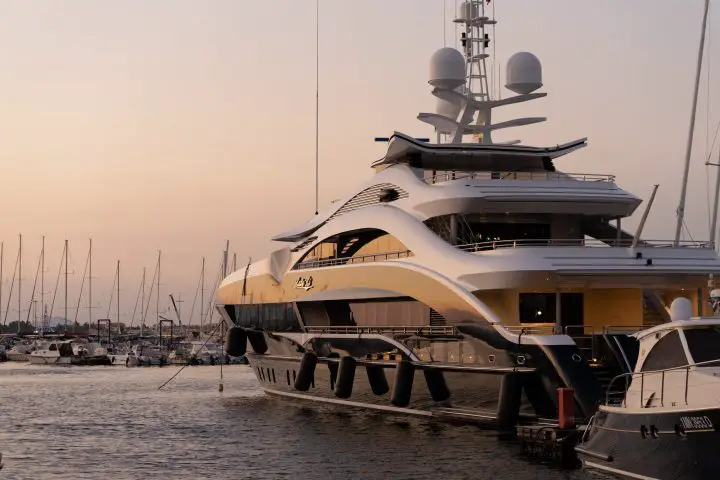
From our experience, we’ve seen people take two paths towards the liveaboard life.
- Some folks own their boat and use it for weekends or a week’s vacation here and there. They move aboard full-time as they transition to retirement, a work sabbatical, or remote work. Since it’s a gradual transition, these folks generally know what to expect.
- Then there are the folks who go all in—they know nothing about sailing or boats and sell it all and move aboard. For them, it’s a jump into icy cold water or learning a new language by moving abroad.
Which group is more successful? Group One generally knows what to expect, has worked out the kinks in their boat, and has already tackled the learning curve. There’s still a lot to take in, but they’re generally less stressed by it. If you can spend some time on your boat enjoying boating before moving onboard, it’s generally a good thing.
But, either way, being a full-time liveaboard is not a long-term lifestyle for most people. People who start from both groups seem to last an average of about one and a half to three years. After that, they’re ready to either sell the boat and move on or buy an RV or vacation land home that allows them to divide their time between boating and something else. People who last more than three years with only a boat are a very small minority.
One parting thought: Living on a boat full time and traveling is like having three or four full-time jobs. Each requires 30-40 hours per week when you include labor, research, and thinking and planning.
- Boat ownership — basic maintenance and cleaning
- Cruising full-time — destination and route planning, weather study
- Living aboard — cooking, cleaning, shopping, and everything else takes so much longer on a boat than in a house
- Your actual job — if you work aboard
How much does it cost to live full time on a yacht?
A lot depends on the size of the yacht. A small sailboat can be found fairly cheaply. For around $50,000US, you can get an older 35-foot sailboat in decent condition and move aboard with few problems. The biggest issue is finding a marina that allows live-aboard boaters. Slip fees will be your biggest expense and can be as high as $1,500 monthly in some areas. However, you can get monthly slips for as little as $300 in other places.
How to stay organized on a sailboat?
Sailboats have small spaces and not much storage, so keeping organized is key. The first step is to downsize your possessions to the bare minimum—only take what you absolutely need. The less you have, the easier your life aboard will be.
After that, it’s a matter of packing the boat so that everything has its place. Some boaters like to keep a spreadsheet of where they’ve packed everything away so they can find it quickly.
Is it cheaper to live in an RV or a boat?
Both of these activities are very dependent on location. Purchasing either one is very similar in cost. RV parks and marinas charge similar prices, but the cost varies depending on the location and services. In the end, however, moving an RV somewhere cheaper is easier and quicker, so you can live somewhere cheaply more easily.
Matt has been boating around Florida for over 25 years in everything from small powerboats to large cruising catamarans. He currently lives aboard a 38-foot Cabo Rico sailboat with his wife Lucy and adventure dog Chelsea. Together, they cruise between winters in The Bahamas and summers in the Chesapeake Bay.
Leave a comment
Your email address will not be published. Required fields are marked *
Save my name, email, and website in this browser for the next time I comment.
- Pontoon Boats
- Personal Watercraft
- nauticalknowhow
- Nautical Knots
- Tools and Calculators
5 Best LiveAboard Sailboats – Plus 8 Important Buying Considerations
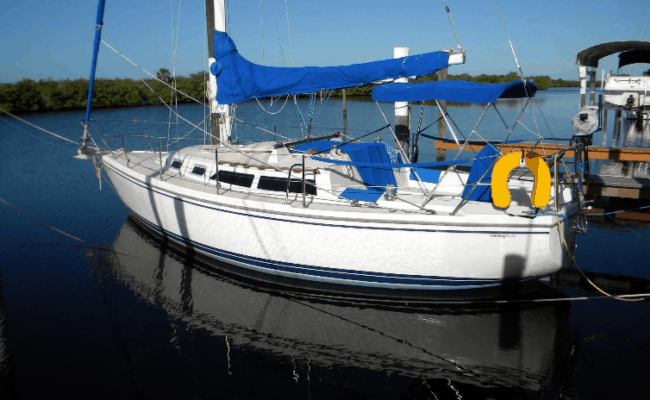
CATALINA 30
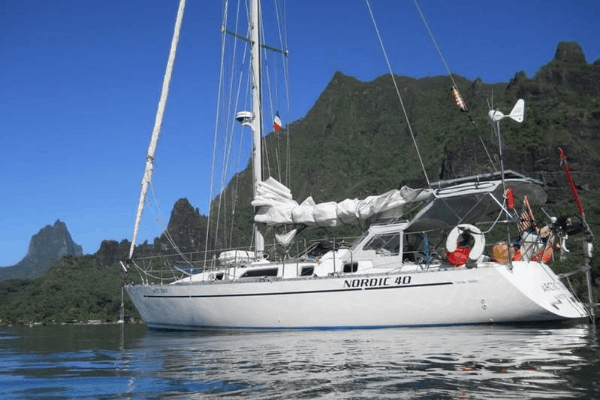
Taking the plunge to live on a sailboat is usually a huge decision, especially as living aboard a boat is an exciting lifestyle choice. However, there are lots of things to consider before buying a boat that will suit your needs and also be nearly as comfortable as a traditional home on land.
Whether this is your first time choosing a liveaboard sailboat, or you want to upgrade to a better option, you will find useful information in this article. But before we get into the best liveaboard sailboats and how to choose one, let’s see why living aboard a boat is a great lifestyle choice.
We’ve reviewed some of the best liveaboard sailboats and listed them here to help you choose one that will suit you most.
5 Best LiveAboard Sailboats
Islander 36.
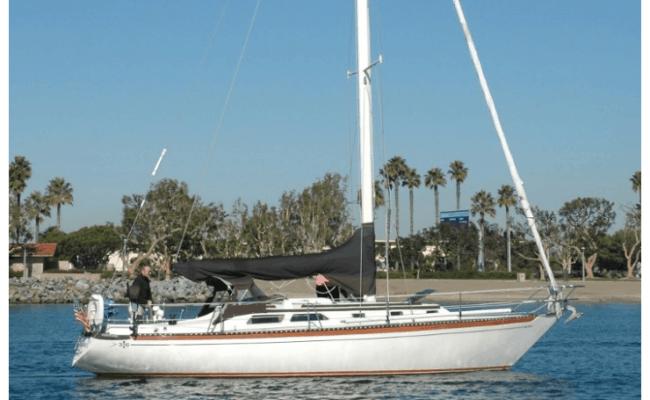
The Islander 36 is the boat for you if you want a well-rounded sailboat with impressive cruising abilities. With close to a thousand of these boats built between 1973 and 1986, the model is one of the successful and best-selling boats of the company.
These sailboats are renowned for their well-adorned cabins, with many featuring exquisite wooden interior trim. Typically, the interiors are spacious and feature a long port and starboard settee. The settee is designed to fold out into a double berth for sleeping. There is also a nav station to port with a quarter berth at the back that forms an extra seat. The boat also has a spacious master berth with an enclosed shower, making this boat one of the best liveaboard sailboats for cruising.
The interior also features plenty of drawers, plus many caned and louvered lockers. The L-shaped galley is to starboard and equipped with an icebox (that can be upgraded to a refrigerator). It also comes with a three burner LPG stove and a double sink.
Perhaps the most eye-catching feature of the interior is the companionway steps that are easy to maneuver. This is by far better than having ladders, as the steps can serve as additional separate seats when you have guests onboard.
The amount of fuel the boat’s tank can take is ideal for coastal cruising. Although Islander 36s can embark on extended trips, you will need to get additional jerry cans for that purpose.
You can check here for pricing and listings .
- LOA: 36 ft
- Beam: 11 ft 2 in
- Ballast: 5450 lbs
- Displacement: 13,450 lbs
- Sail Area: 612 sq ft
- Fuel Tank: 30 gallons
- Water Tank: 56 gallons
Boats →
If you are looking for a boat that is tough to beat feature-for-feature and size-for-size, perhaps this model will be of interest to you. Designed for comfort and performance, the Catalina 30 is arguably the most common production cruising sailboat to ever grace the open waters. Despite coming into the market as far back as 1972, their popularity to date is a glaring proof of high performance.
You can expect to find spacious accommodation in this 30-foot sailboat with modern features such as a fully equipped galley and electric pumps that supply running water. The layout features a “suite” style with a V-berth master bedroom that is closed off from the rest of the cabin.
The Catalina 30 also features a dinette that can also serve as a workspace or chart table. The boat also includes an enclosed shower and head, which makes living aboard a comfortable experience.
Check out listings for Catalina 30 here .
- LOA: 29 ft 11 in
- Beam: 10 ft 10 in
- Ballast: 100 lbs
- Displacement: 10,200 lbs
- Sail Area: 446 sq ft
- Shoal Draft: 4 ft 4 in
- Head Room: 6 ft 3 in
Yachtworld →
Weatherly, comfortable, spacious, and fast – these are what readily comes to mind when you think of the Nordic 40 .
This large sailboat is perfect for long-distance voyages, so if you intend to buy a boat that will offer excellent accommodation for offshore cruising, you know where to look. Thanks to its large structure, the interior is extremely spacious, making it the perfect choice for couples who want to spend more time aboard a boat.
The standard Nordic comes with top-notch equipment, including a Navtec hydraulic vang and Navtec rod rigging, plus full hull insulation in the entire interior. There is standing headroom available throughout, along with a spacious master bedroom.
The galley is fully equipped with modern facilities and allows for comfortable living. With the standard Nordic 40, there is no worry about storage space. Remote living is a walk in the park with this boat, even if you intend to anchor out for a couple of months at a stretch with enough supplies and provisions.
Keep in mind that these boats are not very common, but if it is the type that appeals to you, it is worth searching out.
Check out listings for Nordic 40 here .
- LOA: 39 ft 9 in
- Beam: 12 ft 5 in
- Ballast: 7,091 lbs
- Displacement: 18,000 lbs
- Sail Area: 756 sq ft
- Water Tank: 120 gallons
- Fuel Tank: 56 gallons
Thinking about taking your entire family for a coastal cruise or even a near-offshore cruising experience? Consider the Hunter 33 , one of the best liveaboard sailboats equipped for such purposes.
One of the longest-lived boats in its category, the Hunter 33 came into the market in 1977 and is still in production to date. The mid-sized sailboat comes with great interior accommodations, with ample room for sleeping and sitting. It comes with two private cabins, which is great for a 33-foot sailboat.
It features a shower and toilet aft the master bedroom. Plus, there is a full dinette and standing headroom throughout the cabin.
In a nutshell, this the perfect sailboat for those moving up in size and want a great boat with modern conveniences for an extended cruising period.
Check here for detailed listing and pricing .
- LOA: 33 ft 6 in
- Beam: 11 ft 6 in
- Ballast: 3,579 lbs
- Displacement: 11,016 lbs
- Sail Area: 625 sq ft
- Water Tank: 50 gallons
- Fuel Tank: 25 gallons
- Headroom: 6 ft 4 in
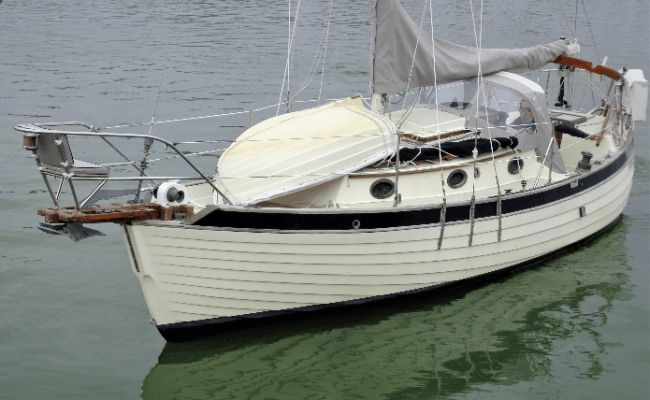
The Nor’Sea 27 is an excellent choice if you are single or searching for the best liveaboard sailboats for minimalists. This boat is arguably the best compact liveaboard cruiser available in the market today.
The compact boat has a surprisingly spacious interior for a 27-footer. Plus, it features almost every amenity you can find on a larger boat.
For comfort, the small sailboat feels more like a Catalina 30 and comes with a galley, shower, toilet, and two bunks below the cockpit. The forward berth also serves as a dinette.
The design of the sailboat is a huge success and has found a pretty strong following, which explains why it is still in production to date despite hitting the market long ago in 1976. As expected, the little sailboat costs less in slip fees. But the best part is that you can tow it on a trailer, and that’s all legal.
Don’t be fooled by its size, though. The Nor’Sea 27 isn’t cheap. Prices for new ones start from around $150K (with kits starting anywhere from $35K). You find used ones for as little as $15,500 or as much as $95,000 depending on age, quality of finish, and condition.
Find out current listings and prices here.
- Ballast: 3,100 lbs
- Displacement: 8,100 lbs
- Water Tank: 20 gallons
- Fuel Tank: 20 gallons
How to Choose the Best LiveAboard Sailboats – Buying Guide
There are several things to consider when choosing a liveaboard sailboat, but perhaps the most important factor is the level of accommodation that will suit your need. A boat with useful features such as a fully functional kitchen or electric toilets are well and fine, but many traditional sailors don’t really care about limited amenities. Any stripped-down sailboat with basic interior would do just fine.
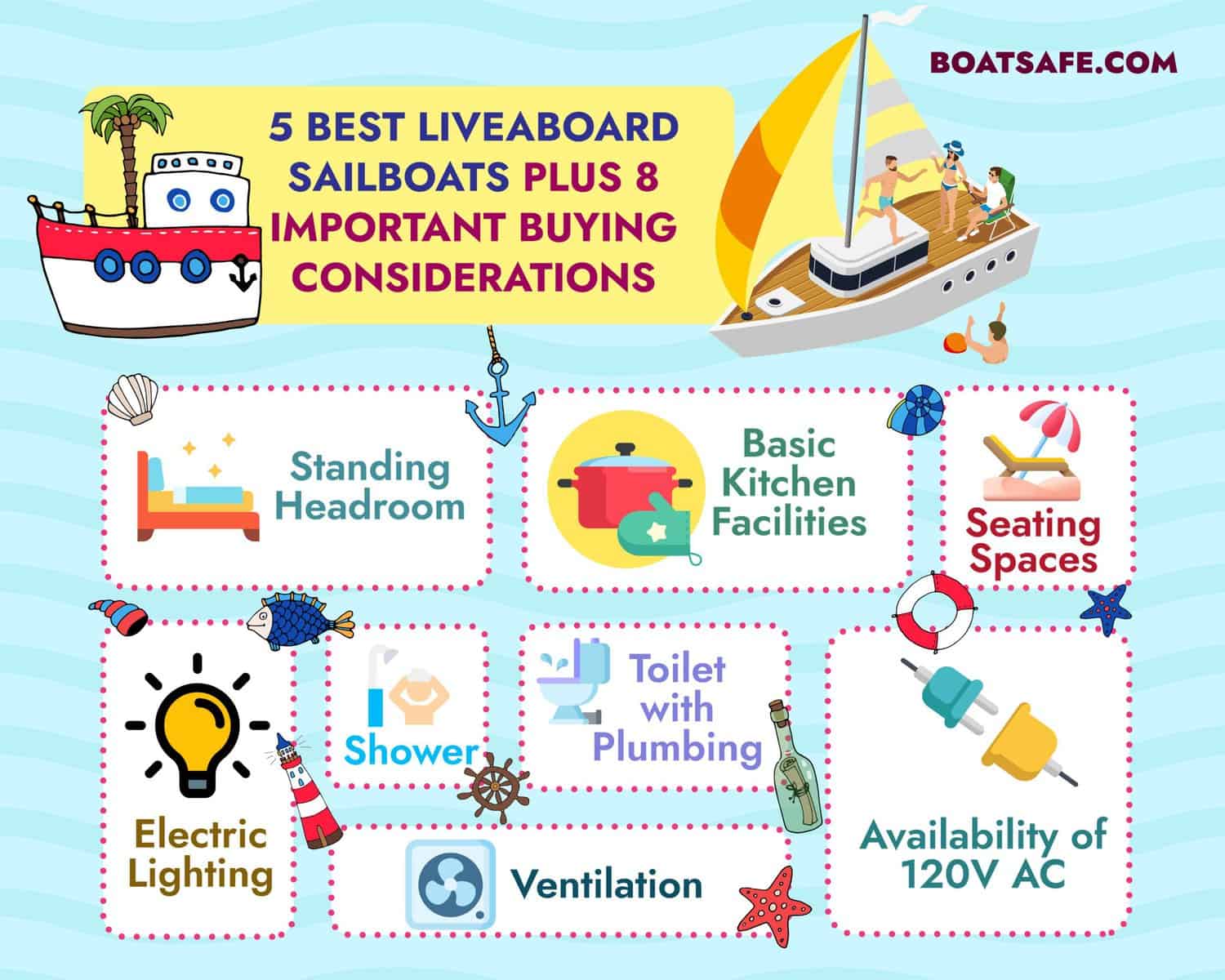
Most sailors are generally okay with any standard live about sailboats constructed after 1970 since these types typically have adequate ventilation , a usable kitchen, head, and shower. But whatever your preferences, you can be sure you will find something that will provide the level of comfort you need in most modern sailboats.
Here are 8 important factors and requirements we think are crucial when choosing the best liveaboard sailboats.
1. Standing Headroom
There’s nothing wrong with spending a couple of days in a week aboard a boat without standing headroom. However, if living aboard a sailboat is a lifestyle choice for you, consider one with standing headroom. Your body is not meant to crouch or crawl for months or years on end. With time, your back and other muscles will start to take a hit. For your overall health and wellbeing, it is best to choose a sailboat with standing headroom. Our recommendation is 5-feet 10-inch standing headroom or something within that range.
2. Basic Kitchen Facilities
A liveaboard boat without a kitchen can only mean one thing: you will be eating out every single day! While this is okay for some people, others will prefer to cook their own meals at least once in a while, regardless of their culinary skills.
We think a kitchen is a must-have for the best liveaboard sailboats, even if it doesn’t have all the modern facilities. Basic kitchen facilities should include a refrigerator or icebox, a sink, and a stove. If you find one with an oven, that’s a plus, too!
3. Toilet with Plumbing
The fastest way to spread diseases when you liveaboard a boat is to have improper human waste storage and disposal system. Sanitation facilities are among the top considerations when choosing the best liveaboard sailboats.
Using a porta-potty all year long is definitely out of the question. Besides, no one would like to live on a stinky boat or have guests come over a smelly abode. When you choose a liveaboard sailboat, look for one with a built-in and properly outfitted toilet. It should also have a safe sewage storage tank with a proper disposal system.
Many liveaboards prefer to use gym or marina facilities instead of their onboard showers. This is okay, but it doesn’t eliminate the need for bathing facilities on board. Choose a sailboat with a shower for convenience’s sake, even if you don’t use it all the time.
It is important to make sure that your bilge pump is always in good working condition, especially if you have a boat shower that drains directly into the bilge. Keep in mind that whatever goes into the drain will find its way below your floor.
5. Electric Lighting
Having kerosene lamps is okay. In fact, many sailors love to have them because it adds a certain feel and beauty to their boats. But you definitely want to consider the convenience and safety offered by electric lighting. If you plan on living aboard a boat for a long time, you will need some form of reliable electric lighting.
6. Availability of 120V AC
The best liveaboard sailboats come with 120V AC outlets for standard house electricity connections. The availability of electricity is a definite requirement for living aboard a boat. You want to have a way to charge your cell phones, computers, and use other electronic gadgets. A boat with only a 12V outlet is not good enough. It is best to choose a sailboat with 120V AC outlets if you want to enjoy electricity living aboard a boat full-time.
7. Seating Spaces
Apart from the main bed, the best liveaboard sailboats should have additional seating spaces. There should be separate spaces for sitting, working, navigating, and eating, especially if you plan on living aboard for a long time. You don’t want to be bored with the monotony of using only one space (the main bed) for all your daily activities. Having separate seating spaces has the added advantage of making your day-to-day activities more agreeable.
8. Ventilation
Perhaps the simplest requirement for liveaboard sailboats is ventilation. But it is equally essential, regardless. An opening porthole or a passive solar roof vent should suffice. The important thing to consider when it comes to proper ventilation is a boat that provides a way to let in fresh air without needing to open the main hatch.
Coastal Vs. Offshore Accommodations
And now, here’s one final factor to consider before choosing a liveaboard sailboat. How do you plan to use your boat? Do you want a sailboat that will serve primarily as a long-distance cruiser, or do you intend to use it mainly for coastal cruising?
Your intended use significantly affects the style of interior design that will be suitable for your purpose. Sailboat accommodations are greatly impacted by their cruising purposes. Coastal cruisers are likely to feature more plush layouts, complex interiors, and larger sofas. Also, these boats generally have several amenities, so it is common to have smaller storage spaces in these sailboats.
On the other hand, offshore or long-distance cruisers feature cabins that are designed and arranged to make the journey as comfortable as possible. These sailboats generally don’t have unnecessary furniture and other extras below deck to make room for increased sleeping and storage spaces.
It is easy to get carried away during the physical inspection of a sailboat, especially if the boat is equipped with modern facilities and fanciful, eye-catching amenities. But don’t get swayed by those, even though they are important for improved convenience. Your top priority should be how you intend to use the boat – for coastal cruising or offshore cruising. This should inform your choice of accommodation.
Benefits of Living on a Sailboat
Okay, why should you want to give up living on land and opt for an unstable address somewhere in the middle of the ocean? Is it even safe to do so?
Living aboard a sailboat is an exciting lifestyle that offers several benefits and challenges, too! Thousands of people across the world choose this lifestyle, and because these boats are constructed from high-quality, durable materials, you can be sure it is safe to liveaboard one.
This lifestyle offers liveaboards a cheaper alternative than living in a traditional house. This is particularly the case in waterfront cities where rental apartments and houses in the marina areas are even more expensive.
It is a lot cheaper to live in a boat if you enjoy traveling around the world on the water. And if you enjoy the marina lifestyle, you could take it a step further by owning and living in one of the several best liveaboard sailboats available.
And come to think of it, these boats require some serious investments. What’s the point of buying a “house” on the water without living in it, right? To many people, it makes more economic sense to live in their expensive boats, instead of paying extra rent for a house on the land when there is one idling away on the water.
About Chris
Outdoors, I’m in my element, especially in the water. I know the importance of being geared up for anything. I do the deep digital dive, researching gear, boats and knowhow and love keeping my readership at the helm of their passions.
Categories : Boats
Leave a Reply Cancel reply
Your email address will not be published. Required fields are marked *
Save my name, email, and website in this browser for the next time I comment.
More in Boats

What Is A Gunwale?

131 of the Best Hawaiian Boat Names

167 Patriotic Boat Names

The 138 Best Boat Names for Dog Lovers

The People’s Poncho Review and Ratings

Oru Lake Kayak Review

About Boatsafe
Established in 1998, BoatSafe is your independent guide into the world of boating, fishing, and watersports. We provide expert insights and detailed guides to help you find products tailored to your needs and budget.
Contact Boatsafe
- Address: 4021 West Walnut Street. Rogers, AR 72756
- Phone: (479)339-4795
- Email: [email protected]
Site Navigation
- How We Test
- Corrections Policy
- Privacy Policy
- Terms & Conditions
- Editorial Policy
- Affiliate Disclosure
Our Reviews

All content is © Copyright 2024. All rights reserved.
13 Most Practical Boat Liveaboard Places in the US

If you’re considering moving onto your boat full-time, there is a range of practical issues you need to take into account before choosing a permanent liveaboard location in the U.S.. For starters, if you’re hoping to live aboard whilst working, you’ll obviously need to be close enough to commute to your office every day. For those of you who are retried or remote workers, you can count yourselves among the lucky ones and you have a bit more freedom to choose where you want to live.
There are plenty of stunning spots in the U.S. but not all of them are practical for year round living. At the same time, you need to be aware of hidden fees and taxes that different states impose so be sure to research any destination thoroughly before packing your bags and heading across the country. Living aboard can be a fantastic adventure, giving you the freedom to live in beautiful destinations for lower prices than waterside properties and the added bonus of being able to sail away whenever the feeling hits you. This list takes into consideration practicality and adventure because really the two go hand in hand when it comes to living on your boat!
Read on for 13 of the best places to liveaboard in the U.S. to maximise your quality of life and quality of sailing.
On this page:
San francisco bay, california, newport, rhode island, green bay, lake michigan, corpus christi, texas, san juan island, washington, tacoma, washington, lake of the ozarks, missouri, long beach, california, chesapeake bay, maryland, long island, new york, tampa bay, florida, destin, florida, oahu, hawaii.

San Francisco Bay is a paradise for sailing. The sheer variety of conditions and scenery you can find in the bay makes it an ideal destination for anyone who loves a challenge. Whilst the weather is not as warm as others on this list, if you wrap up well when you’re out and make sure your boat is fitted with a good heater, it can make an excellent choice. From the Tiburon Peninsula to Richardson Bay to the Farallones, there is a wide range of conditions and winds to contend with. At the same time, there’s plenty of developed waterfront areas to eat, grab a drink or go shopping.
One of the cheapest places to live aboard in San Francisco Bay is Oyster Point Marina where reports put the monthly cost at $350 plus a live aboard fee of $200. Generally, the harbours get less expensive as you go further inland. Good choices include San Rafael and Vallejo.
For cruising at the weekends there’s plenty of destinations on offer including Angel Island or the Petaluma or Napa Rivers. If you have longer, you could consider sailing south to Half Moon Bay or Monterey. A combination of cheap rates (if you know where to look), varied sailing, and plenty of destinations nearby make San Francisco Bay a top choice for liveaboards.
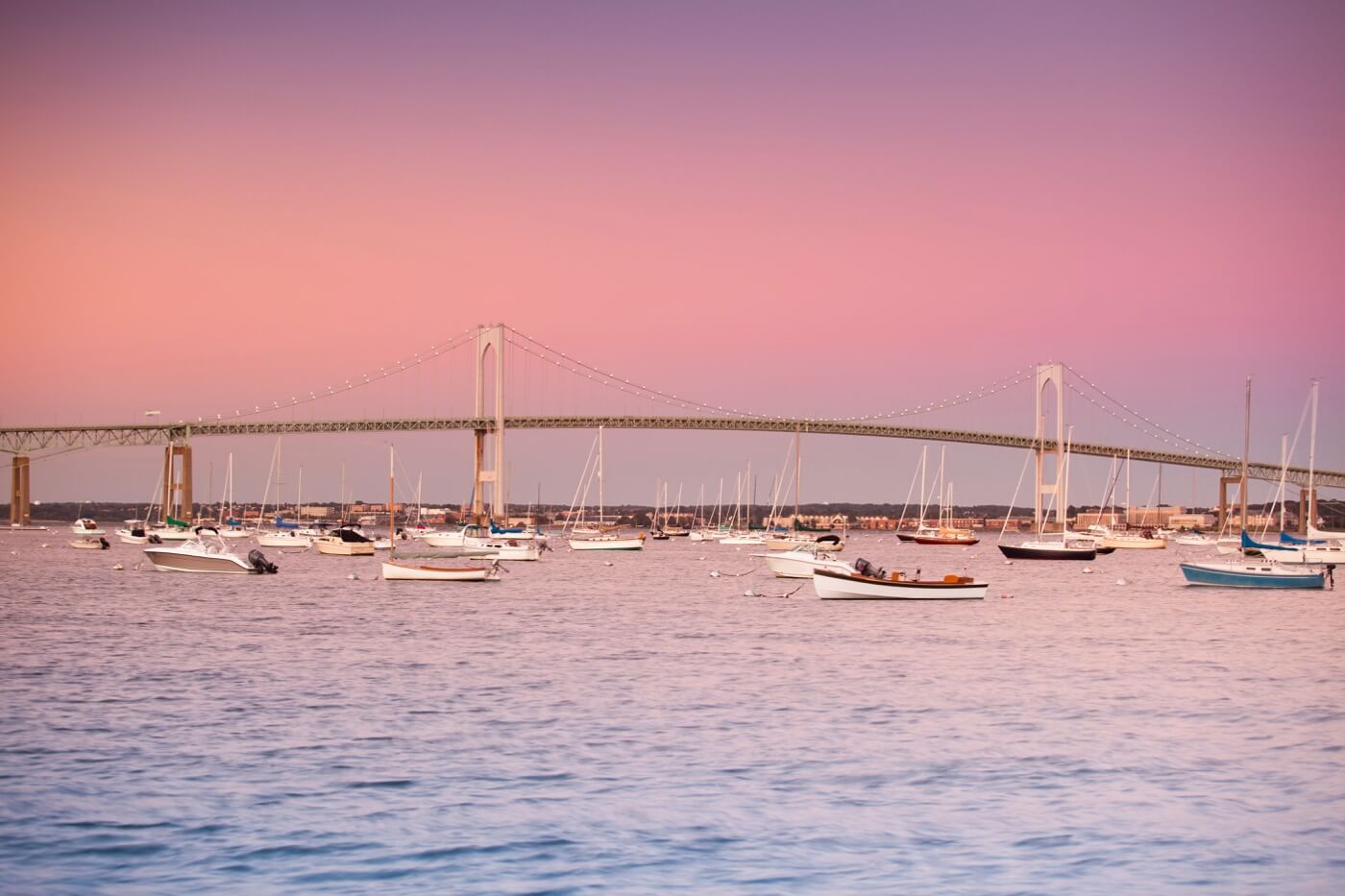
Perfectly positioned on Aquidneck Island, near the mouth of Narragansett Bay, Newport is known as the sailing capital of the world. Whilst this title is certainly up for debate and there’s plenty of other destinations claiming the same, it’s a really popular destination on the East Coast. The area is blessed with a beautiful shoreline and more than 400 miles of coast dotted with beaches. There are yacht tours and a regatta during the sailing season, which runs from mid-April to late October, and there’s some good liveaboard spots available too.
Newport’s popularity makes it an expensive choice but there are some areas that are more reasonable options. Wickford, on the west side of Newport, has rates starting at around $500 per month for a medium-sized boat with access to the town. Jamestown across the bay is also a less expensive option. Getting across to Newport itself is easy enough and the proximity means you can still enjoy all the city has to offer. If walking is more your idea of a good time, there’s a 3.5 mile cliff walk to sink your teeth (feet?) into.
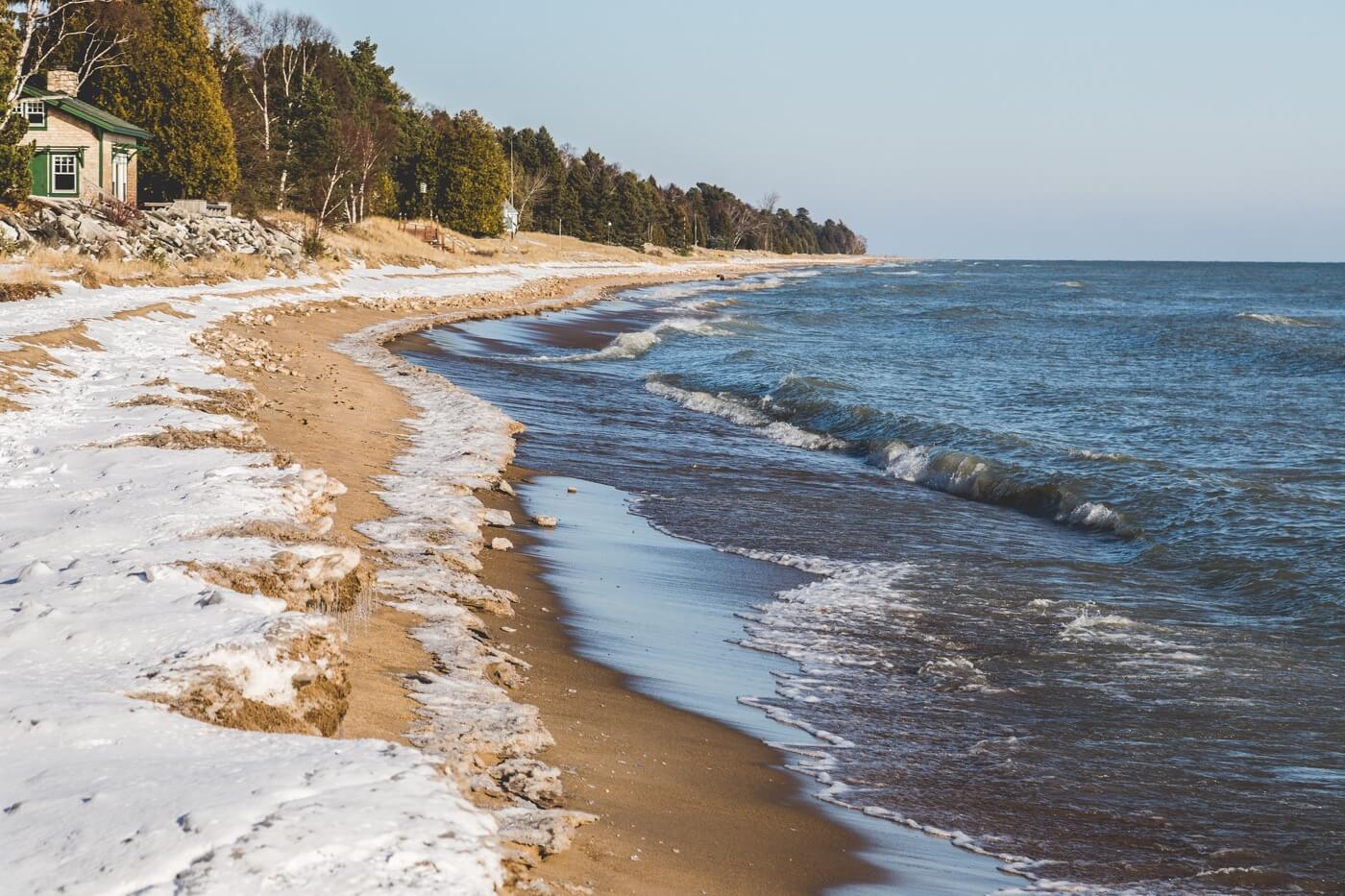
Green Bay on Lake Michigan is another picturesque and convenient choice for liveaboard hopefuls. Green Bay is separated from the rest of the lake by the Door Peninsula and the Garden Peninsula and the islands between them. The waters around Green Bay have been important for hundreds of years, serving as a key waterway for trading fur and pelts. Its history as a port can be traced back to Native American use before British, French and American traders began building military fortifications to secure their hold on the territory in the early 1800s.
You can get to Green Bay via the Fox River, Sturgeon River and Porte des Mortes. Green Bay is ideal for fishing fans as well as offering a large variety of onshore activities from shopping to eating out to the Green Bay Botanical Garden. Green Bay rates start as low as $150 a month if you’re on a strict budget. Be warned, for this price the space will be basic. For higher prices you can find somewhere nicer - you pay for what you get in this area.
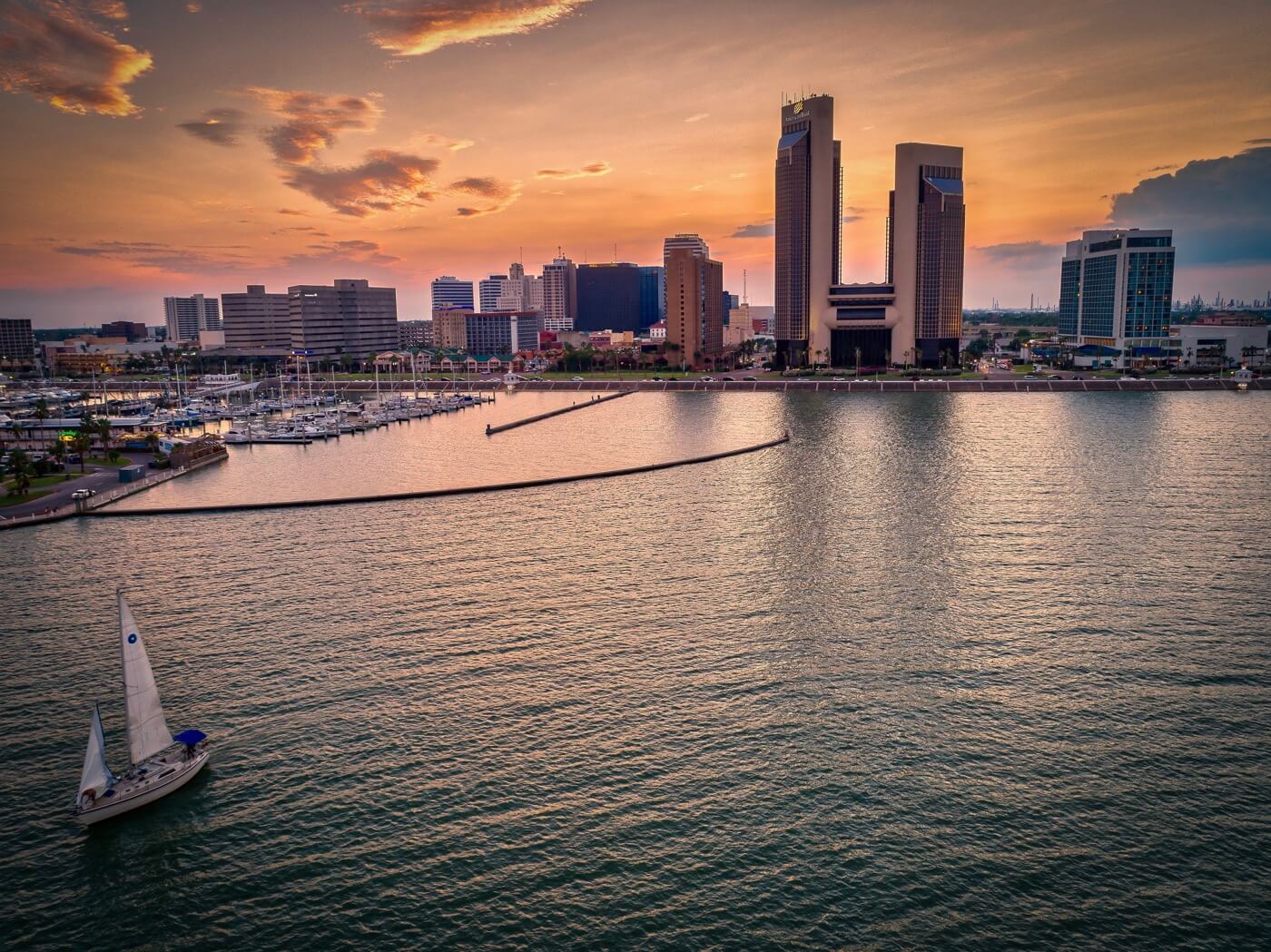
A coastal city on the Gulf Coast of Texas, Corpus Cristi is an affordable and popular option for living aboard, offering the practicality of being close to the city but the romance of life at sea. Sheltered by the Padre and Mustang Islands, the waters are home to sea turtles and migratory birds can be seen flying overhead. At the same time, the waterfront is undergoing increasing amounts of development. It’s known as a safe and laid-back city, making it a popular choice if you’re looking for an easy life.
Texas is a great state for liveaboards as boat taxes are relatively low. You can find slips starting at just $150 per month for smaller boats though prices go up for larger boats of course. One example is a 60-foot slip for $3,000 per year, working out at just $250 per month. Some marinas in Texas allow you to pay annually instead of monthly, which can also save you money long-term.
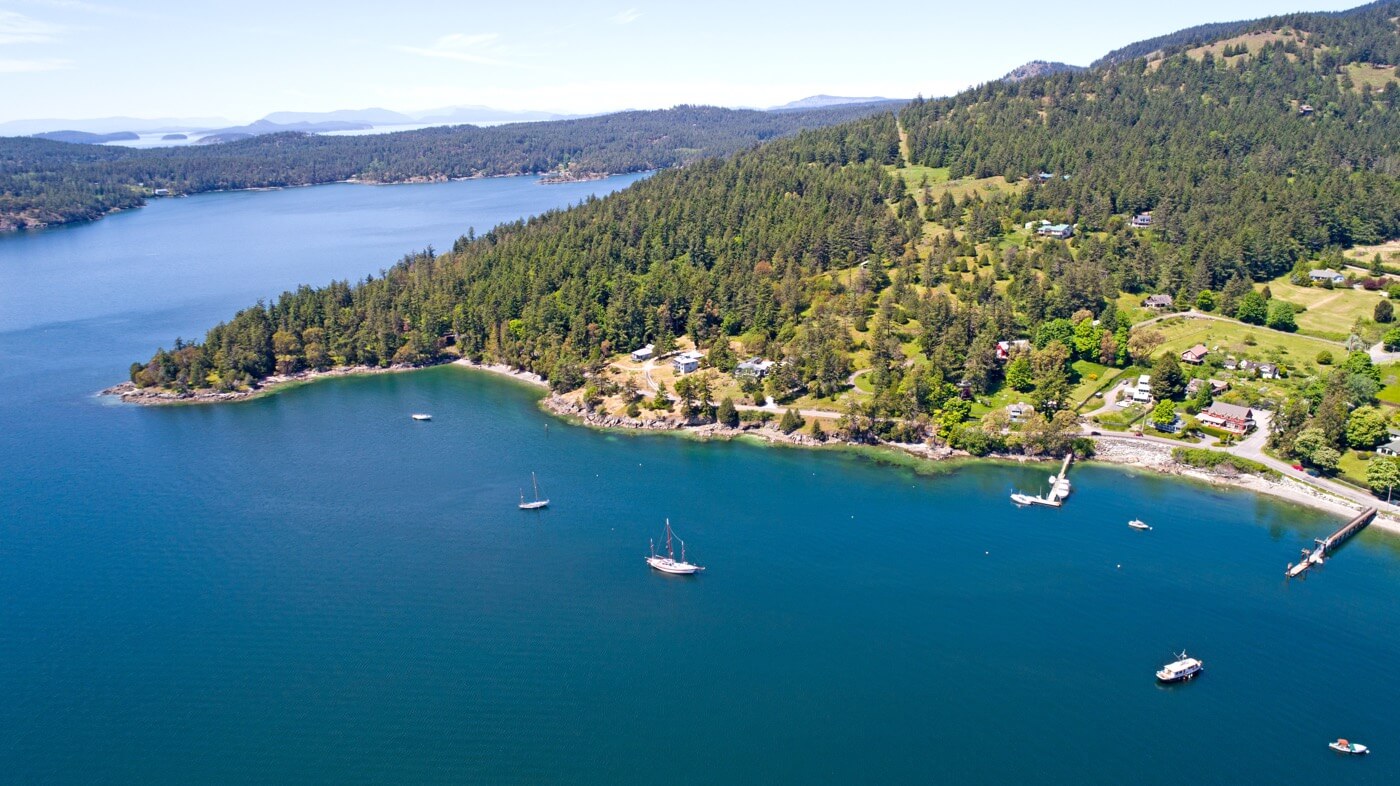
Stunning views, regular festivals and friendly locals - San Juan Island can offer a lot if you’re looking to liveaboard. San Juan is the second largest island in the archipelago between Vancouver Island in British Columbia and mainland Washington. In spite of this, at only 24 miles long, 9 miles wide and a population of 7,500, it’s definitely a small town spot. Here’s a location where everyone knows everyone.
Visitors are drawn by the woods, the beaches and the impressive views of the Olympic Mountains. For cultural activities, there’s a wide range of galleries and studios on the islands thanks to the large number of artists who call the area home. It is also the best spot in Washington for sailing. Despite the drop in temperatures, it’s suitable for sailing year-round, making it an ideal location if you’re planning to liveaboard for 12 months of the year. The best time to sail is from April to October and in the summer you can see orca wales on their annual migration. Be warned, rates tend to be higher for San Juan than other locations but if you have the budget, it’s worth it.
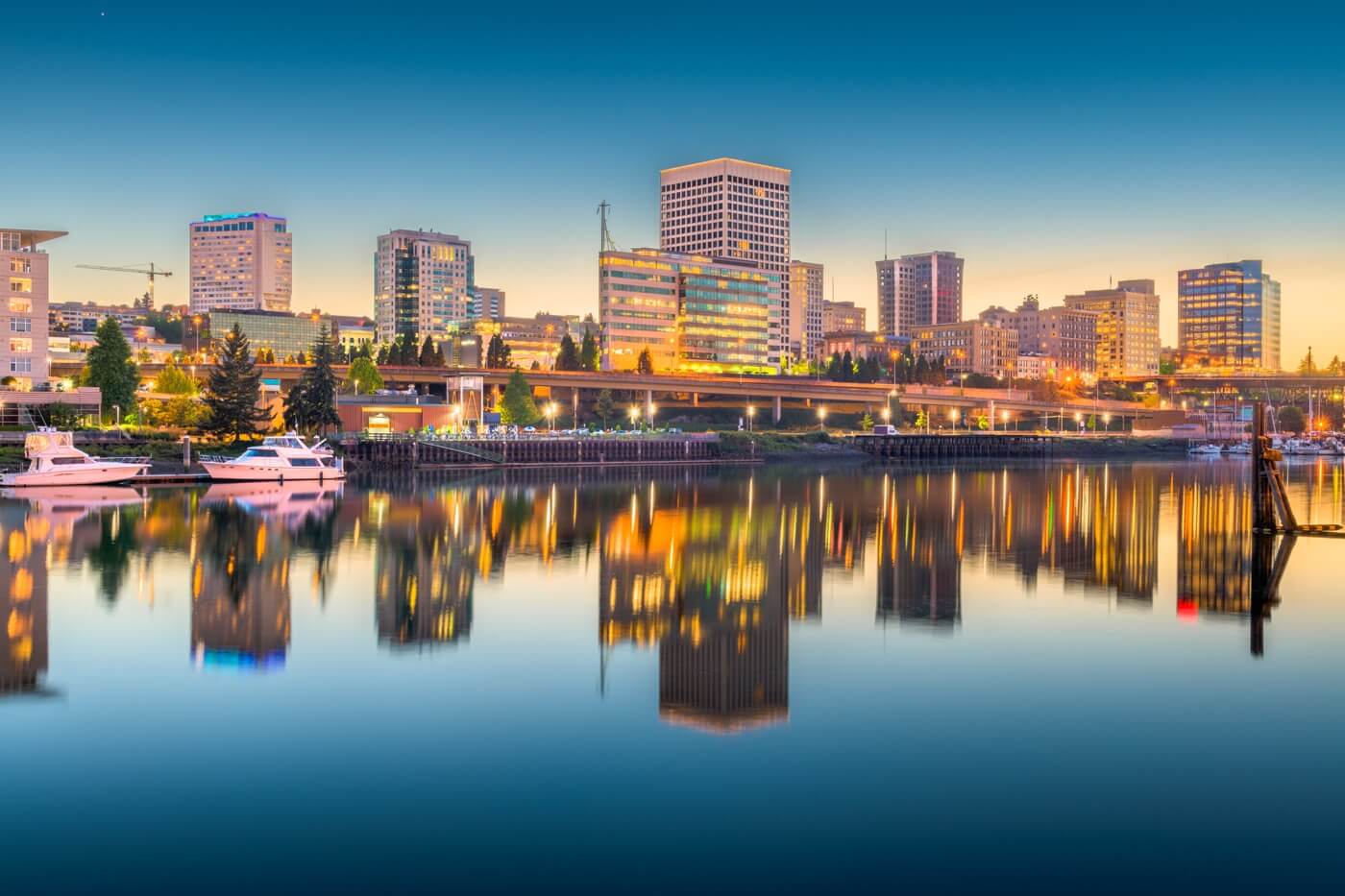
Tacoma is a practical choice for those looking for reasonably priced slips in Washington. Perched on the Puget Sound, Tacoma’s Commencement Bay offers liveaboards city conveniences combined with great sailing. The Puget Sound itself offers good cruising grounds and you can head north to the San Juan Islands for trips. In the South Sound, there are plenty of state parks to be found and fantastic scenery thanks to Mount Rainier only 42 miles away. This is also handy if you’re looking for adventure activities on dry land. What’s more, Tacoma neighbors Seattle and is close enough that you can head over there whenever you’re looking for a taste of the big city.
Rates for liveaboards vary depending on where you’re looking in Puget Sound. Reports for Tacoma put slips at $500 per month compared to $750 in Seattle. Nearby Bremerton is another good choice for keeping costs fairly low. The great news about this location is that there’s a lot of choices for liveaboard marinas so you can find one that suits your needs, be it an on-site gym, a kitchen, showers or storage facilities.
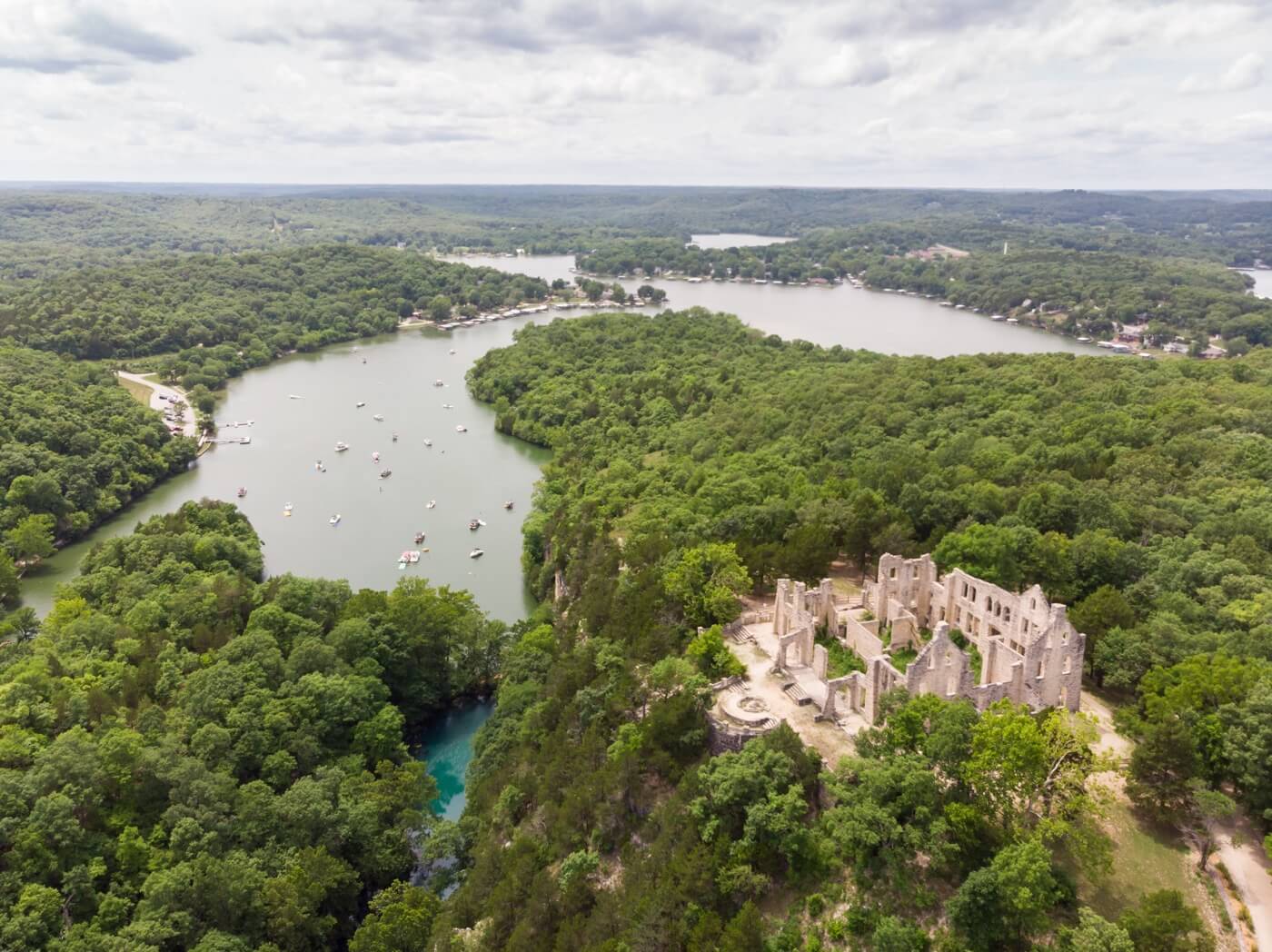
Coming in top for the most break-taking scenery, the Lake of the Ozarks is a truly stunning place to live. Thankfully, living aboard your boat is also fairly cheap, giving you a much better deal than if you tried to buy or rent a lake-side property. The water levels are fairly stable year round and there is a wide range of marinas to choose from who are happy to accommodate liveaboards. Different marinas offer different amenities with some set up for entertaining, with access to BBQs and bars and others better for a quieter lifestyle. It’s a good idea to tour some of them before you decide where to stay to get a feel for the different atmospheres and what you can expect.
There’s no end to the conveniences on offer in this the Ozarks with dockside cafes and restaurants aplenty, placed at convenient points along the shore. The Lake of the Ozarks is so well set up for liveaboards that you can even get food delivered to your boat! This is the ultimate spot for convenience and practicality, if takeout is your idea of being practical!
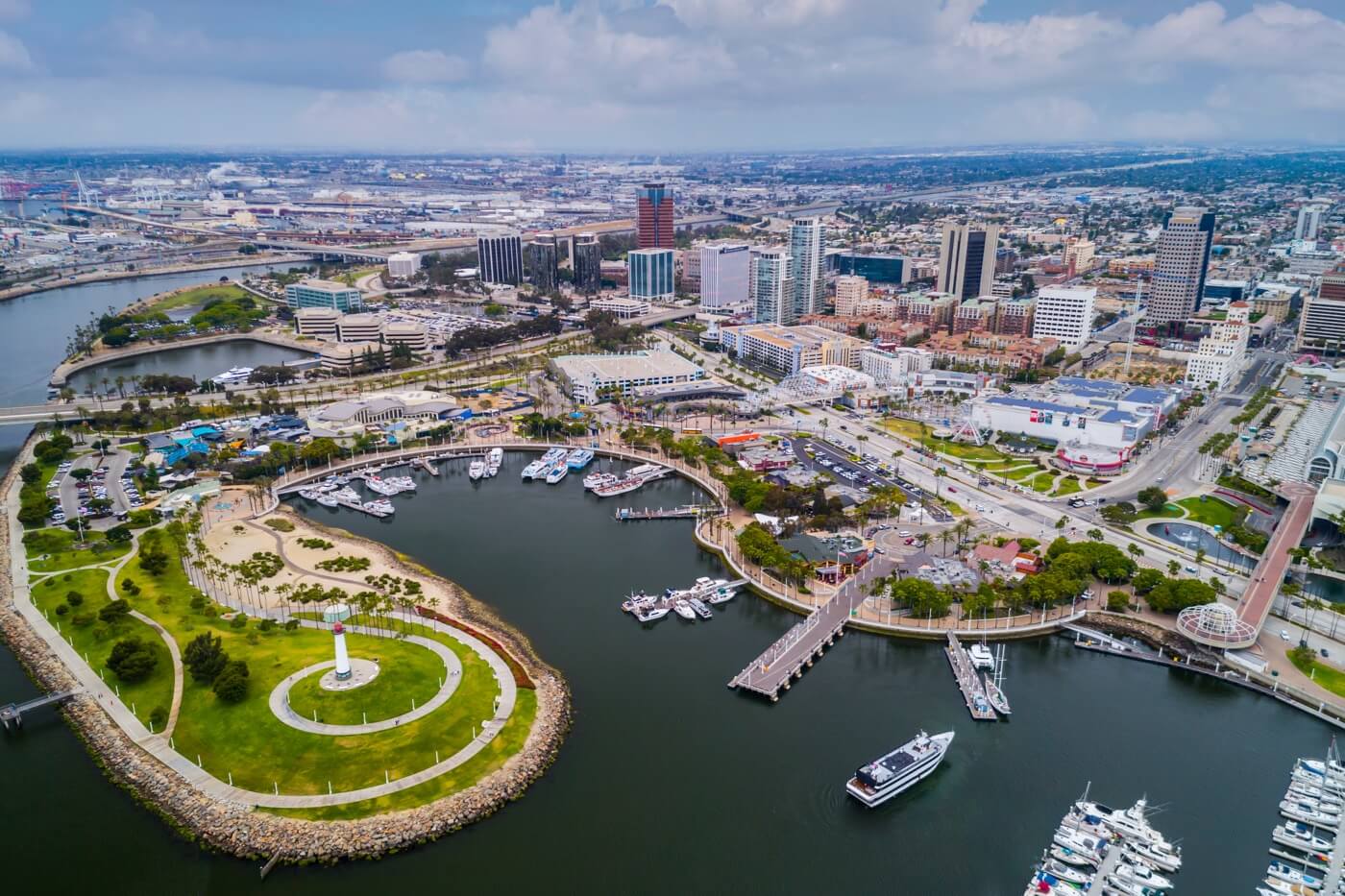
A really popular destination for liveaboards, Long Beach offers a large number of liveaboard locations that you can take advantage of. The nearby Channel Islands make a nice destination for sailing trips and you can enjoy other water-based activities like scuba diving and kayaking too. This is a fantastic choice if you want to live in a place where it’s summer all year round.
The only drawback for living aboard in Long Beach is the waitlist for slips. Thanks to a restrictive cap of 10% for liveaboards in each marina, it can be tough to find a free space. There is no fee for putting in a ‘Liveaboard Request’ but you’ll need to be patient. If you have time to spare then the rewards are worth it and it’s a good option for practicality and a high quality of life. However, this destination is not for spur of the moment decisions!
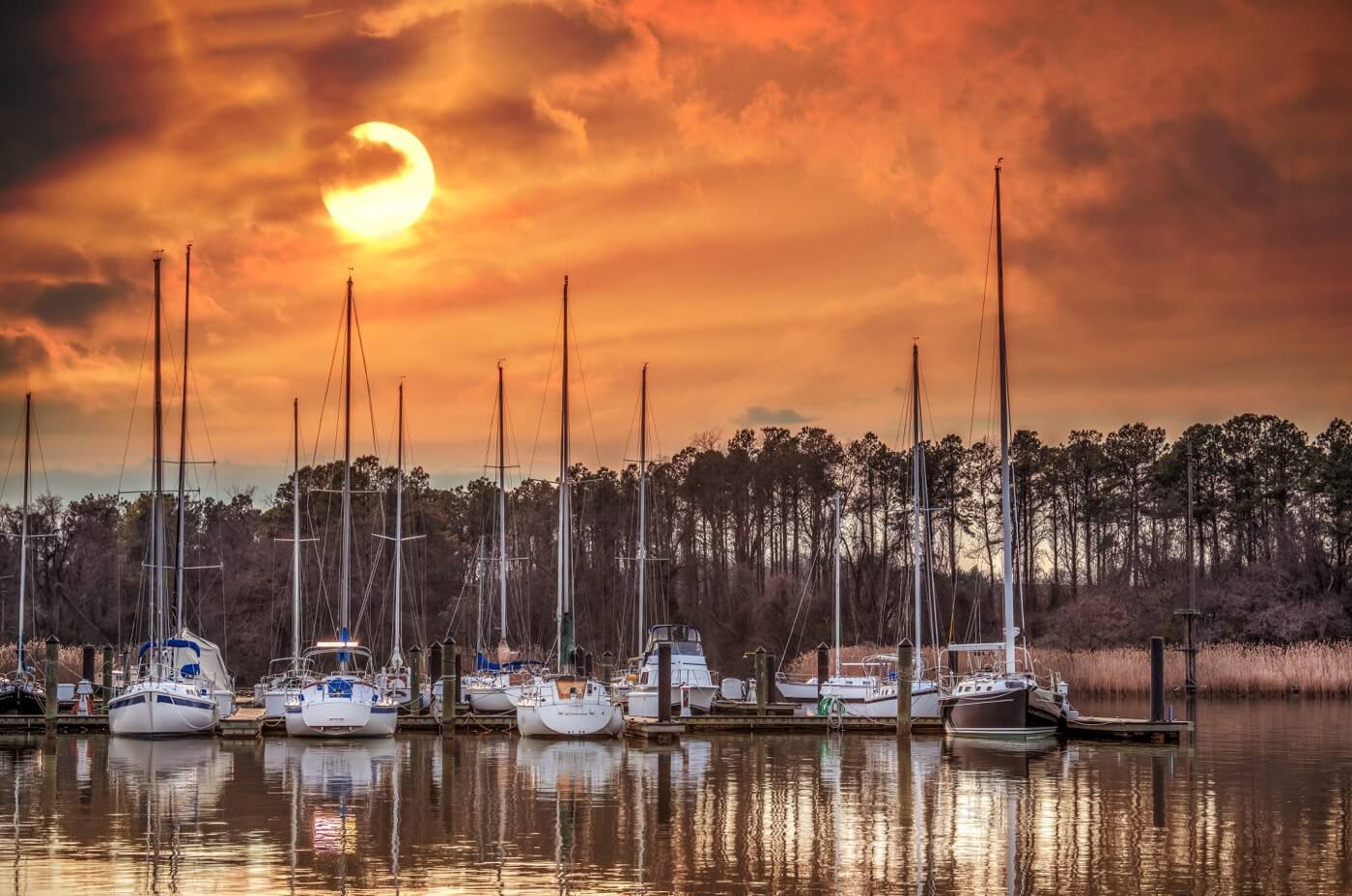
One of the most popular destinations for year-round living, Chesapeake Bay has a lot to offer liveaboards. From rich biodiversity to stunning sailing destinations nearby, there’s a whole range of reasons that this one is on the list. You can choose from a large number of different marinas around the Bay so it’s up to you if you prefer to live near Baltimore, Virginia Beach or anywhere else in the area. At the same time, the Bay offers protection against bad winter weather so it’s a practical choice for all seasons.
Prices can vary depending on where you go and how close you want to stay to urban areas. The starting point is around $300 per month and rates go up from there. For city living on board your boat, you’re going to pay between $5,000 to $8,000 a year here.

Long Island is the perfect choice for living aboard if you’re looking for plenty of destinations to sail to in your free time. You’re at the gateway to New England and can easily head to Connecticut, Rhode Island and Massachusetts in less than an hour. Of course, you can’t forget about New York City as well! Have you ever fancied sailing through Manhattan? It’s a challenging but rewarding cruise with plenty of iconic views along the way. Alternatively, head to The Hamptons for an upmarket experience in the destination of choice for wealthy city-dwellers during the summer.
Long Island itself is 100 miles long and 20 miles wide with bays and inlets, extending into the open ocean. This makes it an awesome destination for sailing, sight-seeing and living aboard. Unsurprisingly, prices are more expensive than others on this list at approximately $600 per month for a 40-foot slip.
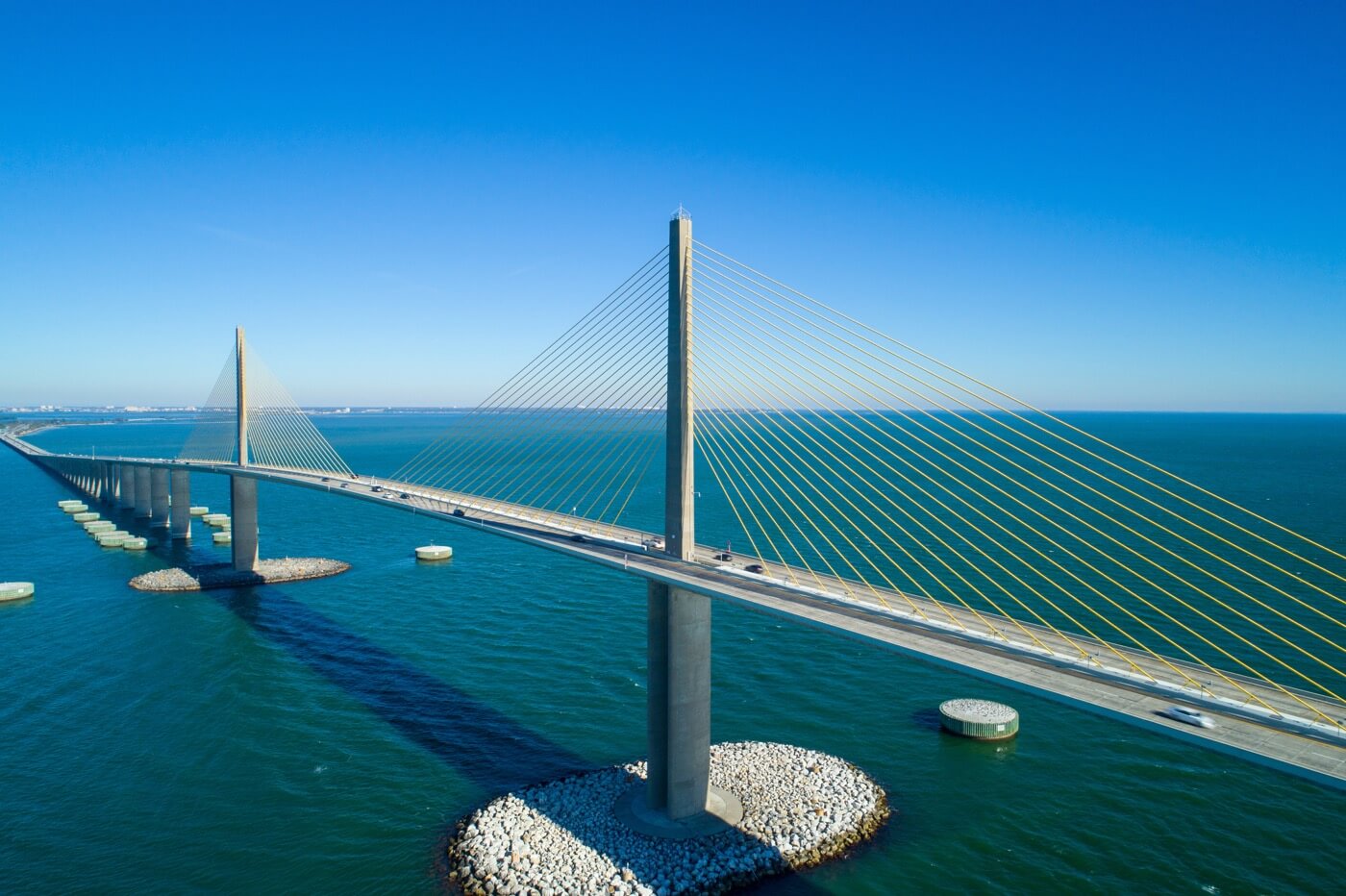
One of the biggest attractions for living aboard in Florida is the weather. You can’t beat the year long summer climate that makes really comfortable conditions for liveaboards. There’s a whole range of options if you’re looking to live aboard in Florida but Tampa Bay is an affordable choice compared to other locations closer to big cities. You’ll find a wide range of rates reflecting the location you choose.
In Tampa and neighboring St. Petersburg, you should be able to find marinas offering $500 per month for a 40-foot slip and other spots that are lower. The beauty of Tampa is that the waterfront is well developed with food, shopping and leisure options to keep you entertained. This means there’s no commute inland to get somewhere fun. Be warned, insurance can be high in Florida and local laws means there’s hoops you have to jump through in order to live on your boat. If you can take this in your stride than Florida makes a great choice.
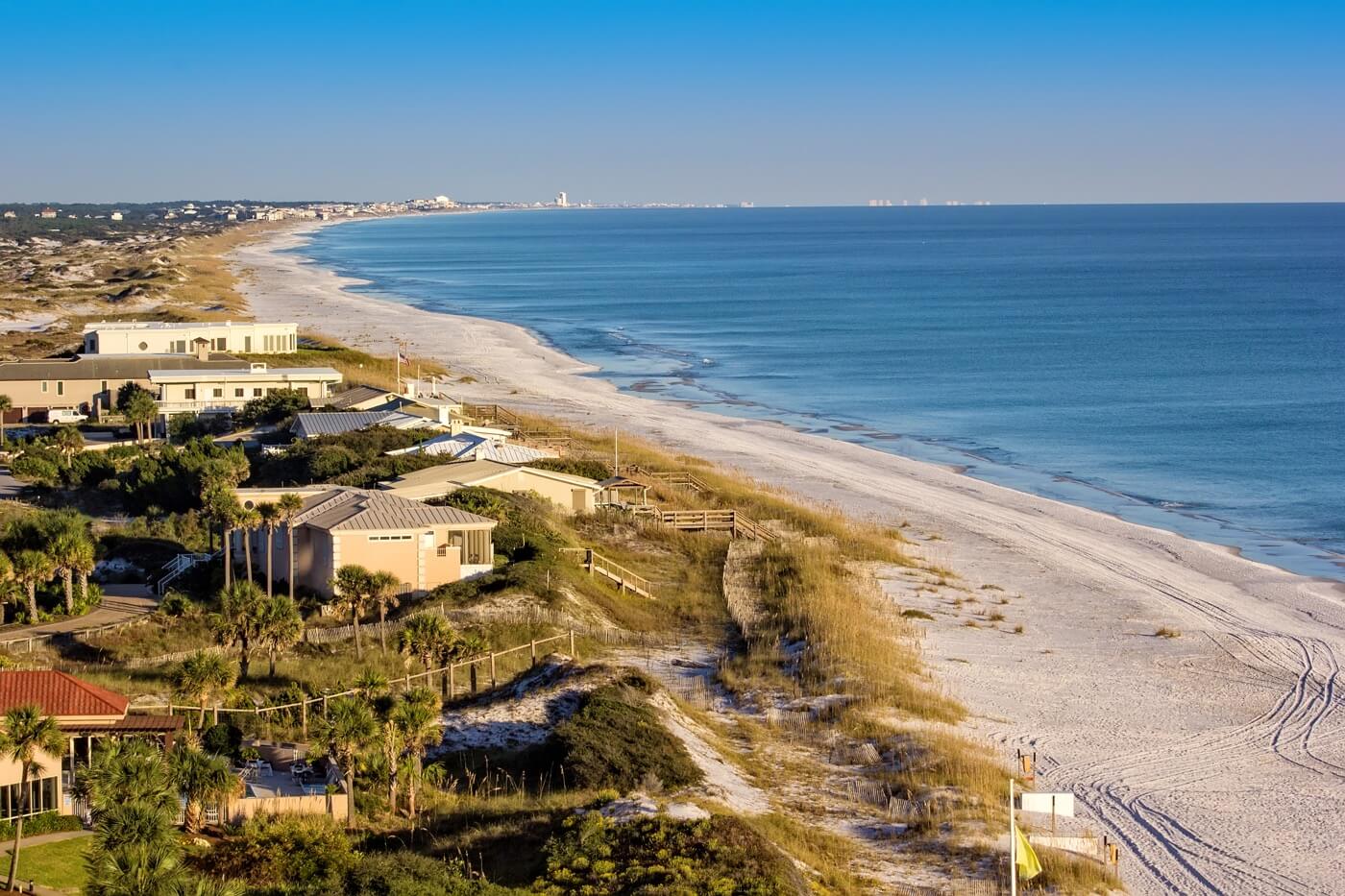
Staying with Florida, Destin is another blissful choice for would-be liveaboards who are looking for a relaxed, subtropical lifestyle. Destin’s beaches are one of the biggest draws for this location, as well as the number of barrier islands to explore. Located on the Panhandle of Florida, Destin is a paradise for leisure activities. The bay and Intracoastal Waterway is perfect for sailing beginners but getting out to the east Pass and the Gulf of Mexico is where the real fun begins. Tides, swells and cross-currents make it a challenging and exciting sailing destination.
The popularity of this destination makes Destin a more expensive choice. You will most likely have to go on a wait-list before you can find a slip. On the other hand, Florida is one of the states with the lowest taxes on boats so that can work in your favour. What’s more, Panama City is within easy reach of Destin for a weekend or head to Choctawhatchee Bay and discover the inland waterways and islands of the Santa Rosa Sound.
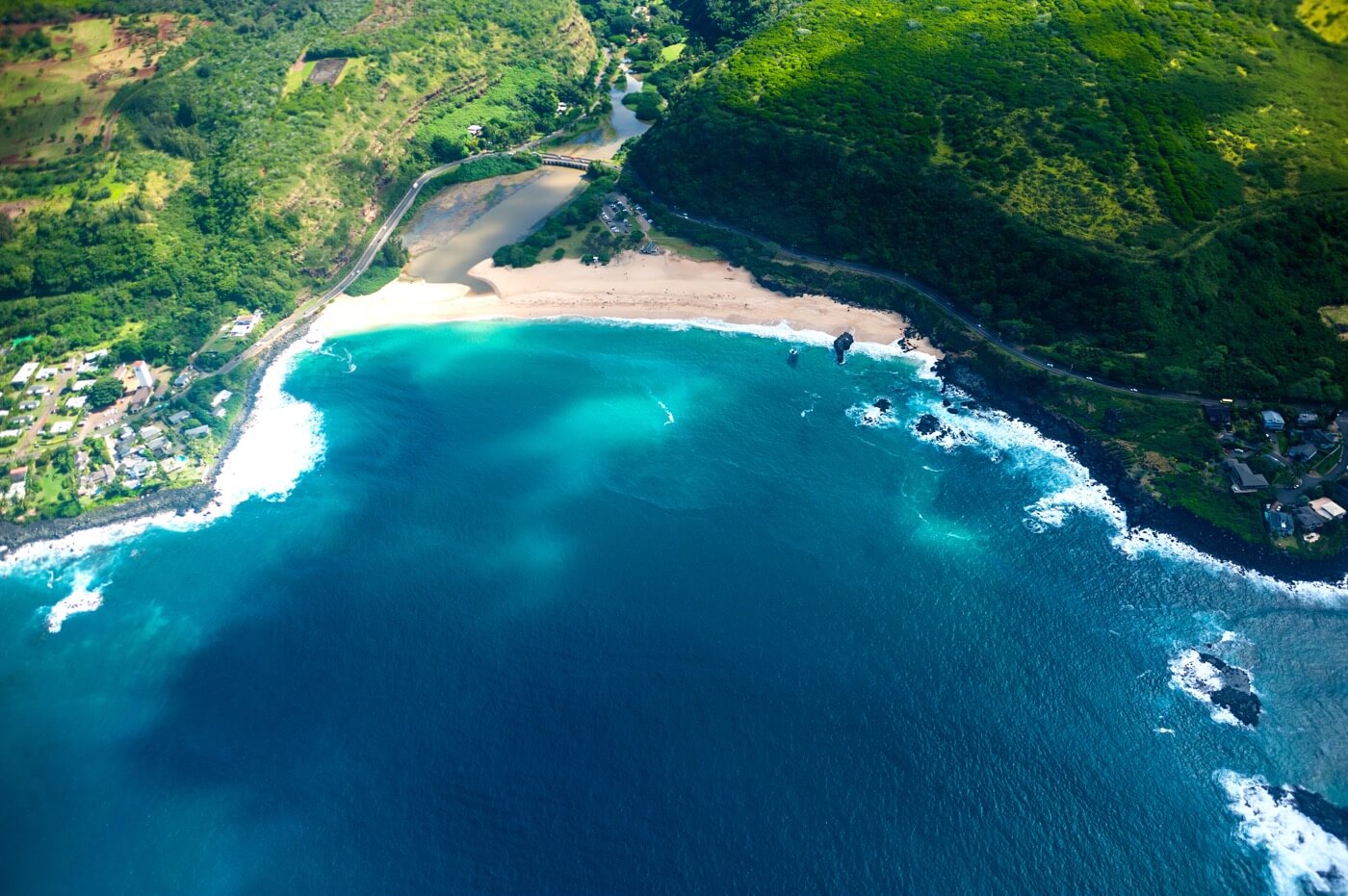
Hawaii is an awesome spot for sailing and the island of Maui is considered to be one of the best in the U.S. but Oahu island has a lot to offer liveaboard hopefuls. Honolulu may seem like an obvious choice but there are other options elsewhere on the island that offer practical alternatives. As with other sought-after locations, many of the liveaboard marinas on Oahu have long wait lists and it can be hard to find spaces for permanent stays. Some of the most popular options, including Haleiwa Harbour on the North Shore have wait times of up to 20 years! This is because it’s the only safe harbour on this shore.
If you can find a space, Hawaii life is worth it. From snorkelling to diving, the island life is truly tempting. In the summer months, you can sail to Waimea Bay and anchor on the sand for a romantic getaway. Thanks to the conditions, you can sail year-round and the infamous Hawaiian winds give you plenty to work with, ensuring you’ll never get bored.
Now the only question is, which destination will you choose?
lee rawlings
ahoy do you know list of low price live a boards in south florida, miami to port st lucie area
Katherine Lindell
Thinking about living aboard your boat in Hawaii? Don’t even go there. Hawaii is considered to be one of the worst sailing destinations in the country if not is the entire world. The entire boating scene in Hawaii is tightly controlled by the division of boating and ocean recreation, well known here to be corrupt and dysfunctional under the leadership of a certain Edward underwood, himself A stunning example of compromised agenda. You are currently not allowed to live anywhere in the state of Hawaii on board your vessel. And because the state’s government is so incredibly corrupt we don’t see this changing anytime soon.
Leave a comment
Living on a Boat Full Time: Ultimate Guide for Liveaboards

The fun, the sun, the family time, and the unmatched satisfaction of steering and operating a boat -- don’t you just wish it never had to end? Well, that wish has become an astounding reality for a lot of boat owners who tossed the lines and decided to become full time boaters. That’s right: the community of liveaboards is ever growing.
If you just can’t get enough of boating and it pains you to tether your trusty vessel to the dock at the end of the day, then maybe it’s high time you joined in on the bandwagon. Seriously contemplating living on a boat? Here’s everything you need to know.
Factors to Consider When Living on a Boat
Although you might already be romanticizing the idea of living on a boat, there are some serious considerations you have to make before you take that jump. Even some of the most experienced boaters will step away from the liveaboard life because of certain factors that just don’t work for their comfort, convenience, or preference.
Here are a few things you should consider before you make that big change:
Are You Prepared for Minimalist Living?
One of the biggest changes you’ll probably have to adjust to involves storage. Most liveaboard boats won’t have enough space onboard for lots of storage space, you’re going to have to live with bare minimum. That also entails frequent trips to the grocery store since you won’t have enough room to stock up for long periods of time.
Do You Know How to Perform Basic Repairs?
You’re going to encounter many different damages onboard especially during certain seasons. It helps to have some level of skill and knowledge when it comes to basic repairs so you won’t have to call a professional every time, especially when you’re too far away to find anyone to help.
What's the Weather Like?
Your local climate is going to play a role in how convenient (or how uncomfortable) your boat living situation is going to be. It’s usually not recommended for people who live in rainy regions, or those that experience severe winters to live permanently on a boat.
Is Your Family Prepared?
If you’ve got kids, then this is going to be a major change. Consider their daily route to school, and whether they’ll adjust to the new environment with comfort and ease. If you’ve got smaller kids that still like to run and play, there might not be enough room on deck to accommodate their rambunctious behavior.
Are You Willing to Give up Certain Appliances?
Washing machines, dryers, and elaborate home entertainment systems will not have a place on board most boats. Whether you’ve got a generator or a solar energy system, you probably won’t be able to supply enough power to sustain the entire range of household appliances you enjoy at home.
Where is Your Water Going to Come From?
Clean water for bathing and drinking can be tough to source when you’re living on a boat. Some boat owners install a system that lets them distill or purify water from the lake so they can safely use it for drinking and cleaning.
What About Waste Management?
You can’t just toss the contents of your portable toilet overboard. See to it that you know where your local waste management and disposal system is so you can access it whenever you need to safely and legally clean out your toilet. That also goes for whatever garbage you might accumulate on board.
Pros and Cons of Living on a Boat
Truth be told, liveaboard life isn’t for everyone. While it can be exciting and freeing, it also comes with its fair share of drawbacks that might be a little too inconvenient for those who are more comfortable and accustomed to living in a standard house.
- Opportunity to travel whenever you feel like it
- Usually more cost-effective than living in a standard house
- Forces you into an eco-friendly lifestyle
- Calmer lifestyle in touch with nature
- Deep sense of community
- Lots of time and money spent on maintenance
- Limited living space
- Susceptible to bad weather conditions
- Bugs and pests abound
- Compromised security and safety
Essentials for Living on a Boat
Because you might be used to living in a traditional house, converting to life on a boat can be a bit of a challenge. To make sure you’re ready for the undertaking, see to it that you have these basics taken care of:
Personal Items
You might have closets full of clothes, accessories, personal items, and just stuff you keep around but haven’t touched in years. Well, with the kind of limited storage space on a boat, you’re going to have to purge your closets of anything that isn’t essential.
Strip your closet down to just everyday wear, casual clothes, and maybe one or two formal outfits. You should try to do the same for your shoe closet. As for seasonal items like winter clothing, you can store them at a friend or relative’s house. If you have a locker at work, keep work clothes there.
Some liveaboards go as far as renting out a storage unit to keep all of the items they want to keep but might not be immediately necessary on board. Of course, you could also try to beef up your onboard storage by installing extra cabinets, but it’s probably not going to be enough.
Power Source
While your range of appliances might be particularly limited, that doesn’t mean you can’t have any onboard. Television sets, electric fans, mini refrigerators, and electric grills can find a rightful place on a boat - given there’s enough power to use them.
There are various services these days that offer to equip your vessel with solar energy for clean, easy power you can store up yourself. But of course, solar power can only take you so far when the stormy weather starts to settle in.
Shore power might be your best bet if you’re looking to fire up more energy-intensive appliances. See to it that your local marina will let you hook up to their power source while you’re docked. Of course, this also entails paying an extra fee.
Finally, you can try traditional fuel power with a generator. Keep in mind though that power generators tend to be noisy, which may disrupt your neighbors. There’s also the issue of cost and eco-friendliness which aren’t typical of a gas powered generator.
Maintenance Essentials
There’s going to be a whole lot of maintenance going on. Unlike a regular house, a boat is more exposed to the elements, which means it may be more susceptible to damage. That’s especially true if you won’t have the chance to dry dock your boat, leaving its hull soaked in water for extended periods of time.
Another thing to keep in mind are repairs. To some extent, you should know some basic electrical, plumbing, and mechanical skills to readily respond to minor damages as they occur. You’re also going to have to buy some reliable tools and cleaners that should always be within reach in case you need to fix something on your own.

Food Management
You can’t expect a boat to have a full-sized kitchen. And that also means you’re going to have to learn how to manage with a limited cooking space and amenities. For instance, you’re probably not going to be able to roast a full turkey for Thanksgiving .
Most of your liveaboard menu is probably going to consist of recipes that mainly entail the use of a grill. Fried and boiled entrees can also be a practical choice. That said, you’re also going to have to prepare sufficient surface area where you can prepare your ingredients, especially if you like coming up with elaborate dishes.
And then of course there’s the choice of food items in particular. If you’ve got a mini fridge on board, then you should be able to store a few veggies and meat for about a week max. Other than that though, most of your storage will be ice boxes that can only keep things cool for a certain period, unless you’re willing to replace ice cubes on the daily.
The Cost of Living on a Boat
Although the idea of living on a boat might be freeing, it’s anything but free. There are a ton of costs associated with the liveaboard life, which means you might spend just about as much as you would living in a traditional residence.
Here’s a breakdown of what you might expect to pay when you live on a boat:
Boat Mortgage
Roughly $500 for a $60,000 boat at 8.34% interest for 20 years.
Registration
This varies from state to state, ranging between $25 to $250 annually.
Boat Insurance
Insurance is in the range of $200 to $500 a year, depending on the extent of coverage, the kind and quality of boat, and its intended use.
Property Tax
6-10%, depending on the state you’re in.
Maintenance
According to experts, you should expect to pay 10% of your boat’s cost in maintenance fees each year. A $60,000 boat could cost you around $600 yearly to keep in shape.
Premier marinas can charge as much as $240 per foot per year. There are cheaper options though that can cost as little as $12 per foot per year, but that also means downgraded facilities.
Most boats will use 3-8 gallons per hour at cruising speeds, with gas costing between $3-4 per gallon. Also consider the cost of a power generator if you plan to use one.
Marinas and mooring points will charge for garbage removal, electricity, and water. Some also offer cable TV and WiFi connectivity that you can access for an added fee.
All of that of course, goes on top of the cost of food, clothes, and other personal essentials that you might require. It’s also worth mentioning that if you’ve got a bigger, more expensive boat, you also end up paying more than the estimates above. If you’re taking your family along with you, that becomes an added expense.
Other potential costs include storage fees if you’re planning to rent out a storage unit, winterization expenses, upgrades and accessories , and personal maintenance including laundry fees.
Safety and Security Considerations
Living on a boat isn’t any more or less safe than living in a traditional residence, it’s just that your concerns might be different. Understanding the potential dangers can help you better prepare for them and minimize the risk of accidents, injuries, and damages on board.
Sure, your boat might be parked just fine in a slip . But what about your car? Parking slots for cars in marinas aren’t usually secure, leaving your precious vehicle exposed to the elements and potential break-ins.
Consider beefing up your auto insurance to keep your car safe from these threats. You might also want to consider parking where there’s a CCTV system in place just for added safety.
Fire and Fumes
The limited space on a boat can make it extra prone to fires . You also have to think about gas leaks that could combust, or that could endanger your health with fumes.
Of course, the obvious solution would be to install smoke and CO2 sensors to tell you when there might be a potential threat. It’s also important to perform routine checks to ensure that everything is working fine.
Thefts and Burglaries
Houseboats are just as likely to experience robberies and break-ins as any traditional residence. And because the last thing you’d want is to have someone take anything from your already limited possessions, it’s important to take the necessary steps to protect your liveaboard.
Choose a marina with good security, well-lit premises, and CCTV systems installed. You can also install your own CCTV cameras as well as alarm systems to tell you of the presence of an intruder.
Emergencies and Accidents
Who are you going to call in case you run into a major accident that requires prompt mechanical service or medical care? While your family and friends might be a phone call away, it’s always better to know people at your local area who you can call for help.
See to it that you get contact information for your marina neighbors, the coast guard, and marina personnel. Have them at the ready in case you need to make a quick call during an emergency.
Social Life When Living on a Boat
The thing about the liveaboard life is that it’s way more social than the typical suburban household setting. For starters, your neighbors are going to be much closer to you than when you live in a traditional house. That’s also why people who live on their boats in marinas tend to enjoy a deep sense of community.
Living on a boat means helping those around you, and getting their help in return whether for small or significant things. If you’re not ready for that kind of social interaction and you prefer something a little more secluded, you can try tying your boat to an end corner where you’ll have fewer neighbors.
Some localities will also let you tie your boat to a mooring point where you’re not likely to have a lot of neighbors at all. Otherwise, be prepared to live closely alongside other liveaboards who might tether their boat next to yours.
What About Pets?
Of course, living on a boat doesn’t mean you can’t take old Fido with you. Although you might have to acclimate your dog or cat to the boat first, lots of boat owners have successfully transitioned to liveaboard life with their furbaby in tow.
As long as there’s a safe place for them to stay, and you give them enough time to run, play, and stay active onboard or on the shore, then it shouldn’t be a problem.
Best Places to Live on a Boat
While you might be accustomed to your locality already, there’s no reason you can’t move around once you start your liveaboard journey. That said, you might also want to consider whether you’d want to stay in a place that’s known for its liveaboard friendliness. Some of the best places to live aboard a boat include:
Chesapeake Bay, Maryland
Its warm climate and friendly boaters make it a wonderfully calm place to live. They’ve also got some of the best premier marinas in the state.
Lake of the Ozarks, Wisconsin
Beautiful, picturesque, and incredibly close to nature, the Lake of the Ozarks also has a number of prime locations and points of interest that you can access only via boat which says a lot about how boat friendly they are.
Corpus Christi, Texas
They’ve got great food and a wonderful ambiance that can be great for boaters looking for the perfect marriage between luxury and nature. Their marinas are also mostly new and polished, but since they’ve only recently been developed as a boating spot, prices aren’t too exorbitant just yet.
Is Boating for You?
It can be loads of fun to live on a boat. But again, it isn’t for everyone. There are some major adjustments that need to be made if you’re going to successfully transition to life on a boat. So how do you know if it’s not for you?
- Prefer living somewhere with lots of space
- You rely heavily on appliances, gadgets, electronic devices, and high speed internet
- Have a large family with lots of kids that all need their own personal space
- You’re not too handy and you have a hard time with doing repairs on your own
- Have a job that requires most of your daylight hours, leaving you with little time for maintenance and cleaning
- You enjoy a more private lifestyle where people won’t always be around to hear or see what you’re up to
Time for a Change
Living on a boat can be loads of fun, but it’s going to require some major changes. So are you ready to dive in head first? See to it that you’ve got all the basics down, and maybe try it yourself for a week to see how you fair. Of course, it’s going to be rocky at the start. But with proper execution, you should be able to transition to that liveaboard lifestyle in no time.
Related Posts

Average Boat Engine Hours (How Many Hrs Are A Lot or Too Many?)
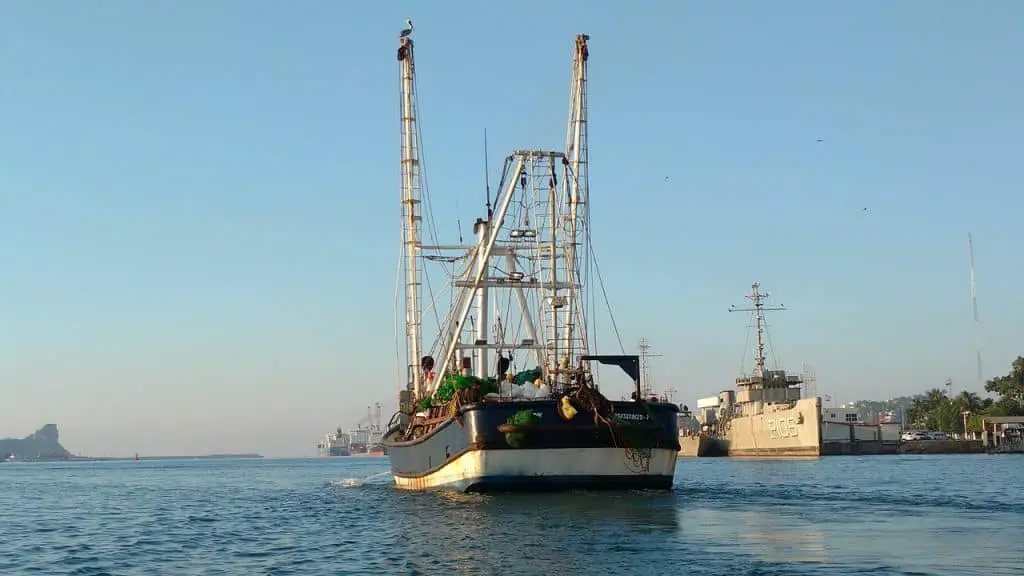
How Do Shrimp Boats Work? A Complete Guide

14 Pontoon Boat Gift Ideas for Buying a Present for a ‘Tooner

What Should You Do If the Motor on Your Boat Catches Fire?
Morning Rundown: Obamas take shots at Trump, video shows storm sinking Sicily yacht, and most Americans in a decade on the job hunt

New effort to protect workers who struggle in stifling heat

Will ruby slippers from 'The Wizard of Oz' be returned to their home?

Blinken works to achieve Gaza cease-fire as Israel recovers 6 hostages

Trump campaign blitzes battleground states

Obamas to address Democratic convention in hometown Chicago

New security concerns in Chicago after protesters break through barricade
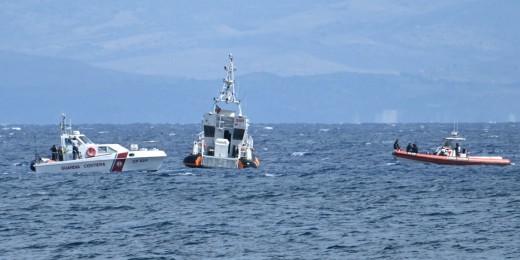
Search intensifies after sinking of superyacht with Americans on board

Harris campaigns in Milwaukee at site of Republican convention

New 'parole in place' program takes effect for some undocumented migrants

Blinken makes new push for Gaza cease-fire deal

Former Rep. George Santos agrees to plea deal

Pioneering talk show host Phil Donahue dies at 88

Deadly flooding emergency in parts of the Northeast

Americans among missing after luxury sailing yacht sinks off Sicily

U.S. intelligence officials say Iran targeted the Trump campaign with hacking operation

Thousands protest near Democratic convention

Democratic convention kicks off with Biden valedictory speech

Nonprofit raises millions for dogs with special needs

Police are investigating a violent beating caught on camera outside a D.C.-area Shake Shack

An inside look into the operation to find missing children
Nightly news.
The Italian Coast Guard said it is searching for six people, including Americans, who were aboard a luxury yacht that sank off the coast of Sicily in a storm. The missing also included a British tech tycoon. Fifteen people were saved, including a 1-year-old child. NBC News' Steve Patterson reports. Aug. 19, 2024
Best of NBC News

Putin visits Chechnya and meets troops and volunteers readying to fight Ukraine

Watch: Police raid Andrew Tate's Bucharest residence
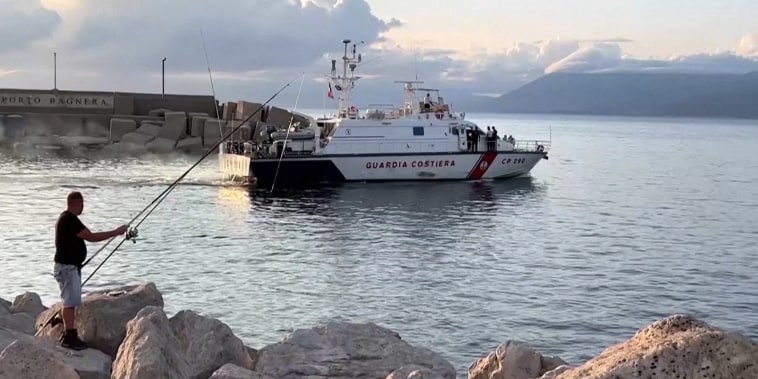
Expert calls superyacht sinking a 'black swan' event as search continues off Sicily

Iran warns Israel that retaliation will come at a time of Tehran's choosing

Watch highlights from Night 2 of the Democratic National Convention in 3 minutes

NBC News NOW
Obama praises biden for 'defending democracy' in dnc remarks.
- Eye on the Tropics
- Back to School
- Trending Now (Opens in new window)
- Central Florida Spotlight
- Entertainment
- Politics and Elections
- Space and Technology
- Central Florida Gets Real
- 9 in Your Neighborhood
- Hour by Hour
- Watch Live: WFTV Now
- WFTV 24/7 News
- Weather 24/7
- The $pend $mart Stream
- Law & Crime
- Curiosity NOW
- 9 Investigates
- Steals and Deals (Opens in new window)
- TV 27 Community Connection
- Forever Family
- Uplifting News (Opens in new window)
- Health & Wellness
- Summer Guide
- Care Connect
- WFTV's Law Talk
- Home Experts
- Central Florida Guide (Opens in new window)
- The Daily Two
- Advertise With Us
- Meet Our Team
- Submit a Tip (Opens in new window)
- WFTV Mobile Apps (Opens in new window)
- Newsletter Sign-up (Opens in new window)
- WFTV Listings
- TV 27 TV Listings
- Jobs at WFTV/WRDQ (Opens in new window)
- WFTV Member Help
- Visitor Agreement
- Privacy Policy
- Share Your Pics!
What is known about the sinking of a luxury yacht off the coast of Sicily and those aboard
Italy Boaters Missing Emergency services at the scene of the search for a missing boat, in Porticello, southern Italy, Tuesday, Aug. 20, 2024. Rescue teams and divers returned to the site of a storm-sunken superyacht Tuesday to search for six people, including British tech magnate Mike Lynch, who are believed to be still trapped in the hull 50 meters (164-feet) underwater. (AP Photo/Salvatore Cavalli) (Salvatore Cavalli/AP)
PORTICELLO, Sicily — (AP) — Specialist cave divers working in 12-minute underwater shifts were searching Tuesday for six missing passengers and crew, including British tech tycoon Mike Lynch, believed to be in the submerged wreck of a luxury yacht that was slammed by a powerful storm and swiftly sank off Sicily.
The sleek yacht, named the Bayesian, was carrying a crew of 10 people and 12 passengers when it suddenly sank near the Mediterranean island that is part of Italy at about 4 a.m. on Monday. One body has been recovered and 15 people survived.
Fire rescue officials have said the six believed to remain in the sailboat's hull will be considered missing until they are located in the wreckage.
Here's what we know so far about the sinking and those who were on board.
Italian civil protection officials believe a sudden and fierce storm that battered the coast of Sicily in the early hours of Monday whipped up a waterspout in the exact spot where the 56-meter (184-foot) British-flagged Bayesian was moored.
Karsten Borner, the captain of another yacht moored nearby, said he saw the Bayesian during the storm but when the wild weather passed it was gone and he saw only a red flare lighting the night sky, the Italian news agency ANSA and the Giornale di Sicilia newspaper reported.
Borner and one of his crew boarded their tender and found a lifeboat carrying 15 people, some of them injured. They took them aboard their yacht and alerted the coast guard.
Rescue authorities said the wreck was resting at a depth of 50 meters (163 feet) about a half mile offshore of the picturesque fishing village of Porticello.
Among the missing is 59-year-old tech tycoon Mike Lynch , sometimes described as the British Bill Gates. Lynch was acquitted in June of all charges in a U.S. fraud trial linked to the $11 billion sale of his software company Autonomy to Hewlett-Packard in 2011.
Lynch still faced a potentially huge bill stemming from a civil case in London that HP mostly won during 2022. Damages haven’t been determined in that case, but HP is seeking $4 billion. Lynch made more than $800 million from the Autonomy sale.
A Cambridge-educated mathematician, Lynch made his name running Autonomy, which made a search engine that could pore through emails and other internal business documents to help companies find vital information more quickly.
Lynch’s 18-year-old daughter Hannah was reportedly among the missing. His wife, Angela Bacares, and 14 other people survived.
Among others still missing Tuesday, according to the civil protection agency, were one of Lynch’s U.S. lawyers, Christopher Morvillo of Clifford Chance, and Morvillo’s wife, Neda. Morvillo was regarded as an elite defense lawyer and was also a federal prosecutor in New York after 9/11.
Also missing was Jonathan Bloomer, the non-executive chairman of Morgan Stanley International, and his wife, Judy. He is the former head of the Autonomy audit committee and testified for the defense at Lynch’s trial.
Bloomer was also chair of the Hiscox Group, an insurer that does business on the Lloyd’s of London market.
“We are deeply shocked and saddened by this tragic event,” Hiscox CEO Aki Hussain said in a statement.
Among the survivors was Charlotte Golunski, who said she momentarily lost hold of her 1-year-old daughter Sofia in the water, but then managed to grab her and hold her up over the waves until a lifeboat inflated and they were both pulled to safety, ANSA reported. The father, identified by ANSA as James Emslie, also survived.
The Dutch foreign ministry said a Dutch man survived. The ministry, citing privacy, did not release his identity.
One body was recovered on Monday, identified as the on-board chef.
The Bayesian was a luxury yacht built in 2008 by the Italian firm Perini Nav. It was known for its single 75-meter (246-feet) aluminum mast — one of the world’s tallest. Online charter sites listed it for rent for up to 195,000 euros (about $215,000) a week.
Its registered owner is listed as Revtom Ltd., based on the Isle of Man, according to online maritime database Equasis. Lynch’s wife is listed as Revtom’s sole owner, according to corporate registration documents from the Isle of Man.
The yacht's name is an apparent reference to “Bayesian inference,” one of the two main approaches to statistical machine learning and the one that was used by Autonomy.
Waterspouts are tornadoes that form over water and can happen when a storm moves across warm water.
According to the U.S. National Ocean Service, there are two types of waterspouts — fair-weather and tornadic.
Tornadic waterspouts “have the same characteristics as a land tornado. They are associated with severe thunderstorms, and are often accompanied by high winds and seas, large hail, and frequent dangerous lightning,” the service says on its website.
While scientists haven't attributed the specific event to climate change, average monthly surface temperatures have been at record highs for months . Hotter air can hold more moisture, making heavier storms more likely.
Sicily has been baking under intense heat this summer , and the United Nations' panel of climate change experts notes the Mediterranean Sea is particularly vulnerable to climate change, with warming rates roughly 20% higher than the global average.
Experts say it is extraordinarily rare for a luxury sailboat of this size to capsize due to weather events.
“This just doesn’t happen. You know, boats sink because things like keels fall off, or they run aground and breach the hull ... whereas just from a weather angle, a boat that big being pushed over on its side is absolutely extraordinary,” said Skip Novak, a lifelong sailor who has taken part in multiple round the world yacht races and written books about sailing.
Novak said he believed that strong gusts likely pushed the yacht over 90 degrees to its side, and the vessel did not recover because of the weight of the huge mast and because it was anchored. He suggested that internal doors were likely not closed, and water quickly poured in to sink the vessel.
“When you’re at anchor, even if it’s blowing with a storm in the Mediterranean, you rarely shut the whole boat down because nobody expects something like this to happen," Novak told The Associated Press. “So if the boat wasn’t completely watertight at the deck, you’d have flooding going in. It would take a couple minutes and that would be it."
As the search for the missing continues, authorities already have begun trying to piece together exactly what happened.
Prosecutors from the Sicilian town of Termini Imerese have opened an investigation, as is normal in such events even when no suspects are identified. To date, they have not commented publicly.
The British Marine Accident Investigation Branch said four of its inspectors were being deployed to Palermo.
Corder reported from The Hague, Netherlands. Associated Press writer Sylvia Hui in London contributed to this report.
Copyright 2024 The Associated Press. All rights reserved. This material may not be published, broadcast, rewritten or redistributed without permission.
:quality(70)/cloudfront-us-east-1.images.arcpublishing.com/cmg/7DOC5DEBGVHXJADO4SZ4XL7P7Q.jpg)
2024 Florida Primary: Elections results
:quality(70)/cloudfront-us-east-1.images.arcpublishing.com/cmg/XYEYIJJ2R5BRLIQDY5XLENE32Q.jpg)
2024 Florida Primary: Some Florida elections supervisor websites restored after ‘cyber incident’
:quality(70)/cloudfront-us-east-1.images.arcpublishing.com/cmg/XYEYIJJ2R5BRLIQDY5XLENE32Q.jpg)
Elections websites restored following ‘cyber incident’ in most Florida counties
:quality(70)/cloudfront-us-east-1.images.arcpublishing.com/cmg/U3HNYAT5BZE27K74K4PORV53WE.jpeg)
COVID surge: What is KP.3.1.1, its signs, symptoms
:quality(70)/cloudfront-us-east-1.images.arcpublishing.com/cmg/7K6GEG5A5NBZ7BUCJC47FK2DDM.jpg)
Popular downtown Winter Park restaurant to reopen
What is known about the sinking of a luxury yacht off the coast of Sicily and those aboard
Specialist cave divers working in 12-minute underwater shifts are searching for six missing passengers and crew, including British tech tycoon Mike Lynch, believed to be in the submerged wreck of a luxury yacht that was slammed by a powerful storm and ...
PORTICELLO, Sicily -- Specialist cave divers working in 12-minute underwater shifts were searching Tuesday for six missing passengers and crew, including British tech tycoon Mike Lynch, believed to be in the submerged wreck of a luxury yacht that was slammed by a powerful storm and swiftly sank off Sicily.
The sleek yacht, named the Bayesian, was carrying a crew of 10 people and 12 passengers when it suddenly sank near the Mediterranean island that is part of Italy at about 4 a.m. on Monday. One body has been recovered and 15 people survived.
Fire rescue officials have said the six believed to remain in the sailboat's hull will be considered missing until they are located in the wreckage.
Here's what we know so far about the sinking and those who were on board.
Italian civil protection officials believe a sudden and fierce storm that battered the coast of Sicily in the early hours of Monday whipped up a waterspout in the exact spot where the 56-meter (184-foot) British-flagged Bayesian was moored.
Karsten Borner, the captain of another yacht moored nearby, said he saw the Bayesian during the storm but when the wild weather passed it was gone and he saw only a red flare lighting the night sky, the Italian news agency ANSA and the Giornale di Sicilia newspaper reported.
Borner and one of his crew boarded their tender and found a lifeboat carrying 15 people, some of them injured. They took them aboard their yacht and alerted the coast guard.
Rescue authorities said the wreck was resting at a depth of 50 meters (163 feet) about a half mile offshore of the picturesque fishing village of Porticello.
Among the missing is 59-year-old tech tycoon Mike Lynch , sometimes described as the British Bill Gates. Lynch was acquitted in June of all charges in a U.S. fraud trial linked to the $11 billion sale of his software company Autonomy to Hewlett-Packard in 2011.
Lynch still faced a potentially huge bill stemming from a civil case in London that HP mostly won during 2022. Damages haven’t been determined in that case, but HP is seeking $4 billion. Lynch made more than $800 million from the Autonomy sale.
A Cambridge-educated mathematician, Lynch made his name running Autonomy, which made a search engine that could pore through emails and other internal business documents to help companies find vital information more quickly.
Lynch’s 18-year-old daughter Hannah was reportedly among the missing. His wife, Angela Bacares, and 14 other people survived.
Among others still missing Tuesday, according to the civil protection agency, were one of Lynch’s U.S. lawyers, Christopher Morvillo of Clifford Chance, and Morvillo’s wife, Neda. Morvillo was regarded as an elite defense lawyer and was also a federal prosecutor in New York after 9/11.
Also missing was Jonathan Bloomer, the non-executive chairman of Morgan Stanley International, and his wife, Judy. He is the former head of the Autonomy audit committee and testified for the defense at Lynch’s trial.
Bloomer was also chair of the Hiscox Group, an insurer that does business on the Lloyd’s of London market.
“We are deeply shocked and saddened by this tragic event,” Hiscox CEO Aki Hussain said in a statement.
Among the survivors was Charlotte Golunski, who said she momentarily lost hold of her 1-year-old daughter Sofia in the water, but then managed to grab her and hold her up over the waves until a lifeboat inflated and they were both pulled to safety, ANSA reported. The father, identified by ANSA as James Emslie, also survived.
The Dutch foreign ministry said a Dutch man survived. The ministry, citing privacy, did not release his identity.
One body was recovered on Monday, identified as the on-board chef.
The Bayesian was a luxury yacht built in 2008 by the Italian firm Perini Nav. It was known for its single 75-meter (246-feet) aluminum mast — one of the world’s tallest. Online charter sites listed it for rent for up to 195,000 euros (about $215,000) a week.
Its registered owner is listed as Revtom Ltd., based on the Isle of Man, according to online maritime database Equasis. Lynch’s wife is listed as Revtom’s sole owner, according to corporate registration documents from the Isle of Man.
The yacht's name is an apparent reference to “Bayesian inference,” one of the two main approaches to statistical machine learning and the one that was used by Autonomy.
Waterspouts are tornadoes that form over water and can happen when a storm moves across warm water.
According to the U.S. National Ocean Service, there are two types of waterspouts — fair-weather and tornadic.
Tornadic waterspouts “have the same characteristics as a land tornado. They are associated with severe thunderstorms, and are often accompanied by high winds and seas, large hail, and frequent dangerous lightning,” the service says on its website.
While scientists haven’t attributed the specific event to climate change, average monthly surface temperatures have been at record highs for months . Hotter air can hold more moisture, making heavier storms more likely.
Sicily has been baking under intense heat this summer , and the United Nations’ panel of climate change experts notes the Mediterranean Sea is particularly vulnerable to climate change, with warming rates roughly 20% higher than the global average.
Experts say it is extraordinarily rare for a luxury sailboat of this size to capsize due to weather events.
“This just doesn’t happen. You know, boats sink because things like keels fall off, or they run aground and breach the hull ... whereas just from a weather angle, a boat that big being pushed over on its side is absolutely extraordinary,” said Skip Novak, a lifelong sailor who has taken part in multiple round the world yacht races and written books about sailing.
Novak said he believed that strong gusts likely pushed the yacht over 90 degrees to its side, and the vessel did not recover because of the weight of the huge mast and because it was anchored. He suggested that internal doors were likely not closed, and water quickly poured in to sink the vessel.
“When you’re at anchor, even if it’s blowing with a storm in the Mediterranean, you rarely shut the whole boat down because nobody expects something like this to happen," Novak told The Associated Press. “So if the boat wasn’t completely watertight at the deck, you’d have flooding going in. It would take a couple minutes and that would be it."
As the search for the missing continues, authorities already have begun trying to piece together exactly what happened.
Prosecutors from the Sicilian town of Termini Imerese have opened an investigation, as is normal in such events even when no suspects are identified. To date, they have not commented publicly.
The British Marine Accident Investigation Branch said four of its inspectors were being deployed to Palermo.
Corder reported from The Hague, Netherlands. Associated Press writer Sylvia Hui in London contributed to this report.
Trending Reader Picks

What economists think of Harris' economic agenda
- Aug 16, 4:12 PM

4 children found shot in stolen car
- Aug 19, 12:52 PM

Phil Donahue, former TV talk show host, dead at 88
- Aug 19, 5:55 PM

Man goes missing while on vacation
- Aug 20, 5:18 PM

Airport conveyor belt cause of death revealed
- Aug 9, 8:42 PM
ABC News Live
24/7 coverage of breaking news and live events
Superyacht sinks latest: Underwater drone deployed to yacht; captain 'questioned for more than two hours'
Search efforts have entered a third day for six tourists missing after a yacht sank off the Sicily coast. The captain has reportedly been questioned by Italian prosecutors over the sinking. Experts hope air pockets may offer a chance of survival. Listen to a Daily podcast as you scroll.
Wednesday 21 August 2024 13:52, UK
- Superyacht sinking
- Search for six missing people enters third day after superyacht sinks off Sicily
- Advanced underwater drone deployed
- Yacht's captain questioned for more than two hours - report
- Missing's brother hopes air pockets offer chance for survival
- 'World of objects' stand in way of divers - as strategy formed
- Watch: CCTV captures yacht seconds before it sinks
- Six missing - including tech boss, Morgan Stanley executive and top lawyer
- Explained: What causes waterspouts? | Inside the superyacht
- Listen to the Daily podcast above and tap here to follow wherever you get your podcasts
- Live reporting by Brad Young and Henry Vaughan
The yacht's captain was questioned for more than two hours by prosecutors who have opened an investigation into the shipwreck, according to reports
James Cutfield, 51, who is from New Zealand, was quizzed until late yesterday evening to help reconstruct what happened and provide useful technical details, reports the Italian news agency ANSA.
His brother Mark earlier told the New Zealand Herald he was a "very good sailor" and "very well respected" in the Mediterranean.
Magistrates are said to be also questioning the survivors inside the Domina Zagarella hotel in Santa Flavia, where they are staying.
Divers who took part in rescue missions during the Costa Concordia cruise ship tragedy have arrived in Porticello to aide the search for the six missing Bayesian tourists, reports Giornale Di Sicilia
Their expertise has been called upon to help open and inspect passenger cabins, where the tourists were thought to be trapped by furniture and other objects on board the yacht.
More than 4,000 passengers and crew were onboard the Costa Concordia when it struck rocks in January 2012, causing a 70-metre gash that allowed water to pour in.
The ship eventually capsized and came to rest on its side at a location known as Seagull Point, just outside the harbour on the island of Giglio, Italy.
Some 32 people died and 157 passengers suffered from post-traumatic stress.
The search for the six people still missing still feels like a rescue operation rather than a salvage operation, former Royal Navy submarine captain Ryan Ramsey tells Sky News.
He describes the "incredible pressure" at the site of the wreck, nearly 50m underwater, with the dark and cold further hampering the work of the divers.
"It's very risky," he says and believes the operation is moving into a different stage because the short spells by dive teams are not working.
Underwater drones have now been deployed (see post at 11.37am), which Mr Ramsey describes as "amazing pieces of technology".
He says while air pockets still provide hope that more survivors will be found the "build up of carbon dioxide that you're breathing out will eventually kill you".
Images show boats carrying search and rescue crews returning to Porticello Harbour.
Divers and underwater drones have been searching for the six missing people this morning.
Meanwhile, a new picture of the Bayesian superyacht that sank on Monday has also emerged.
Another of the 15 survivors has been confirmed as Dutch national Tjis Koopmans.
Mr Koopmans, pictured in a white shirt leaving the coastguard headquarters on Monday, is thought to have been a member of the crew.
The yacht was carrying 10 crew members and 12 passengers when it capsized.
One crew member was confirmed dead: Chef Recaldo Thomas, a Canadian-Antiguan national.
Six passengers remain missing.
Divers have reached the area where the cabins are located, according to reports.
The spaces inside the ship are extremely narrow and difficult to manoeuvre within, Italian news outlet Corriere Della Sera said.
Objects floating in the water have made it "difficult to fully explore the cabins".
As such, there is no news as of yet on the missing tourists, who are thought to be inside the cabins, the media site reported.
Solo round-the-world yachtsman Tony Bullimore survived for four days by sheltering in an air pocket when his vessel capsized in the Southern Ocean in 1997.
His yacht, the Global Exide Challenger, was one of two to capsize in rough seas about 900 miles from Antarctica and 1,400 miles from the Australian coast during the Vendee Globe race.
He survived for four days in an air pocket inside the upturned hull with just a bar of chocolate and some fresh water for sustenance.
Experts have speculated air pockets could have formed as the Bayesian superyacht sank during a storm off the coast of Sicily (see post at 6.30am).
Mr Bullimore swam out from underneath the vessel after crewmen from the Australian Navy frigate HMAS Adelaide banged on the hull.
The former Royal Marine, who died in 2018 aged 79, suffered mild hypothermia, a fractured tooth, abrasions to his hands, frostbite on his forehead and fingertips, and moderate dehydration.
An upgraded underwater drone has been deployed at the site of the wreckage.
Earlier, the Italian coast guard reported it was using a drone with a two-hour underwater capability on the seabed, 50m deep.
The new robot can stay underwater for six to seven hours at a depth of 300m.
By comparison, divers who can only remained submerged at that depth for around 12 minutes.
The drone can record detailed videos and images, and will be used to reconstruct the accident for the Italian public prosecutor's office.
A team of four British inspectors from the Marine Accident Investigation Branch (MAIB) has arrived in Porticello, where they are expected to look at the site where the yacht sank.
They will carry out a "preliminary assessment" today, after arriving yesterday, PA reports.
They are looking into the incident because the Bayesian was flying a British flag - but the Italian Coastguard said the MAIB was not involved in the search and that it did not request assistance.
Spokesman Vincenzo Zagarola said: "Even if they come... the searches are carried out by the Italian authorities. Initiative [was] not requested by us."
A remote-controlled underwater vehicle (ROV) is being used to help with the search for the missing.
The depth of the wreck means divers can only spend around 12-minutes underwater - some of which is used just to descend or ascend.
They are also being hampered by the amount of furniture and other debris in the boat.
The ROV, however, is capable of operating on the seabed autonomously for more than two hours, according to the Italian Coast Guard.
Marine investigator James Wilkes earlier told Sky News (see 9.15am post) the vehicle will be able to scan the wreck and use CCTV to find an access point.
This will make diving and the recovery of any bodies that may be in the yacht much safer for the dive teams.
Be the first to get Breaking News
Install the Sky News app for free

Stay up to date with notifications from The Independent
Notifications can be managed in browser preferences.
UK Edition Change
- UK Politics
- News Videos
- Paris 2024 Olympics
- Rugby Union
- Sport Videos
- John Rentoul
- Mary Dejevsky
- Andrew Grice
- Sean O’Grady
- Photography
- Theatre & Dance
- Culture Videos
- Fitness & Wellbeing
- Food & Drink
- Health & Families
- Royal Family
- Electric Vehicles
- Car Insurance Deals
- Lifestyle Videos
- UK Hotel Reviews
- News & Advice
- Simon Calder
- Australia & New Zealand
- South America
- C. America & Caribbean
- Middle East
- Politics Explained
- News Analysis
- Today’s Edition
- Home & Garden
- Broadband deals
- Fashion & Beauty
- Travel & Outdoors
- Sports & Fitness
- Climate 100
- Sustainable Living
- Climate Videos
- Solar Panels
- Behind The Headlines
- On The Ground
- Decomplicated
- You Ask The Questions
- Binge Watch
- Travel Smart
- Watch on your TV
- Crosswords & Puzzles
- Most Commented
- Newsletters
- Ask Me Anything
- Virtual Events
- Wine Offers
- Betting Sites
Thank you for registering
Please refresh the page or navigate to another page on the site to be automatically logged in Please refresh your browser to be logged in
Mike Lynch yacht latest: Divers try to reach sleeping cabins of Bayesian as families hope for air pockets
Missing six could be alive if they are trapped with an air pocket, claims engineer, article bookmarked.
Find your bookmarks in your Independent Premium section, under my profile

For free real time breaking news alerts sent straight to your inbox sign up to our breaking news emails
Sign up to our free breaking news emails, thanks for signing up to the breaking news email.
Search crews have carried out further inspections of a sunken luxury yacht, accessing the hull if the Bayesian as they continue to search for six people.
Six people remain missing after the boat sank in a severe storm in the early hours of Monday , including British billionaire Mike Lynch and his daughter Hannah, Morgan Stanley chairman Jonathan Bloomer ; his wife, Judy Bloomer; Clifford Chance lawyer Chris Morvillo; and his wife, Neda Morvillo.
Fire crews described the operation as “complex”, with divers limited to 12-minute underwater shifts, with debris reportedly hampering efforts to access the cabins.
The brother of Mr Bloomer has shared his hopes that air pockets might be keeping them alive.
Jeremy Bloomer said: “It’s a slow process and it will take time. So there might be air pockets, but we don’t know. It’s still wait and see, so fingers crossed.”
Divers from the Sicilian fire services were able to reach the common areas of the vessel, Giornale Di Sicilia reported yesterday – but they are yet to make it to the cabins.
One man has so far been confirmed dead, Recaldo Thomas, while a further 15 people survived the incident.

Have you been affected by this story? Email [email protected]
Who was on board the Bayesian yacht and who is still missing?
Italian authorities fear British tech tycoon Mike Lynch and five others he was holidaying with are trapped inside his yacht which sank in a tornado .
As the desperate search for the missing continues in Sicily for a second day, Vincenzo Zagarola of the Italian Coastguard said the working theory of officials is that they were inside. He said search and rescue efforts are yet to deliver any results.
The British-flagged vessel named Bayesian was carrying 12 passengers and 10 members of crew when it sank at around 5am local time on Monday as the area was hit by a storm.
Read the full article here:

Who was on board the Bayesian yacht and who is still missing
As the desperate search for the missing continues for a second day, here is what we know about those involved
Helicopter drafted in to help with search
A helicopter had been drafted in to help the search effort, as divers from the local fire service were seen entering the water with torches attached to their headgear.
A police boat and divers were also seen entering the water on Wednesday afternoon.
Fire crews from the Vigili del Fuoco said they have been accessing the vessel through natural entrances, without making openings.

Industry experts ‘at a loss’ to explain sudden sinking
Experts have been at a loss to explain how a large luxury vessel, presumed to have top-class fittings and safety features, could have sunk within minutes, as recounted by witnesses. Another yacht anchored next to it was unharmed by the tempest.
The Bayesian, which was owned by Lynch’s wife, was built by Italian shipbuilder Perini in 2008 and last refitted in 2020. It had the world’s tallest aluminium mast, measuring 72 metres, according to its makers.
Its captain James Cutfield, a 51-year-old New Zealander who survived the shipwreck, was a “very good sailor” and “very well respected” in the Mediterranean, his brother Mark told The New Zealand Herald.
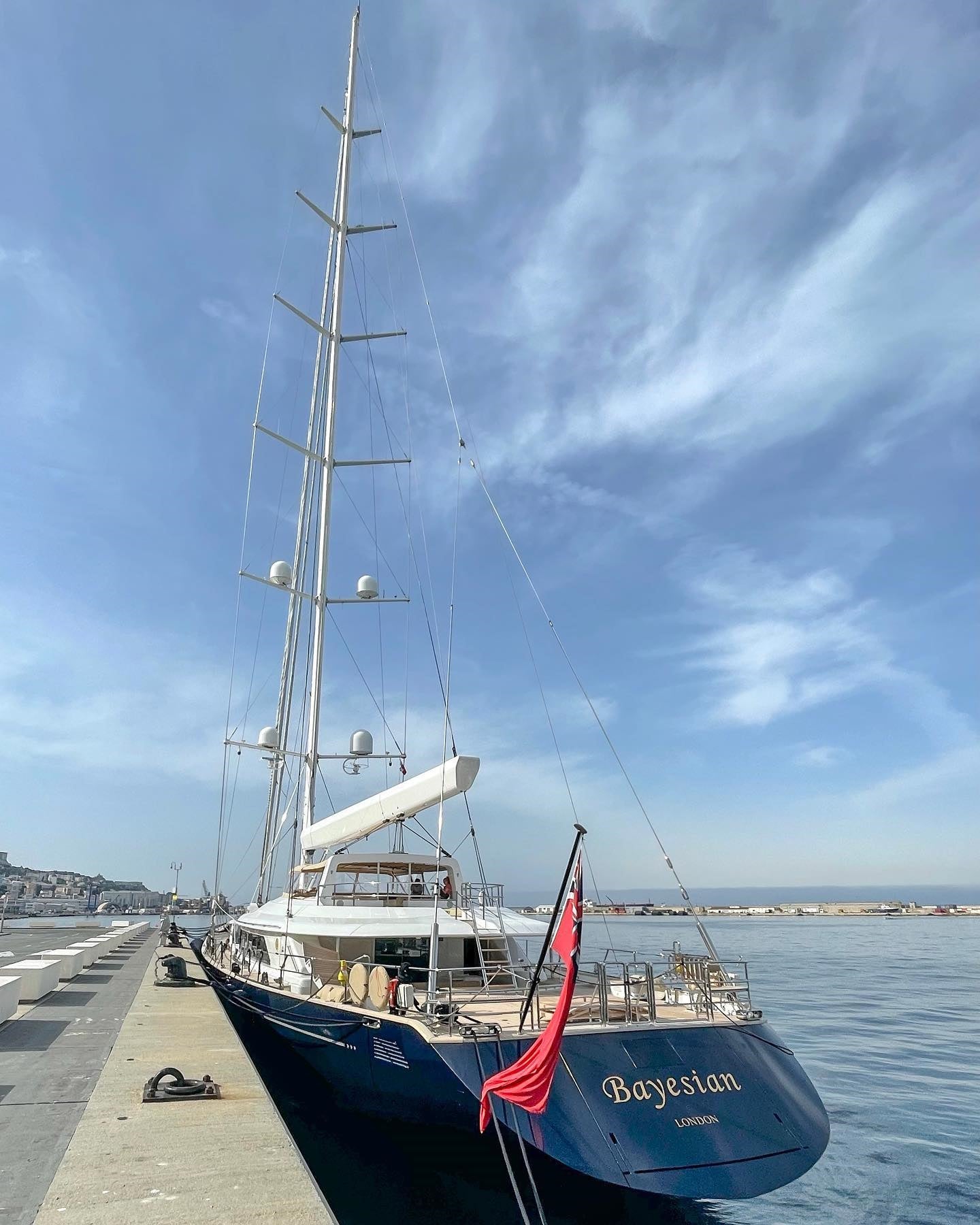
Efforts to enter yacht have been hampered by ‘very confined’ spaces
Efforts to locate the missing people have been hampered by “very confined” spaces inside the wreck, fire department spokesman Luca Cari has said.
The Italian coast guard said it was using a remotely operated vehicle to inspect the seabed and take underwater pictures.
An upgraded underwater drone has also been deployed at the site of the wreckage.
Floorplan of sunken yacht shows guest cabins
A floorplan of the sunken Bayesian yacht shows that a number of guest cabins were situated in the middle of the boar, between the technical area and crew area.
Specialist divers are now trying to access the area, to explore whether the six missing tourists became trapped inside.
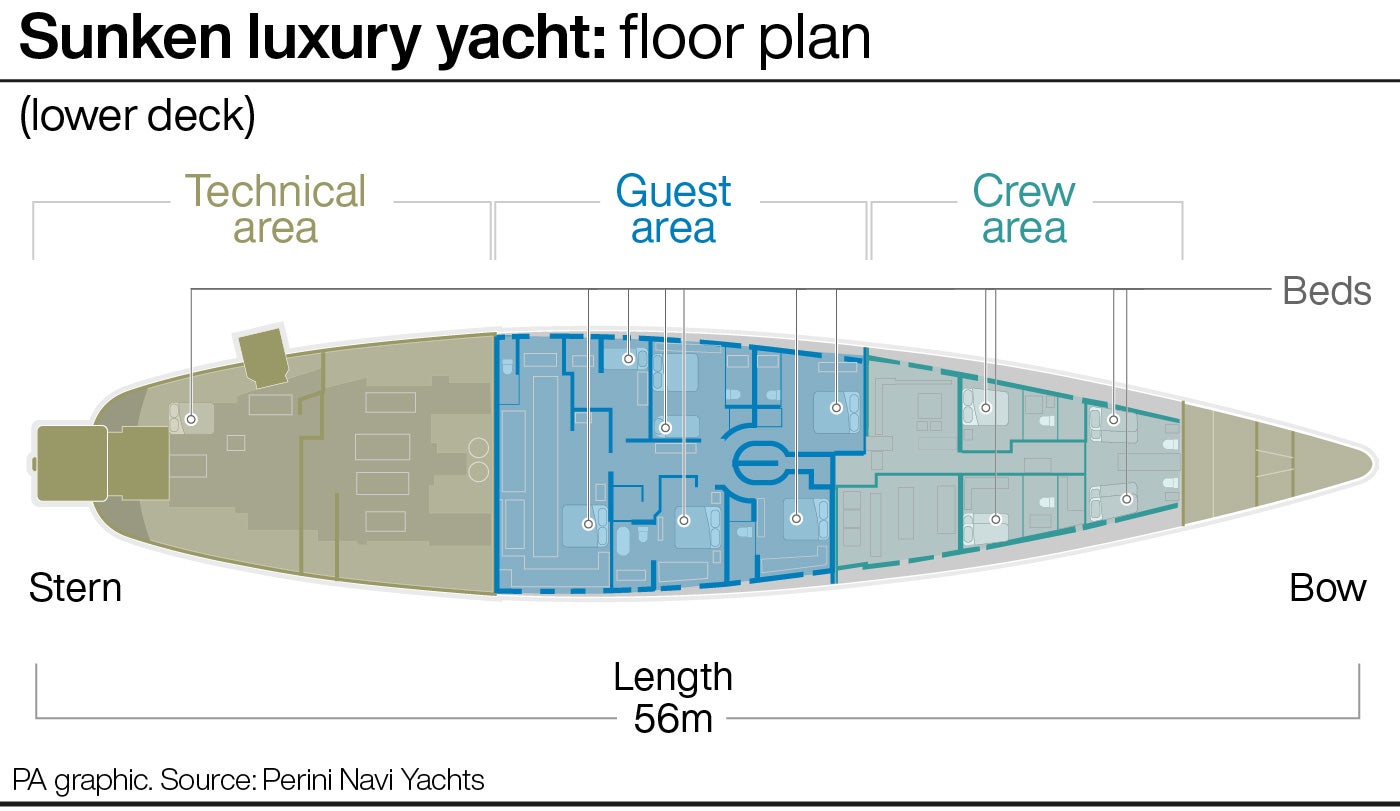
How sailors can use air pockets to survive in capsized boats for days

The amazing rescue of Tony Bullimore inspired the country
Firefighters release footage of search
Italy’s fire and rescue service has released footage of its late night search.
Vigili del Fuoco wrote that Italian divers “concluded late yesterday evening and at the first light of day the operations at sea resumed.”
They added: “The search for the six missing people continues.”
In pictures: Rescue teams continue search for third day
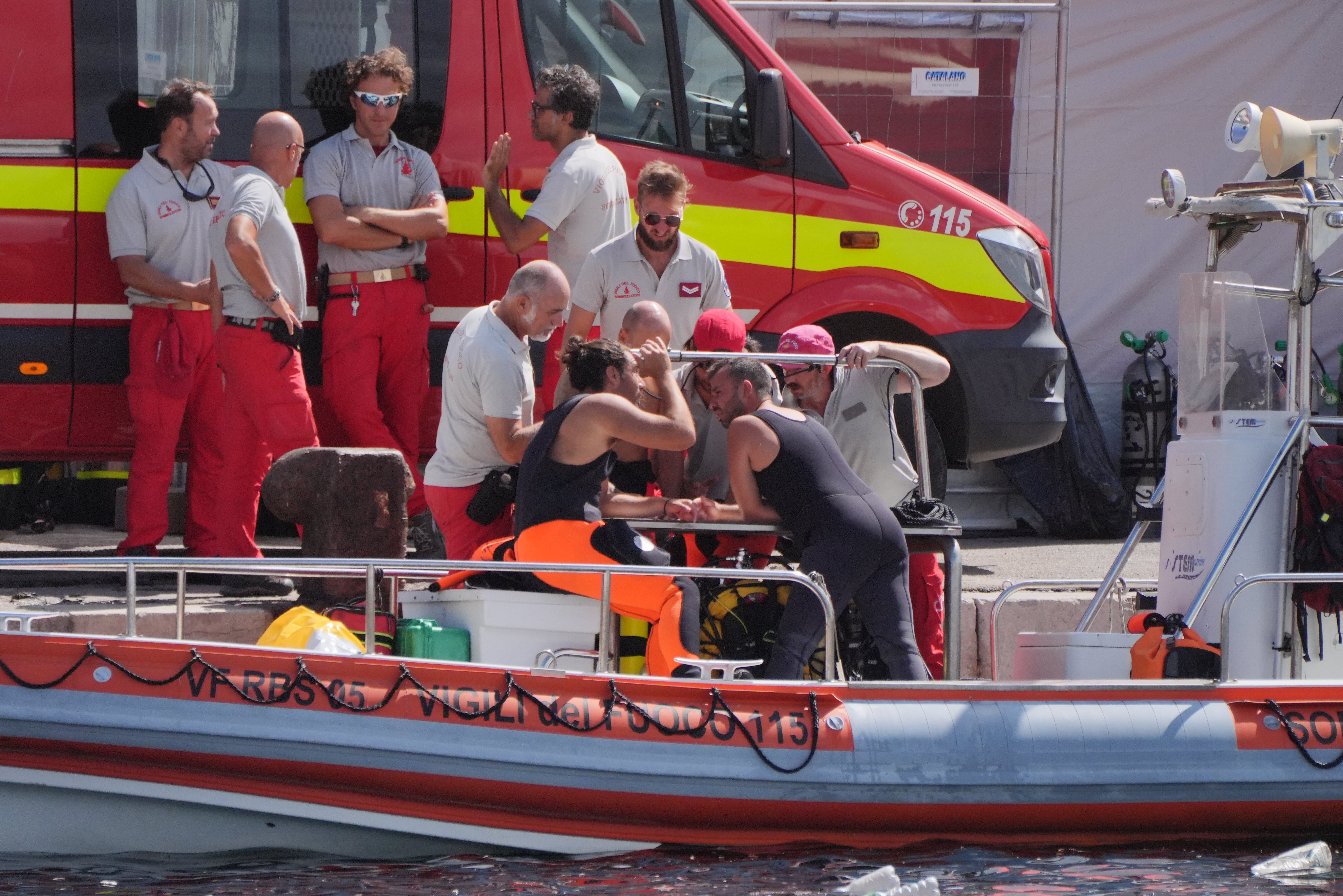
Italian Coastguard says six missing tourists are feared dead
Vincenzo Zagarola, of the Italian Coastguard, said the six missing tourists are feared dead.
Asked about the likelihood of them being alive, he said: “Never say never, but reasonably the answer should be not.”
He said: “We think they are still inside the boat, that is our very hard idea.
“Of course, we do not exclude that they are not inside the boat, but we know the boat sank quickly.
“We suppose that the six people missing may not have had time to get out of the boat.”
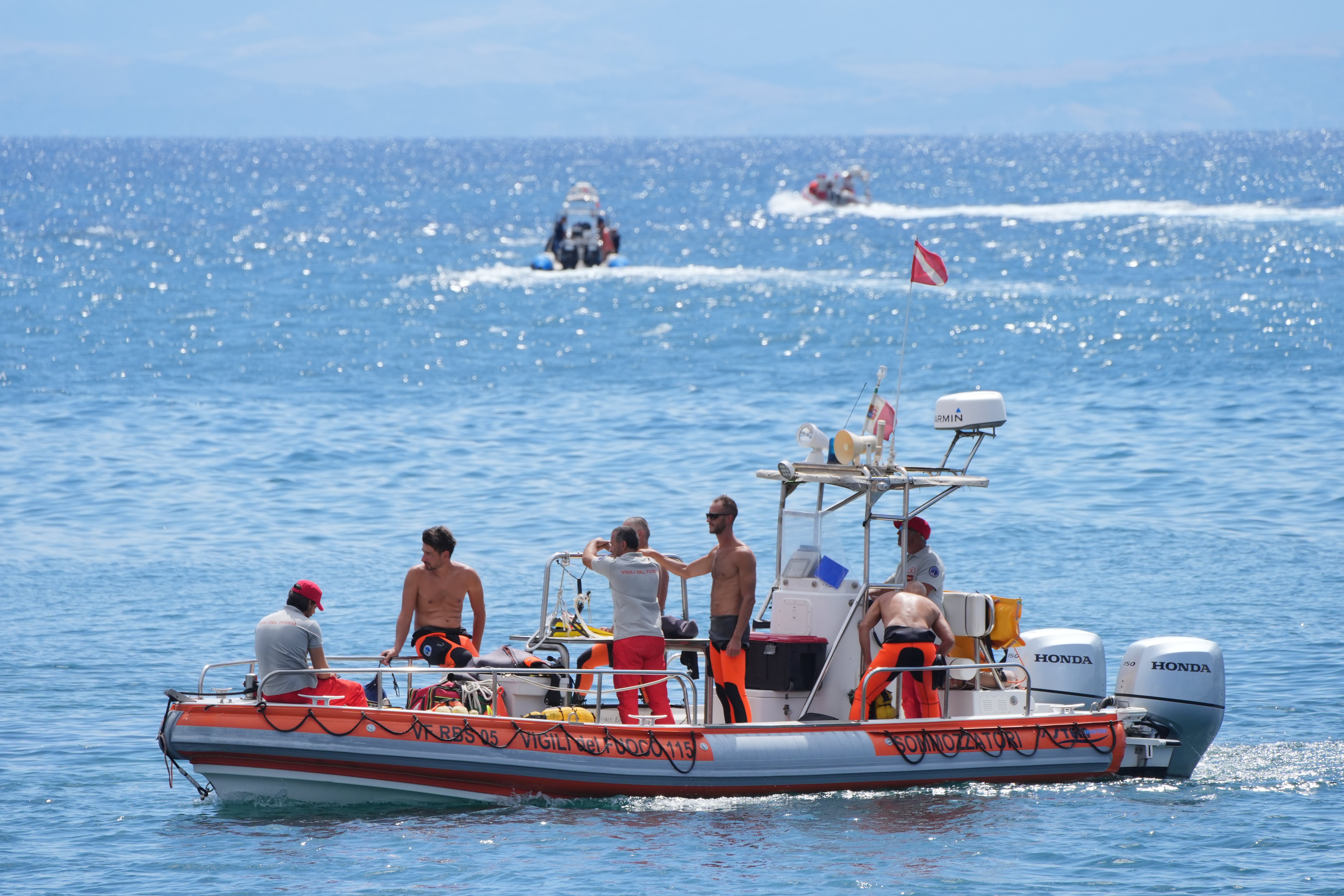
Sailors warned as experts say the Mediterranean is only going to become more deadly
The tragic shipwreck of a luxury yacht moored off the coast of Sicily is the latest sign that the Mediterranean is becoming a more dangerous sea to sail in, those who know the waters best have said
One man died and six people are still missing, including British tech entrepreneur Mike Lynch , after the Bayesian, a 56-metre-long (184-ft) sailboat, was hit by a ferocious storm on Monday, sinking in a matter of minutes.
The coast guard said bad weather had been forecast, but added that it was more virulent than expected. Some locals spoke of a waterspout, or sea whirlwind, of exceptional force. “It was a strange thing,” fisherman Andrea Carini told Reuters. The Bayesian was at anchor, its sails down, when the tempest hit, with another yacht moored nearby.
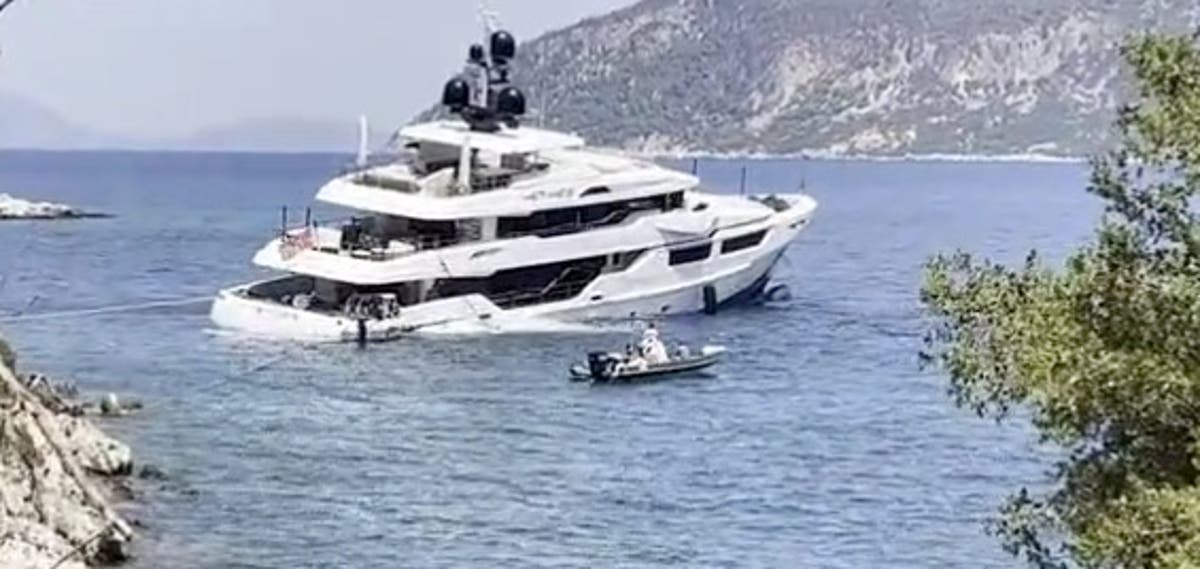
Sailors have said there are certain arease they wouldn’t navigate
Join our commenting forum
Join thought-provoking conversations, follow other Independent readers and see their replies
Subscribe to Independent Premium to bookmark this article
Want to bookmark your favourite articles and stories to read or reference later? Start your Independent Premium subscription today.
New to The Independent?
Or if you would prefer:
Hi {{indy.fullName}}
- My Independent Premium
- Account details
- Help centre

5 Best Liveaboard Bluewater Sailboats

Last Updated by
Daniel Wade
December 28, 2023
Liveaboard bluewater sailboats are both comfortable to live on and capable of making long, offshore ocean voyages.
The best liveaboard bluewater sailboats must strike a balance between comfort and seakeeping abilities. These boats are generally heavy and stable and roomy enough to spend time in. They must also include the necessary hardware to make cooking, sleeping, and bathing possible in choppy conditions.
Table of contents
Bluewater Liveaboard Sailboat Design
What makes a good bluewater liveaboard sailboat , and how is it different from a coastal cruiser? There are a few aspects of purpose-built bluewater sailboats that make them different from most production vessels. The first and (possibly) most important is the hull design.
The classic bluewater sailboat hull shape features a long, deep, full keel. The keel acts as a hydroplane and keeps the boat stable on course in all sea conditions. Deep keel sailboats aren't the only kind of bluewater-capable vessels, but they're a tried and tested design.
Other vessels gain stability from having a wide beam. Beamy sailboats are far more comfortable in rolling seas, as they tend to buffett and pitch much less than leaner, narrow boats. Most ideal liveaboard bluewater sailboats balance length and beam carefully to make the most of the space and hull shape.
Space is another important quality to consider when choosing the best bluewater liveaboard sailboat. Interior space comes first, as living quarters are a key element of comfort.
Cockpit space should also be considered, especially if more than one person comes aboard. Most liveaboard bluewater sailboats sacrifice cockpit space for cabin space.
A comfortable liveaboard sailboat should include several amenities, including a head (toilet), a shower, two sinks, a galley with a stove, an icebox, a place to eat, and a place to sleep. Ideally, the dining area is separate from the primary sleeping area.
A separate chart table is ideal as well because it keeps food and clutter away from important navigational equipment. A chart table is less important on liveaboard sailboats that spend the majority of their time docked. That said, the chart table functions well as a spot for a microwave, toaster oven, or TV when you're not underway.
A separate forward V-berth, known as a master cabin, is a big plus on liveaboard boats. Separating the sleeping area from the rest of the cabin can increase comfort and coziness.
However, on a bluewater sailboat, a side berth near the hatch is essential as well. This is because you may need to quickly take control of the vessel after waking up, and it's best to sleep close to the helm.
Power and Water
Power and water shouldn't be overlooked when choosing a bluewater liveaboard. Many liveaboards spend most of their time docked and hooked up to shore power, water, and sewage. But bluewater liveaboards are designed for cruising, which means everything must be self-contained.
The best bluewater sailboats have sufficient freshwater storage tanks for several weeks on the water. Some have desalination (water maker) machines, which require electricity to run.
Solar panels are an excellent option for power generation, and they can be installed on almost any sailboat.
But all bluewater sailboats should have battery banks and a gasoline or diesel generator built into the system. On many vessels, the inboard engine also functions as a generator.
Safety is an essential factor to consider when choosing a cruising sailboat , especially if it doubles as your primary residence. Basic safety equipment such as bilge pumps and radios should be maintained and tested regularly. Backups and spare parts should also be kept aboard.
Other safety features, such as watertight hatches, can keep your cabin safe and dry during inclement weather. Self-draining cockpits are helpful when sailing offshore, as spray and waves drain from the exposed cockpit without the use of electric or mechanical pumps. If the drain ports are kept clean, no bailing is ever necessary.
Radar is another useful safety feature that, while not mandatory, can keep you in-the-know and alert you to the presence of nearby ships. Radar is especially useful at night, as the automatic alarms can wake you whenever a potential obstacle appears nearby.
Bluewater Sailboats for Living Aboard and Cruising
Living aboard a sailboat is one of the most interesting and rewarding lifestyles available today. It's even more alluring when you can sail your vessel across oceans, which is what bluewater sailboats are designed to do.
A liveaboard cruising sailboat combines comfort, seakeeping ability, and ease of handling in a compact and thoughtfully-designed package. Here are the best liveaboard sailboats for bluewater cruising.
1. Pacific Seacraft Flicka 20
{{boat-info="/boats/pacific-seacraft-flicka-20"}}
The Flicka 20 is the smallest and most interesting sailboat on our list. At only 20 feet overall in length, the interior accommodations of this vessel are spartan at best and suitable for minimalist living.
What makes the Flicka 20 stand out is its exceptional bluewater performance. This sailboat is truly an ultracompact pocket cruiser. With a full ballast keel, self-draining cockpit, and wide beam, the Flicka 20 is more capable offshore than some boats almost twice its size.
This sailboat has the profile of a traditional keel cruiser. From a distance, it would be easy to mistake for a much larger vessel. Its hull shape, manageable Bermuda rig, and small size make it a perfect starter sailboat for single handed offshore cruising.
Inside, you have (almost) everything you need to live comfortably, albeit in a minimalist way. The cabin features standing headroom throughout, which is highly unusual for a 20-foot sailboat. On the port side, you're greeted with a small but functional galley. On the starboard side, there's a small head with a toilet and a shower.
The Flicka 20 displaces a hardy 5,500 lbs. Due to its large keel, there's no centerboard trunk to obstruct interior space. A V-berth upfront makes up the sleeping accommodations, and some models feature settees on both sides with a pop-up dining and chart table in between.
The Pacific Seacraft Flicka 20 has achieved somewhat of a cult status amongst bluewater sailboat enthusiasts. Only about 400 were built, so purchasing a Flicka 20 is somewhat of a rare and expensive proposition. That said, the benefits of owning a 20-foot bluewater liveaboard sailboat are hard to beat.
Cheap slip fees, low maintenance costs, and simplicity are the major selling points of this vessel. It's trailerable behind most heavy-duty pickup trucks and technically small enough to store on the street or in a driveway.
2. Pacific Seacraft Allegra 24
{{boat-info="/boats/pacific-seacraft-allegra-24"}}
If the Flicka 20 is too small for your taste, try the Pacific Seacraft Allegra 24. It follows the same design principles of the Flicka 20, but with four feet of additional space for cabin amenities and seaworthiness.
Four feet may not sound like a lot, but it makes a world of difference on a sailboat. The additional space on the Allegra 24 adds room to the head, extends the port and starboard settees, and increases the size of the galley.
If you like the idea of a small, semi-trailerable offshore sailboat with liveaboard amenities, you'll love the Allegra 24. This stout sailboat has almost miraculous handling and seakeeping qualities while retaining the benefits of small overall size.
With the Allegra 24, you'll be able to make virtually any offshore passage and save on slip fees, maintenance costs, and overall labor. This vessel is easy to sail single handed and large enough for a minimalistic couple to live, eat, and sleep comfortably.
The Pacific Seacraft Allegra 24 is not ideal for people who need space for pets, children, or guests, as the interior is quite small when compared to other sailboats. That said, there's enough room for an occasional passenger, and the cockpit is comfortable enough for four adults to sit and interact.
3. O'Day 28
{{boat-info="/boats/oday-28"}}
The O'Day 28 is a popular sailboat that makes a great liveaboard cruising platform. This affordable vessel was produced between 1978 and 1986, and over 500 examples were produced over the years.
All in all, the O'Day 28 is a stout cruising sailboat that's suitable for offshore and coastal sailing. It features a raked stern and hidden rudder, and a helm that's similar to what you'd find on much larger boats.
The O'Day has a large fuel tank for its inboard engine and an even larger 25-gallon freshwater capacity, which is excellent for offshore cruising. Additional tanks can be added in storage spaces, making the O'Day 28 suitable for long voyages.
The cabin of the O'Day 28 is spacious and includes everything you'd need to live aboard comfortably, along with plenty of storage space throughout. The wide beam of the O'Day 28 gives it lots of space, so the cabin doesn't feel cramped for its size.
Two models of the O'Day 28 were built; one featured a swing keel, and the other had a fixed swing keel. The swing keel model is ideal for coastal cruising and shallow-water sailing, while the fixed keel O'Day 28 is more suited for bluewater cruising.
That said, both keel variants make fine offshore sailboats. The cabin of the O'Day 28 features a large galley with a stove and icebox, two large settee berths, a large center table ahead, and a V-berth forward. The head serves as a separator to the forward cabin, giving the V-berth an extra layer of privacy.
4. William Atkin "Eric" 32
{{boat-info="/boats/atkin-co-eric-32"}}
"Eric," designed in the 1920s by famous marine architect William Atkin, is a radical departure from typical modern liveaboard sailboats. However, as a bluewater liveaboard sailboat, this vessel likely outshines all the others on this list in almost every conceivable way.
Eric is a 32-foot traditional wooden ketch. This planked full- keel sailboat displaces over 19,000 lbs and has a draft of about five feet. The basic design of the hull is based on early Norweigian fishing boats, which were known for their resilience in rough North Sea storms.
Eric is a traditional gaff-rigged vessel with two short masts and a long bowsprit. Though complex to rig, it sails beautifully in all weather conditions. One of the earliest examples built survived a hurricane offshore in the 1930s, and subsequent models have completed numerous long-range ocean voyages.
Eric is a purpose-built long-range ocean cruiser. Interior accommodations are spacious and designed for comfort and utility. Unlike most sailboats of the time, Eric features a full head with shower, a 'master cabin' style V-berth forward, a full galley with an icebox, and standing headroom throughout.
William Atkin's Eric is, by all definitions, an ocean-crossing sailboat designed to take between one and four adults just about as far as they want to go. It has all the qualities of an oceangoing sailboat in a compact package, along with excellent seakeeping characteristics.
The primary drawback of this 32-foot Atkin sailboat is maintenance. Most of these hulls were constructed using traditional oak planking, which lasts forever if taken care of but requires skilled maintenance. The planks are caulked using cotton wadding, and they'll need recaulking if the boat stays out of the water for too long and "dries up."
If you're looking for a beautiful and historic liveaboard sailboat with serious offshore cruising capabilities, consider an Atkin Eric 32. Although somewhat rare, examples of this design occasionally pop up for sale on the used market.
5. Pearson 35
{{boat-info="/boats/oday-28"}}, {{boat-info="/boats/pearson-35"}}
The Pearson 35 crosses the rubicon into the 'big boat' category, as it has everything you'd expect of a large oceangoing sailboat. The vessel also has a unique displacement keel with an additional swing keel at the base.
The Pearson 35 is a roomy sailboat with excellent seakeeping abilities and a large sail plan. It's a typical Bermuda-rigged sloop with a tall mast and the usual sheet and halyard arrangement. As a result, it's fun to sail and easy to handle. It's also a fast boat, making it ideal for longer voyages.
The swing keel certainly doesn't make the Pearson 35 a shoal-draft sailboat. It has a modified full keel which (with the swing keel retracted) draws 3 feet 9 inches. With the additional swing keel down, the draft of the Pearson 35 increases to over 7 feet.
The Pearson 35 is a heavy boat with good sea keeping abilities. It was introduced in 1968, and over 500 units were produced. That makes it one of the more popular sailboats in its class, and plenty of Pearson 35s are still sailing around the United States.
Down below in the cabin, the Pearson 35 is roomy and comfortable. It features a full galley, an enclosed head with a shower and sink, and several berthing areas, including a forward V-berth. Plenty of storage is available throughout the cabin, making the Pearson 35 an excellent choice for living aboard.
There's something empowering about piloting a 35-foot sailboat through rough weather. The size of the boat provides both safety and a sense of security, which can help you keep a clear head during stressful situations at sea. The vessel is beamy as well, making it less likely to heel aggressively and increasing roll comfort in dicey seas.
Overall, the Pearson 35 is an excellent choice for a liveaboard bluewater sailboat. It's a large boat in comparison to the others on this list, and it's known for easy handling and excellent windward performance. The Pearson 35 is a common sailboat that's widely available on the used market.
Related Articles
I've personally had thousands of questions about sailing and sailboats over the years. As I learn and experience sailing, and the community, I share the answers that work and make sense to me, here on Life of Sailing.
by this author
Best Sailboats
Most Recent

What Does "Sailing By The Lee" Mean?
October 3, 2023

The Best Sailing Schools And Programs: Reviews & Ratings
September 26, 2023
Important Legal Info
Lifeofsailing.com is a participant in the Amazon Services LLC Associates Program, an affiliate advertising program designed to provide a means for sites to earn advertising fees by advertising and linking to Amazon. This site also participates in other affiliate programs and is compensated for referring traffic and business to these companies.
Similar Posts

Affordable Sailboats You Can Build at Home
September 13, 2023

Best Small Sailboats With Standing Headroom

Best Bluewater Sailboats Under $50K
Popular posts.

Best Liveaboard Catamaran Sailboats

Can a Novice Sail Around the World?
Elizabeth O'Malley
June 15, 2022

4 Best Electric Outboard Motors

How Long Did It Take The Vikings To Sail To England?

10 Best Sailboat Brands (And Why)
December 20, 2023

7 Best Places To Liveaboard A Sailboat
Get the best sailing content.
Top Rated Posts
Lifeofsailing.com is a participant in the Amazon Services LLC Associates Program, an affiliate advertising program designed to provide a means for sites to earn advertising fees by advertising and linking to Amazon. This site also participates in other affiliate programs and is compensated for referring traffic and business to these companies. (866) 342-SAIL
© 2024 Life of Sailing Email: [email protected] Address: 11816 Inwood Rd #3024 Dallas, TX 75244 Disclaimer Privacy Policy

IMAGES
COMMENTS
Living aboard a sailboat can be a rewarding and life-changing experience. Many live aboard for adventure, and others choose to live a more laid-back lifestyle and reduce their living expenses. Regardless of your reasoning, it's important to consider the realities of living aboard and the sacrifices you'll have to make. ...
One philosophy in getting started living aboard a sailboat is to start small, start now. That doesn't mean you have to buy a major refit project of a sailboat. You can get started in a small 24 foot single cabin boat for less than $10,000 or a mid-size 36 foot sailboat (see video below) for less than $60,000. Or grab a 1980s fixer upper that ...
Watching the sunset every day is one of the best things about sailboat living. Then there's the sunrises and sunsets, and the endless starlit skies. The thunderstorms that you're suddenly a part of, when before you could hide inside brick walls. The constantly changing sea and sky, and the sun and wind.
Living aboard a sailboat is an exciting lifestyle choice, but there are lots of considerations you'll need to make. First and foremost, you have to pick a boat to live in. Unless you plan on sleeping under a canvas tarp, it's essential to find a sailboat with a proper cabin. Cabin sailboats became common in the United States during the early 20th century, but size and amenities vary ...
Learn what to expect and how to prepare for living on a boat full-time. Find out the factors to consider, the essentials to have, the skills to master, the costs to budget and the safety tips for this alternative lifestyle.
Coastal Cruiser Under 35 — Catalina 34/35. If you want to move aboard, you're on a budget, and you want the most space you can get, it's really hard to beat an older Catalina. Starting with the Catalina 30, these beamy boats have a surprising interior volume. They make great first liveaboards.
Living on a sailboat full-time is often romanticized as a life of endless sunsets, gentle waves, and freedom on the open sea. Many dream of casting off the lines and setting sail for a horizon of adventure and tranquility. However, the reality of life aboard a sailboat can be as challenging as it is rewarding, as frustrating as it is relaxing ...
One parting thought: Living on a boat full time and traveling is like having three or four full-time jobs. Each requires 30-40 hours per week when you include labor, research, and thinking and planning. Boat ownership — basic maintenance and cleaning. Cruising full-time — destination and route planning, weather study.
What is the best kind of live aboard boat? Like buying a house or renting an apartment, personal taste weighs heavy when choosing a boat. People sail around the world and live on vessels as small as 24 feet (7.3 M) and as large as hundreds of feet. Essentially, as long as the vessel is seaworthy, it is possible.
Choosing a boat to live on is a big deal — something you definitely want to get right. There are plenty of options to pick from, which can make the choosing process a bit daunting. So to help you navigate those deep waters (no pun intended), here is an article summarizing the 13 best liveaboard sailboats under 30 and 50 feet.
Sample Liveaboard Budget. Now that we've covered the basic expenses to expect when living aboard, we'll put together a sample liveaboard budget. The figures are based on someone making a monthly income of $4,000 docking a 30-foot sailboat at a reasonably priced marina. Monthly Expense.
Liveaboard sailboats that are cheap but actually good include Westsail 32, Alberg 30, Tayana 37, Catalina 30, Ericson 35, Albin Vega 27, Bristol 32, Morgan 323, Contessa 32, Pearson 365, Hunter 31, Cal 34, and Tartan 30. The prices of these boats range from $5,000 to $50,000 or more. Living aboard a sailboat on a budget doesn't mean you have to ...
Here's some expenses you may incur by living on your boat: Boat mortgage payment. Slip fees. Boat insurance. Waste management. Gas. Food and water. The best way to manage expenses is by making a budget and sticking to it. Depending on the size and value of the vessel, boat insurance may be just as expensive as house insurance.
If you plan on living aboard a boat for a long time, you will need some form of reliable electric lighting. 6. Availability of 120V AC. The best liveaboard sailboats come with 120V AC outlets for standard house electricity connections. The availability of electricity is a definite requirement for living aboard a boat.
Oahu, Hawaii. Hawaii is an awesome spot for sailing and the island of Maui is considered to be one of the best in the U.S. but Oahu island has a lot to offer liveaboard hopefuls. Honolulu may seem like an obvious choice but there are other options elsewhere on the island that offer practical alternatives.
The thought of living aboard a boat sounds lovely, romantic and simple—and indeed it can be. But if you're thinking about making a move from land to a boat, you need to consider a few things. If you don't already own a boat, you'll need to buy one, and even if you do have one, you may look at it in a different light and decide, "We ...
Living on a boat isn't any more or less safe than living in a traditional residence, it's just that your concerns might be different. ... Some of the best places to live aboard a boat include: Chesapeake Bay, Maryland. Its warm climate and friendly boaters make it a wonderfully calm place to live. They've also got some of the best premier ...
The Italian Coast Guard said it is searching for six people, including Americans, who were aboard a luxury yacht that sank off the coast of Sicily in a storm. The missing also included a British ...
No liveaboard sailboat list is complete without the Catalina 30. This sailboat is one of the most popular 30-foot sailboats ever built, and it features an exceptional interior layout that's perfect for living aboard. When it comes to size, 30 feet is just about perfect for a single person or a couple living aboard a boat.
Italy Boaters Missing Emergency services at the scene of the search for a missing boat, in Porticello, southern Italy, Tuesday, Aug. 20, 2024. Rescue teams and divers returned to the site of a ...
A life boat is docked at the harbor of Porticello, southern Italy, Tuesday, Aug. 20, 2024. Rescue teams and divers returned to the site of a storm-sunken superyacht Tuesday to search for six ...
Rescuers were on Monday searching for six people missing after a luxury yacht was hit by a tornado and sank off the coast of Sicily, killing one of the 22 people on board.
A boat carrying divers was seen leaving the harbour at around 10.30am local time. 10:22:48 One in a million disaster is 'Shakespearean tragedy', says Mike Lynch's friend
For someone that dont live in 4seasons do you think they can take the coldness? Any advice?. Will be theee just for 2 nights in feb. Murmansk. Murmansk Tourism Murmansk Hotels Murmansk Bed and Breakfast Murmansk Vacation Rentals Flights to Murmansk Murmansk Restaurants Things to Do in Murmansk
The Bayesian sailing boat had 22 people on board, including technology tycoon Mike Lynch, when it sank in the early hours of Monday Barney Davis 21 August 2024 08:30 Newer 1 / 6 Older
See all. Sign in to get trip updates and message other travellers. to get trip updates and message other travellers.
Here are the best liveaboard sailboats for bluewater cruising. 1. Pacific Seacraft Flicka 20. cdmech. The Flicka 20 is the smallest and most interesting sailboat on our list. At only 20 feet overall in length, the interior accommodations of this vessel are spartan at best and suitable for minimalist living.
A sightseeing walking route through the largest city above the Arctic Circle. 12 hours 27 km 7 objects. Murmansk is known as 'the gate to the Arctic' for a reason. It not only hosts strategic facilities of the Northern Fleet but also many points of interest for tourists. Not long ago, the capital of the Russian Arctic celebrated its centenary.
Set sail on your destination's top-rated boat tours and cruises. Whether it's an entertaining and informative boat tour or a relaxing sunset dinner cruise, these are the best Murmansk Oblast cruises around. Looking for something more adventurous? Check out our list of must-do water activities in Murmansk Oblast. See reviews and photos of boat tours & water sports in Murmansk Oblast on Tripadvisor.